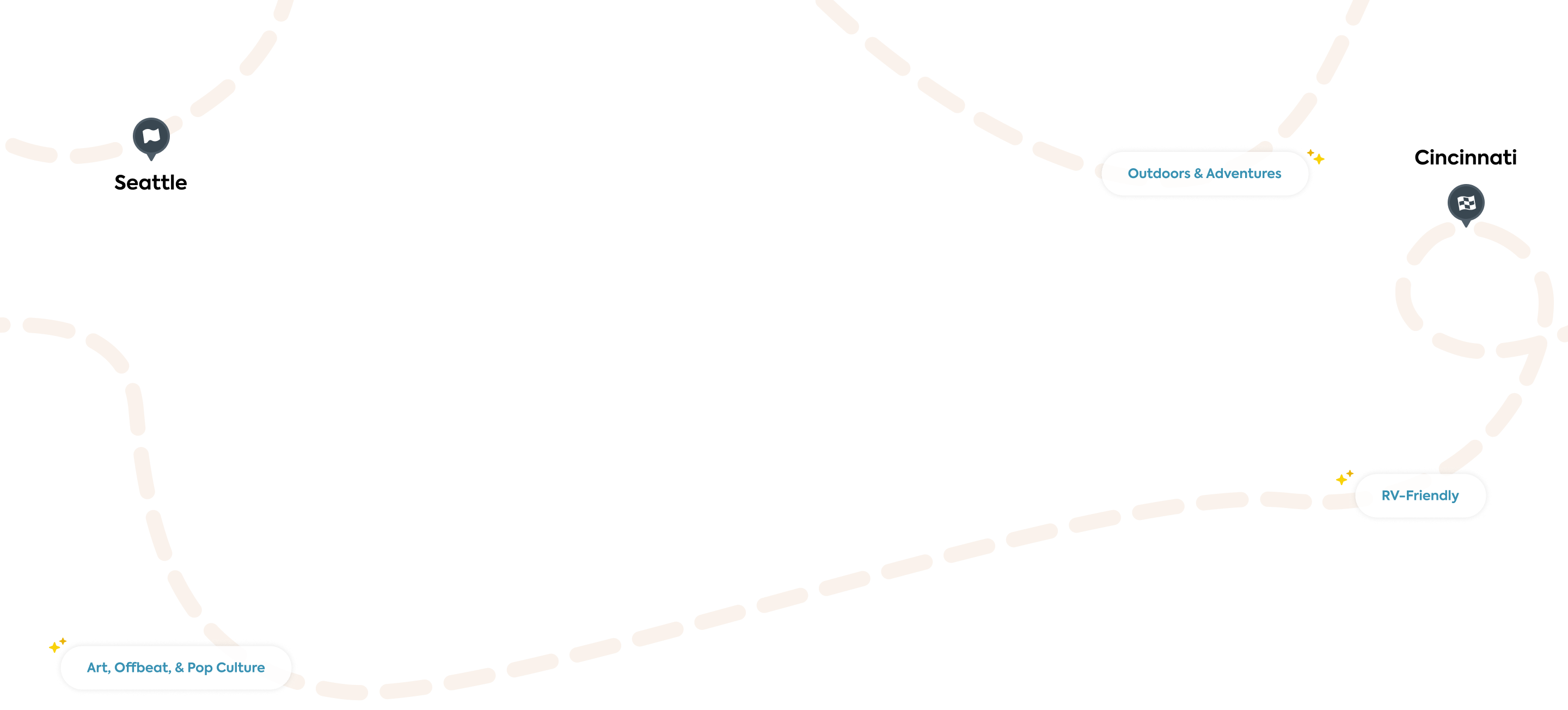

Let us plan your trip for you
Roadtrippers Autopilot™ creates your itinerary based on what we’ve learned from over 38 million trips. You’re never more than a few clicks away from your next great adventure.

- Auto Travel

Let Autopilot take the wheel planning your next road trip, scenic drive, RV journey and everything in between. Then enjoy the ride while uncovering hidden gems along the way.
Get real-time traffic updates and access to wildfire smoke maps to stay informed and connected throughout your journey.
Collaborate
Share your itinerary with your copilots so they can help with the finishing touches.
Let Roadtrippers be your guide, navigating the twists and turns as you roam the open roads with confidence and ease.

Exclusive Access To Autopilot
Let us do the planning for you! Enter in a few key details and we’ll craft a custom tailored trip just for you.
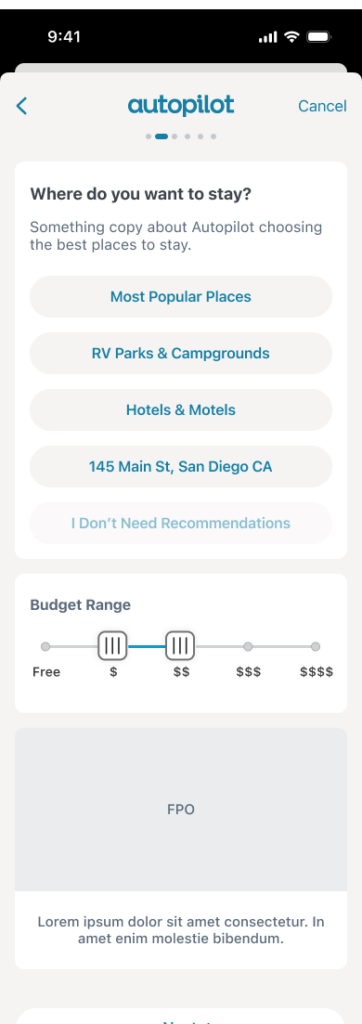
Choose the right plan for you—and try it free for 7 days
Premium planning.

RV-Friendly Tools

Overnight RV Parking

Start free for 7 days
Then $35.99 (that's only $2.99/month), then $49.99 (that's only $4.17/month), then $59.99 (that's only $4.99/month).
† RV-Friendly routing features (including routing warnings for vehicle hazards and propane restrictions) are available in the U.S. only.
Free 7-day trial
Test drive the best features of Roadtrippers Premium for free! Eligible users will get exclusive access to all the tools needed to plan the perfect road trip.
Create a Roadtrippers account to start your 7-day free trial.
Already have a Roadtrippers account?
We need your email address
Before we can sign you up for Roadtrippers, we need your email address. Click the button below to go to your profile.
Plan your next adventure with a Roadtrippers Premium account
Due after 7-day free trial
Thank you for signing up for a Roadtrippers Subscription
Get started planning your next trip now!

Good news...you already have Roadtrippers!
Thanks for being one of our most dedicated users.
- Trip guides
- Trip Planner
- Sign up Log in Sign out
- Log in Sign out
- ROADTRIPPERS MEMBERSHIP
- RV RESOURCES
Plan your journey, find amazing places, and take fascinating detours with our app.
We couldn't find an existing Roadtrippers account using that service. Please try signing in with another option or create a new account with Roadpass.
We need your email address to send you trip itineraries and other updates.
- English (UK)
- Español (Latinoamérica)
- Español (España)
An easier trip, each time
Imagine checking one place for your travel details and getting a heads up as things happen throughout your trip. See why life without TripIt is a distant memory for millions of travelers.

You handle the booking, we'll take it from there
Unlike other travel apps, TripIt can organize your travel plans no matter where you book. Simply forward your confirmation emails to [email protected] and in a matter of seconds, TripIt will create a comprehensive itinerary for every trip.
“I’m on the road 100 days a year and TripIt is my go-to-app. It’s such a powerful tool in the hands of a traveler. There’s simply nothing like it on the planet.”
Helpful reminders and alerts so you don't miss a beat
Packed with features that give you a leg up on changes and help you make the most of all your trips, TripIt Pro is where the magic happens.
“I love knowing exactly when my flights are, when they are delayed, what gate to leave from, and all the other amazing TripIt Pro features.”
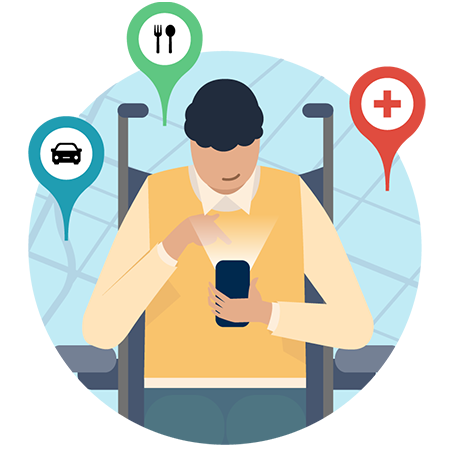
Know where to be and when
Need a reminder when it's time to leave for the airport? Not sure where to eat in the airport or near your hotel? TripIt has you covered.
“My favorite business travel app so far is TripIt. Carrying all of my itineraries, it saves me during my ‘Where am I, what do I do next?’ panic attacks.”
More from our blog
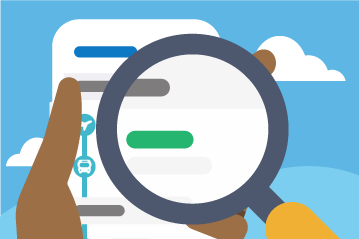
Take a closer look
Experience what it's like to travel with the TripIt app.
As featured on
Try the travel app that keeps up with you.
So many trips, so little time. Let TripIt worry about the details, so you don't have to.
Top International Flight Routes .
Cheap flights, hotels , rental cars and travel deals:
KAYAK searches hundreds of other travel sites at once to find the best deals on airline tickets, cheap hotels, cheap cruises, vacations and rental cars.
Not what you’re looking for? Find thousands of other hotels , flights , car rentals and package deals with KAYAK.
Custom travel itinerary in 2 minutes
Over 350,000 itineraries created, how it works.
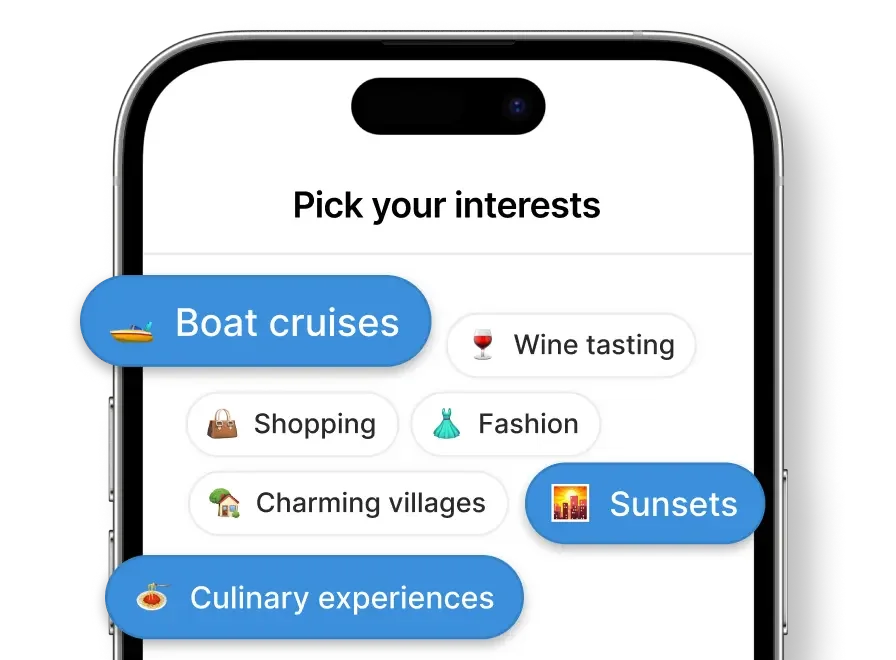
What's included
We're here to help you plan your trip, frequent questions.
Ready to plan that trip?
We've got everything you need to complete your trip plan, so you can relax and enjoy your upcoming travel.
Where are you starting?
Bring your plan together
Organized trip planning.
Update your itinerary without rebuilding your calendar and trip map - everything works together.
Plan with friends & family
Share with others or collaboratively build a trip in real-time with live updates.
Everything in one place
Gather the pieces of your plan: itinerary, budget, & important documents.
Plan That Trip is here to take the hassle out of your trip planning process.
We eliminate the clutter of traditional planning methods by combining various planning aspects into one intuitive interface.
You're in good company
Your ticket to efficient planning, skip the data entry.
Automatically add flights to your trip itinerary from confirmation emails or other documents.
Plan on your terms
Access anywhere, anytime. Download a PDF for convenient offline access, or use our mobile-ready web app.
Kick-start your research
City-level information about locations. Find out average temperatures during your visit, currency, time zone difference, and more.
Budgeting made simple
Easily manage your travel expenses. Track spending, split costs among travelers, and view a comprehensive breakdown of expenses to keep your budget on track.
Your travel documents, organized
Access all your trip-related documents. From tickets to hotel bookings, keep everything in one secure, accessible place. Forward confirmation emails to a synced address, and we'll include them with your trip-planning documents.
How it works
Chart your course.
Plot your destinations and build your itinerary.
Fill in the details
Add your stays and activities.
Organize your documents
Gather all your travel documents and notes in one place.
See your plan come together!
Can i plan trips for free.
Yes! Our free plan offers you everything you need to plan a trip. Trips with itinerary, calendar, and map views are saved for a year. You can also track expenses and attach notes. However, there are no sharing or collaboration tools, and you cannot upload or sync documents from email with the free plan.
Can I share my trip plan?
Absolutely! Plan That Trip allows you to invite friends, family, or colleagues to collaborate on your travel plans. They can view, edit, and add to the itinerary in real-time, ensuring everyone involved has the latest information. Collaboration and sharing require a Premium plan.
How do I add flights?
Plan That Trip lets you add flights in lots of ways. You can specify the destination and arrival location, or flight number and date. With the Premium plan, you can automatically load flights from any document.
Can I track my spending and budget?
You can assign a cost to any part of your itinerary, and we'll tracks all expenses across the entire trip. Cost splitting lets you determine who owes what for various activities and is a good way of keeping tabs on individual expenses. The complete budget view requires a Premium plan.
Is my data secure with Plan That Trip?
We take your data security very seriously. All your information, including personal details and travel documents, is stored securely and is only accessible to you and those you choose to share your itinerary with. We also give you the ability to download your data or delete your account, so you are always in charge.

Want to learn more?
Plan that trip.
- Terms & Conditions
- Privacy Policy
- Attribution
- [email protected]
Plan Your Trip
The perfect adventure.

4 Simple Answers We'll do the rest!
Create and manage your travel itineraries with ai, search tools & while on the go, share with travel buddies & loved ones back home, keep it all in one place: maps, lists, notes, places to visit, eat, sleep & transportation.

4 Simple Answers. We'll do the rest!
Trip plan features, personalized.

Unlock Your Ultimate Travel Experience with Ease

Popular Trips
Ready to plan your next adventure, from dreams to itineraries.

Trip Plan Is Your:
Best road trip planner 2024.
The best road trip planner offering personalized and customized features that cater specifically to road trips. Easily plan your route, discover unique attractions along the way, and find the best accommodations and dining options that fit your preferences. Offline access to your itinerary makes it easy to navigate even in areas with limited internet connectivity.
Best Vacation Planner 2024
The best choice for vacation planning with personalized trip planning capabilities. TripPlan tailors your vacation experience based on your destination, interests, and travel dates. Add or remove attractions, accommodation options, and transportation choices, ensuring that your vacation perfectly aligns with your preferences. Enjoy a stress-free and well-organized vacation.
Best Group Itinerary Planner 2024
For seamless group travel coordination, our app is the top choice as the best group itinerary planner. From collaborative planning and sharing to inviting your travel mates, family, or friends to contribute to the itinerary. Take everyone's preferences into account and keep everyone informed and engaged throughout the planning and travel.

Effortless Trip Planning: Let Us Do the Work, You Enjoy the Ride.

World's Smartest Vacation Planner
Triphobo - trips, tales & trust.
- TripHobo is Incredible 10/06/2021 One of the most useful Travel sites I have come across recently! Fleming S
- User-Friendly 18/01/2020 User-Friendly, very useful for planning trips and looking for places to visit. Nat
- Great travel planning tool for avid travelers 18/12/2019 As an avid traveler, I’ve never been so excited to discover this site. It was like discovering the best tool I had been subconsciously hoping to find. However, one thing that bugs me is the mode of transport assumed between different points. I could easily change it using the option available, but to do it for multiple such points is sort of a pain. But I understand it must be a difficult thing to do correctly for different types of users. Everything else seemed great, but I hope you see this and plan something for your future versions. Good luck. Ashok Ramachandra
- I booked a day trip to Giethoorn from 23/11/2019 I booked a day trip to Giethoorn from Amsterdam through and TripHobo even extended me a discount. The tour company we went with was marvelous and everything went very well. I highly recommend them! Great customer service. Barbara Neu
- Multnomah Falls/ Columbia River George Waterfalls are a MUST see! 30/10/2019 This was a wonderful tour. An easy and comfortable drive out from Portland with an extremely knowledgeable tour guide - Evan, who was very passionate about his home town and surrounding areas. The morning tour was so good that most of the bus stayed on for the city tour in the afternoon also an excellent tour with the same exceptional guide. Thank you for my first Portland adventure. Tam
- Trip Hobo Makes Trip Planning Fun! 25/10/2019 I just found this site when planning my wedding anniversary trip next year. So far, I really like it! It's user-friendly and takes you step-by-step through the trip planning process. I use other trip planning applications, such as TripCase and Tripit and I feel like this site is among the best! I just wish there was a mobile app and then it would be perfect! Melissa Blackson
How TripHobo Helps?
1. Select Your Destination from 1M+ New & popular Tourist Attractions
2. Select Your Accommodation from 1M+ Accommodations around the Globe
3. Check Your Budget with In-Built Trip Budget Calculator in Multiple Currencies
4. Finish Your Itinerary with our Free online Vacation Planner in few minutes
Most Popular Destinations

Popular Travel Itineraries

Nomadic Matt's Travel Site
Travel Better, Cheaper, Longer
16 Easy Steps for Planning Your Next Trip
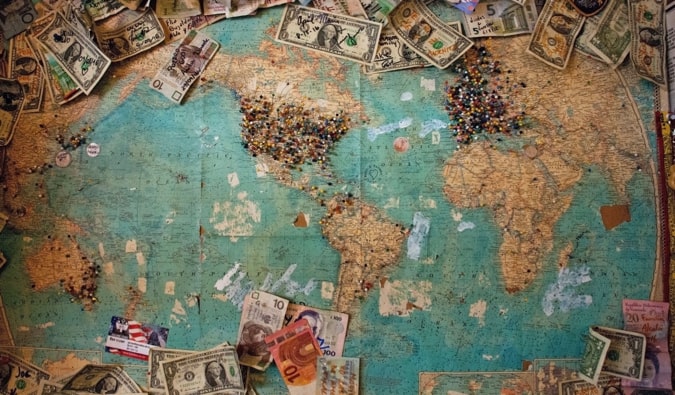
I remember when I started planning my first trip around the world. I had no idea what I was doing.
When I decided to quit my job and travel the world , I walked into a bookstore and bought Lonely Planet’s Southeast Asia on Shoestring . Buying that guidebook was my first step toward long-term travel. It made the trip seem more real, more tangible. It made it all seem possible.
While helpful, the book didn’t exactly prepare me for planning a trip around the world. Back then, there weren’t really travel blogs, sharing economy websites, and apps like there are today. I was excited and determined — but I was lost. I had to figure it out as I went, hoping I didn’t miss anything important.
Trip planning can be a daunting task. Where do you begin? What’s step one? What’s step two? What’s step three?
It’s easy to get overwhelmed, especially when you haven’t done something like this before — and especially considering just how much information there is out there these days. Blogs, social media, and guidebooks have never been more plentiful. There’s a firehose of information out there that can sometimes make the task of planning a trip even more challenging and overwhelming.
After a decade of traveling the world , I’ve planned countless trips and vacations for myself, friends, family, and even group tours. In the beginning, it was trial by fire and I learned a lot of lessons the hard way . However, that helped me develop an efficient checklist that ensures I don’t miss anything important during the trip planning process.
After all, I don’t want to get to my next destination and then realize I forgot something. And neither do you!
There is a lot of information on this website ( and even more information packed into my book ), but one question that comes up frequently is, “Matt, how do I put this all together? How do I plan a trip?”
In a continuing effort to help you get out the door and into the world, I’ve created this step-by-step guide on how to plan a trip. It works for any kind of trip — no matter how long you’re going for! Just follow this checklist and you’ll be off in no time!
Table of Contents
Step 1: Decide Where You Want To Go
Step 2: decide the length of your trip, step 3: research your costs, step 4: start saving money, step 5: get a travels rewards credit card, step 6: switch to no-fee atm cards, step 7: stay focused and inspired, step 8: check for last-minute deals, step 9: book your flight, step 10: book your accommodation, step 11: plan your activities, step 12: sell your stuff, step 13: automate your bills, step 14: pack, step 15: buy travel insurance, step 16: enjoy your trip.
If you want to jump ahead, simply click on any of the links above.
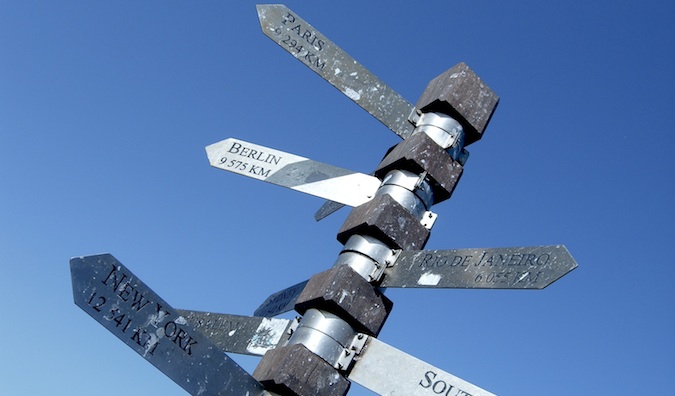
It’s a lot easier to mentally get behind “I am going to Paris in the summer” than “I’m going to Europe” or “I’m going somewhere.” Not only will your trip become more concrete for you and easier to commit to, but it will make planning easier as well…because you know what to work towards. Get specific with your plans. Get detailed. The more focused and concrete your goal, the easier it will be to actually reach it.
Resources for picking your travel destination:
- 200+ In-Depth Destination Guides
- 10 Destinations Under $50 Per Day
- The 10 Best Places to Visit as a Budget Traveler
- The 20 Best Tropical Islands in the World
How much does it cost to travel? That depends!
Without knowing how long you’re going away for, I can’t answer that question. And it’s a question you need to answer so you can start planning!
In order to figure out how much you need to save you’ll need to know how long your trip will be.
Are you going away for a week? A month? A year?
The length of your trip is a huge factor in determining how much money you need. Spend some time mulling that over until you have your answer.
For example, after you say “I’m going to Paris this summer,” add “for X days.” That way you can start to narrow down just how much money you’re going to need to save. “I am going to Paris for 10 days” is a trip that you can plan for. It’s an attainable goal.
So you know where you’re going and how long you’ll be there, but to really nail down how much money you need, your next task is to research the costs in your destination at the style of travel you want.
Do you want to backpack, or would you rather stay in luxury hotels?
How much are hostels, hotels, restaurants, and attractions?
Knowing will allow you to estimate how much money you’ll need for your trip. Here is how to research costs:
- Buy a guidebook.
- Check out my travel guide section .
- Google prices for specific things you want to do, such as scuba diving, bungy jumping, winery tours, etc. ( Get Your Guide is a good place to start for that)
You don’t need to do more than that. There’s so much information on the web that if you go down the rabbit hole of overplanning, you’ll get lost and confused by the firehose of information. Stick to those three things and you’ll be set!
In our example, if you are going to Paris for 10 days and need at least $75 USD a day (not including your flight), you know you need to save $750 USD (though round up to $800-900 USD since it’s good to have extra) for your trip.
If you were to travel around the world for a year, you’d need $50 USD a day .
Here are some other insightful posts that will help you better estimate your costs:
- 5 Ways to Make Your Money Last When You Travel
- How to Know the Travel Info You Find is Legit
- How I Research My Solo Travel Destinations

People bleed a lot of money every day through small purchases: a coffee here, a snack there. All of that adds up. In order to make changes to your spending habits, you first need to understand them. Making a list will do just that. It will also put your financial needs into a better perspective.
For example, if you need $2,000 USD for the trip you’re taking in eight months, that means you only have to save $8.33 USD per day. Couldn’t you find a way to save $8 USD per day? Heck, your daily coffee is most of that!
If you’re struggling to save money, here are 23 ways to cut your expenses and save money for travel . This will help you get started and on the road to saving money in no time!

These days, most cards have welcome offers of up to 100,000 points when you meet their minimum spending requirement. That’s enough miles for a free flight almost anywhere in the world!
If you want a free flight, sign up for the cards that help with that. If you want free hotel rooms, get a hotel card. Either way, sign up for a travel credit card and start earning points today. As long as you can pay off your monthly balance, you’ll get free travel credit.
You don’t need to sign up for very many cards either; pick one or two and focus on those. Do this the moment you decide you want to travel. Don’t wait — waiting equals lost miles, which means less free travel.
Collecting points and miles is what all the experts do to cut their costs and travel longer. It’s what has kept my costs down and me on the road for so many years. While the best cards are only available in the US, there are still plenty of options for Canadians as well as folks from Europe, Australia, and New Zealand.
For more information on travel credit cards and using points and miles, check out these posts:
- Points and Miles 101: A Beginner’s Guide
- How to Pick the Best Travel Credit Card
- The Best Travel Credit Cards
- How to Earn Points by Paying Your Rent
- The Ultimate Guide to Points and Miles
- How to Use Points and Miles in Canada
Once you’re abroad, you’re going to need money. While many countries accept credit cards, in the majority of countries cash is still king. That means you’ll need to use ATMs to withdraw the local currency.
And that also means you’re going to get dinged by ATM fees.
If you’re just away for a week or two, paying a few dollars in ATM fees isn’t the end of the world. But if you’re away for a longer period, those fees add up and chew into your travel budget — a budget you’ve worked hard to grow. Don’t give banks any of your hard-earned money.
How? By using a no-fee ATM card.
I use Charles Schwab , but there are lots of other banks (don’t forget to check your local banks) that don’t charge ATM fees. Additionally, you can join a bank in the Global ATM Alliance .
By using a no-fee ATM card you can avoid those pesky ATM fees, leaving you more money for what it was intended for: travel.
Here’s exactly how you can avoid ATM fees while traveling .
While you get closer to your goal, make sure that you keep feeding your desire to travel. Travel planning can be exhausting and overwhelming — especially if you don’t have support from your friends and family (and especially if your trip is still months away). It can often get discouraging and feel out of reach at times.
Luckily, there are tons of ways to stay focused and keep your spirits high thanks to the amazing community we have on this website. Here are some inspiring travel stories to help keep you inspired to travel:
- Why It’s Never the Perfect Time to Travel
- 13 Travel Books That Will Give You Serious Wanderlust
- How to Change the “I’m Too Poor to Travel” Mindset and Say Yes to Travel
- 8 Ways to Stay Motivated to Travel
Additionally, be sure to join our online travel community The Nomadic Network . Not only will you find support (and tons of tips) online, but we also host regular in-person and virtual events all around the world. These are a great way to get inspired, meet other awesome travelers in your area, and get travel advice.
Okay, you’re inspired, prepared, and on your way to saving money for your trip. But before you go buy that flight or book that hotel, check for deals you might have missed. You may dream of Paris but maybe there are great deals to Berlin right now. Or maybe you can get a seven-day cruise for 70% off, a package deal to Hawaii for the price of your flight to Paris, or 50% off sailing trips around Greece.
These days, there is always a deal to be found — especially if you’re flexible with your dates and/or destinations. Some deal websites worth checking out are:
- Going (Formerly Scott’s Cheap Flights)
- The Flight Deal
- Holiday Pirates

Fortunately, there are still many ways to avoid being the person on the flight who paid the most for their ticket. My two favorite sites for finding cheap airfare are:
- Skyscanner – Skyscanner is the best website for searching multiple destinations at the same time.
- Google Flights – Like Skyscanner, Google Flights is great for open searches to multiple destinations.
For the best deals, book your flight about two-three months in advance. Here are two articles on how to score a cheap flight:
- How to Find Cheap Flights
- Booking Flights: Everything You Need to Know
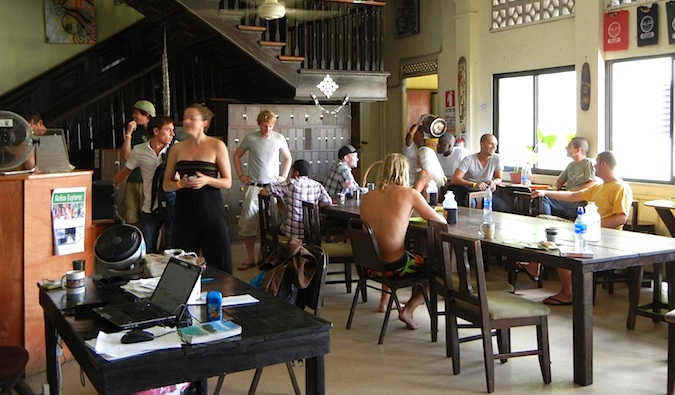
For trips longer than two weeks (or if you are going to be traveling long-term) just book your first few days. That will ensure you have a place to go on arrival. Once there, you can get insider advice from your hotel/hostel staff as well as other travelers. You can then use that info to plan your next steps.
While you can book more than your first few nights, you might end up wanting to change your plans once you land. I prefer having flexibility, which is why I always just book my first few nights and go from there.
Here are my go-to sites when it comes to finding the best deals on accommodation:
- Hostelworld – Hostelworld has the largest selection of hostels and is my go-to site for finding affordable hostels.
- Agoda – Agoda has the best results if you’re heading to Asia (though they sometimes have good US deals too).
- Booking.com – Booking.com is the best overall platform for finding budget hotels and guesthouses.
If you’re on a tight budget or you want to connect with more locals during your travels, consider joining platforms like Couchsurfing or BeWelcome . These communities allow travelers to stay with locals for free as a sort of cultural exchange.
Long-term travelers can also try housesitting or WWOOFing as well as they both offer free accommodation (in exchange for pet sitting or farm work respectively).
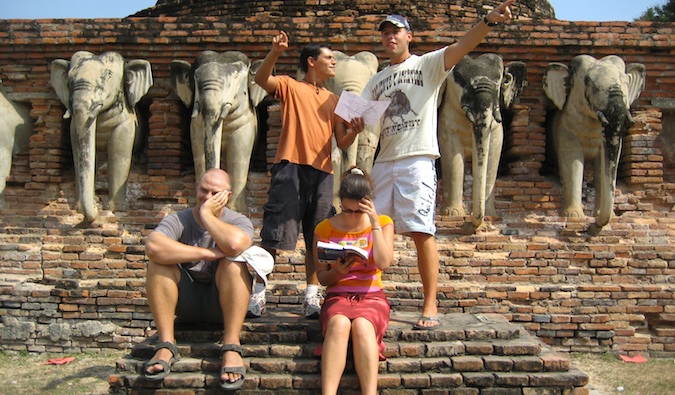
Search online for discounts as well. While some countries offer cheaper prices in person, others give discounts to those who book early/online. Research which is which for your itinerary so you can save money.
For shorter trips, you can also book your activities in advance to ensure you get tickets. For longer trips, book as you go.
Additionally, before you leave home, have a rough idea of what activities are priorities for you. That way, if you run out of time or money, you can focus on your top activities so you don’t miss out. Also, make sure to double-check that there are no holidays or other obstacles that will prevent you from certain activities as well.
If you are going on a long-term trip (six months or more), consider selling your stuff in order to earn extra money for your trip. Start doing this about 60 days before you leave. Some sites to use are:
- Gumtree – An online classified site with a focus in the UK and Australia.
- Amazon – The biggest online store in the world.
- Craigslist – Online global classifieds that have both local and global reach.
- eBay – Another global online classified site.
- Facebook Marketplace – Great for finding people near you (so you don’t need to ship your items).
If you aren’t going to be gone that long, skip this step. If you are going away long-term but want to keep your stuff, move it to a friend’s house or keep it in storage. A good storage company in the US is Public Storage . It’s one of the most affordable options out there.
Get rid of your mail, go paperless, and set up online bill payment for your recurring bills to ensure you won’t miss any while overseas. If you are still going to get paper mail, use a service like Earth Class Mail , which will collect and scan your mail for you. (If you are going on a two-week trip, you don’t really need to worry about this, so you can skip this step, too.)
If you have the option (and don’t want to pay for a mail service), you can also have all your mail sent to a friend or family member.
Additionally, you’ll want to make sure you cancel any phone plans you have or switch your plan to one that is more travel-friendly. T-Mobile is great for travelers going on trips under 3 months. For any trips longer than that, you’ll want to cancel your plan and just buy SIM cards abroad as that will be much cheaper.
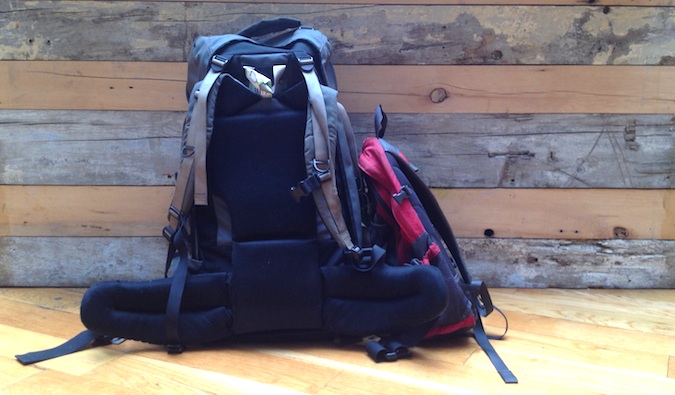
I travel with a 45L REI bag and then a smaller day bag.
Unless you’re heading to multiple climates and need bulky winter gear, you don’t need a massive 70L bag stuffed to the top. Here’s my suggested packing list to help you take just the right amount of stuff and avoid overpacking ( here’s a list for female travelers as well ).
While what you pack will depend on where you are going, remember that you don’t need to pack everything you own. You can buy things you need on the road. You can do laundry overseas. At the end of the day, you have to carry everything you bring. So bring less!
There are a few extra items you might want to pack beyond your everyday clothes, though. Some things I like to bring with me are:
- First aid kit
- LifeStraw bottle with built-in filter
- Packing cubes (to stay organized)
- Travel lock (for hostel lockers)
- Travel adapter
- Quick-dry towel
Additionally, make sure you bring any prescriptions with you so you have enough for the duration of your trip. If that’s not feasible, bring a doctor’s note and prescription with you so you can fill it abroad.
While a lot of people think, “I’m healthy, I don’t need travel insurance . I won’t get sick,” travel insurance is much more than just medical protection. It covers you when your camera breaks, your flight is canceled, a family member dies and you have to come home, or if something gets stolen.
Yes, it’s an added expense. But it’s always better to be safe than sorry. I never leave home without it because I’ve seen first-hand just what can happen on the road.
I never thought I would pop my eardrum while I was scuba diving in Thailand or break my camera in Italy .
I didn’t know I would get knifed in Colombia .
My friend never thought he would break his leg hiking.
Another friend didn’t expect her father would die and she would have to fly back home.
Unfortunately, bad things can happen when you’re traveling. True, these events are few and far between. But they can cost tens of thousands of dollars to handle on your own. If you’re not prepared to pay out of pocket, buy travel insurance.
To help you figure out the best plan for you and your trip, here’s my ultimate guide to picking a good insurance company . It will show you how to pick a good plan that covers you for when you get sick, your flights get canceled, if you get injured, something gets stolen, or your trip is delayed.
Here’s a breakdown of my recommended travel insurance companies so you can see what company offers the best plans for your needs and budget:
- SafetyWing – Super affordable plans for budget travelers.
- Insure My Trip – Best for senior travelers.
- Medjet – Provides additional evacuation coverage to ensure you get home should an emergency occur.
- Insured Nomads – In-depth emergency and non-emergency coverage for long-term travelers and digital nomads.
For more information on travel insurance, you can check out these posts:
- What Does Travel Insurance Actually Cover?
- Is Travel Insurance Worth It?
- Do You Need Medical Evacuation Insurance?
Additionally, make sure you know your rights as an airline passenger. For example, delayed flights to/from Europe often mean you’re entitled to compensation (beyond anything insurance-related).
Learn how to ensure you are compensated if your travels are delayed or your flight is canceled .

If you’re feeling nervous, don’t worry — that’s perfectly normal. You’re about to embark on an amazing adventure — and that’s a huge change. Feeling anxious or nervous or unsure is something every traveler experiences. But you’ve made it this far. Trust your planning, follow your instincts, and you’ll have the trip of a lifetime. I guarantee it.
By using this post as a guideline for your trip planning, you can better organize and prepare for your trip. You’ll check all the boxes, not miss anything, and have plenty of money for your vacation. It can be as simple as booking a flight and packing or as complex as rearranging your entire life to go backpack the world forever.
But, no matter how long your trip may be, this list will help you stay organized and motivated as you plan your trip and step out into the world.
P.S. – Yes, I did leave out visas and vaccinations, because needing those isn’t as universal as the other stuff on this list, but don’t forget to check if you need those, too!
Book Your Trip: Logistical Tips and Tricks
Book Your Flight Find a cheap flight by using Skyscanner . It’s my favorite search engine because it searches websites and airlines around the globe so you always know no stone is being left unturned.
Book Your Accommodation You can book your hostel with Hostelworld . If you want to stay somewhere other than a hostel, use Booking.com as it consistently returns the cheapest rates for guesthouses and hotels.
Don’t Forget Travel Insurance Travel insurance will protect you against illness, injury, theft, and cancellations. It’s comprehensive protection in case anything goes wrong. I never go on a trip without it as I’ve had to use it many times in the past. My favorite companies that offer the best service and value are:
- SafetyWing (best for everyone)
- Insure My Trip (for those 70 and over)
- Medjet (for additional evacuation coverage)
Want to Travel for Free? Travel credit cards allow you to earn points that can be redeemed for free flights and accommodation — all without any extra spending. Check out my guide to picking the right card and my current favorites to get started and see the latest best deals.
Need Help Finding Activities for Your Trip? Get Your Guide is a huge online marketplace where you can find cool walking tours, fun excursions, skip-the-line tickets, private guides, and more.
Ready to Book Your Trip? Check out my resource page for the best companies to use when you travel. I list all the ones I use when I travel. They are the best in class and you can’t go wrong using them on your trip.
Got a comment on this article? Join the conversation on Facebook , Instagram , or Twitter and share your thoughts!
Disclosure: Please note that some of the links above may be affiliate links, and at no additional cost to you, I earn a commission if you make a purchase. I recommend only products and companies I use and the income goes to keeping the site community supported and ad free.
Related Posts

Get my best stuff sent straight to you!
Pin it on pinterest.

How to Use Google My Maps to Plan a Trip (Ultimate Guide)
Note: Some of the links in this post may be affiliate links. This means if you click on the link and purchase the item, I will receive a commission at no additional cost to you. More details are here .

I love a good map. I’ve got maps hanging on my walls. I go to the bookstore to read maps. Whenever I navigate my way home using only a map, I feel like I must have some innate bushcraft skills. And if you’ve read my posts about traveling in Maine , you’re probably sick of me talking about the DeLorme Atlas by now.
But while reading paper maps will always inspire a sense of get-up-and-go adventure for me, I’m not totally opposed to using tech for planning my trips and navigating on the ground.
And one of my favorite techy solutions? A secret little trip planner called Google My Maps, buried inside of everyone’s favorite map tool.
Google My Maps lets you create shareable custom maps with multiple layers, plus location pins with icons and notes. It’s a great way to brainstorm travel plans or create a trip itinerary from a desktop. And since the map can be viewed in the Google Maps app, you can use it to navigate on the go.
To give you an example of what this post will show you how to do, here’s one of the custom Google Maps I’ve created for a trip.
Keep reading for an overview of how to use Google My Maps to plan a trip, plus a video tutorial of how to set it up—all updated in 2023. I’ll also share answers to commonly asked questions and some lesser known tips to help you get the most out of this tool.
A quick note: Creating a custom map in Google My Maps is distinct from Google Lists of saved places. Check out our Google My Maps vs Lists comparison to see all the differences and our full guide to using Google Maps Lists .
8 Top Google My Maps Features
(AKA Why It’s Awesome)
Google My Maps allows you to see your trip itinerary.
This is so helpful, especially if you’re a visual person or enjoy using maps. But even if you’re not, it’s still really useful to see where everything is in relation to each other as you plan your trip, vacation, or holiday because it helps you be realistic about your plans.
It connects with other Google apps.
Setting aside my (ahem, very rational) fear that they may take over the world soon, I love all things Google. My Maps stores a copy of the map in whatever Google Drive account you’re using. (Am I the only one who has six of these?) So if you like to create Google Docs or folders to store trip planning information, documents, photos, or itineraries, it’s nice to have your map easily accessible in the same folder.
You get additional location information since it’s part of Google Maps.
If a location is on Google, you can see their website, phone number, address, reviews, and website when you add it to your custom map. (Note that you can’t see this information when clicking on your saved pin from the Google Maps app, but you can from desktop.)
You can add your own extra notes and photos.
Customize your map even more by adding notes, photos, or videos. Use the notes during planning to add website, hours, or tips. If I hear about the location from a particular website, I usually add that link and what was noted in the article about the location (e.g., it’s a great sunset spot, which dish on the menu is recommended) so I can reference it later.
You can view your route by creating a layer with directions.
When I traveled to Burlington, Vermont, I wanted to see the length of the bike trail on the map, so I used the directions feature to show the whole route. (Check out the Burlington travel guide for an example of the travel map I created that includes the bike path route.) And while I haven’t done this yet, you could also use Google My Maps to plan a road trip itinerary for a longer adventure.
Caveat: As I’ll discuss later, you can’t use directions layers to get turn-by-turn directions (but I mention an alternative below). For this reason, I only use these layers to visualize my route.
It’s highly customizable.
Don’t mind me while I swoon over the color coding and organization options over here. Use custom icons, layers, and colors so it’s easy to see what things are at a glance. For example, you can give different locations individual styles: a coffee cup icon for cafes, a bed icon for hotels, and a swimming icon for beaches. You can also use layers in many different ways, such as one layer for each day of your trip or one layer for each category (like dining, lodging, and things to do).
In-depth planning on your computer. Easy, on-the-go access from your phone.
While you can’t edit the maps from the Google Maps app on iPhone or Android, you (and anyone you’ve shared them with) can view them. You can click on icons and see your notes, as well as navigate to those locations.
Note that there used to be a dedicated My Maps app on Android, but this has been deprecated.
It’s easy to share it with a friend or with the world.
If you’re planning a trip with other people, it’s easy to share the map with others . And if it’s something you want to make available to everyone (like I do on my travel guide posts), just change the privacy setting and share the link or embed it on a website.
3 Ways to Use Google My Maps
Brainstorm and store ideas for future “maybe” trips.
I often come across a really interesting hotel, restaurant, or fun thing to do in destinations I want to travel to in the future, and I want to make sure I don’t forget about them. I have so many bookmarks in so many places (Pinterest, Facebook, Instagram), but Google My Maps is the place I’ve started storing ideas for future trips.
Plan your trip itinerary.
Want to use Google Maps for route planning? When you’re ready to plan an upcoming trip, plot it out visually by using Google My Maps to create your itinerary. If you like structured itineraries, you can easily create a detailed day-to-day plan.
Or, you can use a looser itinerary structure like we usually do by adding all the places you might like to go.
For example, on a day trip to NYC, we added tons of places to eat on the map (thank you, Tiktok). As we were walking around doing other activities and started to get hungry, we were able to easily see which saved restaurants were closest to us.
Navigate on the go.
Whether you’re using your map loosely for ideas or for a structured itinerary, you can pull it up on your phone anytime and get directions to your next location.
Not sure what you want to do today, or want to see what the closest restaurant from your list is for dinner? Pop into your custom map to jog your memory from the notes you made or to get directions to your next location.
Recommended: Need an organized backpack to take on the road? Check out my favorite luggage for camping, road trips, and flying: the Cotopaxi Nazca 24L and Allpa 35L !
How to Use Google My Maps to Plan a Trip
How to create a new custom map.
Go to Google My Maps from your desktop browser . Check the Google icon in the top right corner to make sure you’re using the Google account you want to. Click “Create A New Map” and a window will open with a blank map. To give your map a name and description , click the map name (“Untitled Map”).

You can also change the color and style of the base map if desired. At the bottom of the layer panel on the left, click the arrow next to “Base Map.” You’ll get a window with nine options, including terrain, light political (a very light version of the standard Google Maps), satellite, and some different colored versions. Note that changing the base map style on desktop won’t change anything when viewing on mobile in Google Maps.
How to Add and Edit Layers
When you create a new map, the first layer will already be created, so you’ll probably want to rename it. To give your first layer a title , click directly on the title name like you did with the map name, or click the 3 dots next to “Untitled Layer” and then click “Rename Layer.” Clicking these 3 dots next to a layer title is also how you can delete a layer if you add one accidentally or change your mind. In this example, I’m changing my first layer to “dining” and will add all restaurants to this layer.
You can use layers any way you want to, or simply stick to one layer if you don’t need multiple. To add new layers , simply click “Add Layer” in the gray section below the map title and description.
To move a pin between layers , click the pin on the layer and hold down the mouse, and then drag it to the desired layer.

How to Add Location Pins
There are various ways to add location pins to a layer. First, make sure the correct layer is chosen by clicking anywhere in the white area on the layer. You’ll see which layer is selected by looking for the blue bar on the left of the layer.
- In the map search bar, type either a place name or an address. Click “Add to Map” to add a pin for this location . This is how I add most pins.
- If you don’t need an exact location or don’t have an address , you can click the pin marker button below the map search bar (“Add Marker”). It will turn your mouse into a T and you can click anywhere on the map to add a blank pin. You’ll immediately be prompted to add the pin title and description.
- If you’re dealing with very remote locations (or you just like geeky map stuff), you can also use latitude and longitude coordinates in the search bar.
To delete a pin , simply click on it and click the trash icon.

A few tips and best practices for adding pins:
- If the place you’re searching for does not have a listing on Google, you’ll have to use an address. One thing to note is that sometimes Google Maps listings aren’t correct or don’t take you to the right place, so you may want to double check the location if you’re not using a street address to add the pin (especially if it’s a small business without a website).
- I have also found that hiking trail heads are frequently on Google Maps, but they’re not always correct in terms of navigating there by car. I usually add them to my map to get a basic idea of where they are while planning, but I use a paper map or atlas to find them while traveling.
How to Customize Location Pins
To change the title and add notes to your listing, click on the pin on the map, and then click the pencil icon (“Edit”).
To change the color and icon of the pin , click the paint bucket icon (from the pin itself or directly in the layer). Click “More Icons” to view all the icon options. You can color code by type of activity, by layer, or any way that makes sense to you.
To add photos or videos to a pin , click on the pin on the map, and then click the camera icon (“Add Image or Video”). This is another way to make your map interactive, especially after you’ve visited a location and want to share it with others.

How to Add A Directions Layer
I find that directions layers are helpful for showing the route of a walking tour, bike path, or road trip you want to take, but I don’t find them useful for directions while traveling since I can simply use the maps app to navigate.
I use directions layers whenever I want to show an entire route on a map , rather than a specific location. Think of this as the 2024 version of mapping out a trip with AAA paper maps and a highlighter (if you’re old enough to remember).
Click the arrow icon underneath the search bar, which will create a new directions layer. On the legend, click “Driving” if you want to change this to walking or biking directions. Add a location name or address to Points A and B in the legend. If you find that the pins are not exactly where they should be, you can drag the points on the map.
Continue adding points by clicking “Add Destination” on the map. You can either type the information into the legend or hover your mouse to a spot on the map and double click it. (This is especially useful if you’re tracing a route on something like a bike path or hiking trail that won’t have an address.)
Rearrange the order by dragging the items around in the legend. Just like altering directions on Google Maps navigation, you can click on part of the route and drag it to a different road if you want to change part of the route after it is complete.
If you need to access the directions so you can see the distance of your route or the time it will take, click the three dots on the layer and click “Step-by-Step Directions.” Note that you can’t actually use this to get turn-by-turn directions in Google Maps.

How to Share A Google My Map
There are several options for sharing your Google Maps trip plan.
Open up your map, then click the share button in the gray bar above your layers. To allow others to view your map (which includes embedding on your website), click “change” under the section “Who has access.” For embedding, you will need to make this setting public.
Otherwise, if you want to allow others to edit your map, add their email address in the “invite people” section.

How to View Your Custom Map in Google Maps (iPhone or Android)
Open Google Maps and go to the Saved icon at the bottom. Scroll to the bottom of this screen and click “Maps.” Choose the My Map you want to view. The layers with your custom icons will now be visible on your Google Map. You can click on any pin to view your details (such as description or photos), as well as to navigate there.
To close a map, click on a pin and then click “View Map Legend.” There, you can click the Close icon.
From the Map Legend, you can also toggle layers on and off, and then backing out to the main map (don’t click Close—just the back arrow or back button).
How to Navigate with a Custom My Map (iPhone or Android)
To navigate to one of your pins, open your map, find the pin for where you want to go, click it, and then click “directions.” When you do this, you won’t see your custom map anymore but will be looking at the regular navigation of Google Maps.
You can’t use a My Maps “directions layer” for navigation. If you’re looking for that functionality, I recommend just creating a route in Google Maps and sending it to your phone (or sharing with others). See here for more details.
How to Import Locations from Google Sheets, CSV, or Excel
Importing locations to a My Maps layer can be helpful in a few scenarios:
- You have a significant amount of locations to add to your layer
- Your data is already in the form of a spreadsheet
- You want additional fields included besides the default Name and Description
- You want to create groupings of pins (for example, a list of 50 restaurants could have a column for “Cuisine,” which will give you the option to group and style the pins by cuisine)
The process is simple, and you can import a variety of file types, including CSV, Excel (XLSX), or directly from Google Sheets. There are also special file formats that import map data from other programs, but this section is focused on spreadsheet-type files that you create and format.
Create a spreadsheet with the desired column headers. At a minimum, you need place names and either addresses or latitude-longitude information .
If you want to group your pins by some type of categorization, you should include that as a column. Other columns you could include: website, phone number, description, or notes. While Google Sheets allows you to include photos in a cell, Google My Maps will not import photos in this way (it will include the column as a field, but will be blank).
Once your spreadsheet file is ready, click “Import” on a blank layer (if your map already has layers, you will need to add a new layer to see this option). If uploading a CSV or XLSX, do this from the Upload tab. If using a Google Sheet, click the Google Drive tab and choose your file.
Choose which column has location data (address or latitude-longitude) and click “Continue.” Choose the location name column next and click “Finish.”
To change the icons individually, click “Uniform Style” next to the paintbrush on your layer. Under “Group Places By,” choose “Individual Styles.”
To change styles by a category column (such as Cuisine), click the link next to the paintbrush and choose to group places by the desired column. You can then give each category its own color or icon.
You can manually add new pins to this layer, and they will include all the fields you imported from the spreadsheet columns.
You can also add more items to your spreadsheet, and import this new data. Click the three dots on your layer. Under “Reimport and Merge,” click “Add More Items” and choose your file. It will add the new rows to your layer.
How to Import a Route from Google Maps Timeline History (KML) or GPS Data From a Fitness App (GPX)
Google My Maps can import routes and locations you’ve already traveled to via special file types that are very easy to download from certain apps. This could be useful if you want to share a walking, biking, or driving route that you’ve taken without having to recreate it on a directions layer.
Note that this only works as well as the GPS satellites were able to track your location while you were traveling.
If there are a lot of clouds, dense forest, buildings, or anything else blocking the GPS signal, your tracked route will be much less precise. I’ve noticed that Google Maps sometimes has my route showing somewhere I couldn’t have walked or driven.
If you have your location history turned on in Google Maps, you can download a KML file from a trip, which will include the route traveled and location pins for any stops. Sometimes it misses a location name or adds a pin in the wrong place, but overall it’s pretty good.
Go to your Google Maps Timeline and locate the day you want to export. Click on it, and you should now see your route highlighted along with any stops you made. Now click the gear icon on the bottom of your map, and click “Export this day to KML.” Go to your My Map and on a new layer, click “Import.” Choose the KML file you just downloaded. You can now edit each portion as needed—changing the color and thickness of the route line, changing the location icons, as well as adjusting the route where desired.
If you have other apps that track your location, such as fitness apps, you may be able to download a GPX file that shows the route you took. The instructions for doing this will vary from app to app, but I was able to easily find it in Samsung Health by looking at the detail of a particular workout/walk and clicking the three dots to download a GPX. The import process to Google My Maps is the same as above.
With both methods, you can make adjustments to points/stops along the way or even add more pins. With the Google Maps KML file, you can also adjust your route by moving the small white dots.
Google My Maps Tutorial
Here’s a walk through video to show you how to use Google Maps to plan a trip, along with several of my own Google My Maps itinerary examples. Coming soon: a 2024 update!
Google My Maps Examples
Here are a few more examples of My Maps I’ve created for sharing recommendations, trip ideas, and actual vacation planning.

Google My Maps FAQs and Tips
As great as Google My Maps is for planning a trip, there are some limitations to using it. Lots of questions have also come up about more specific uses and ways to use its features. Thanks to all the readers who have asked or shared tips in the comments as I’m always looking to make this a more robust guide. I’ve organized the questions and tips here since it makes it easier than scrolling through the comments.
How many layers can you add to a map?
Google My Maps limits you to 10 layers. If you are planning a longer road trip and want to create a layer for each day, this limitation may prove frustrating.
Here are a couple of workaround ideas: You can create 2 maps, and have the entire master route as 1 layer on each (showing the very basic route for all 12 days—say from city to city) as a reference. Then build individual layers for each day. As a second option, you could add multiple days to 1 layer and change the titles to start with the day they correspond to (so it would be “1 – Name of Place” instead of just “Name of Place.”) However, this option may not be ideal since you can’t see the titles until you click when you’re on the phone.
How many location pins can you add to each layer?
You can add up to 2,000 pins per layer, and the entire map cannot exceed 10,000 lines, shapes, or places total. I haven’t tested the limits, and it’s possible adding this amount of items could slow things down. My guess is that most travelers wouldn’t need anything so large, but it is possible according to Google .
Are custom Google My Maps available offline?
No, but keep reading for a workaround and alternative.
One of the biggest complaints about Google My Maps is that you can’t download your custom map and pins to use offline, unlike the rest of Google Maps.
However, I have been able to use it in areas with spotty reception. I pulled the map up when I did have reception, and I left it running in the background. It would stay loaded in the app and I was able to pull it up to look at it later when I was out of reception. I’m not sure I would rely on this as a surefire workaround, but it can work in a pinch.
Another alternative, especially if you’ll be traveling in another country where you’ll be completely offline, is to use Google Maps Lists, which can be edited from desktop or your phone but don’t offer the option for separate layers, unique icons, or adding photos.
Is there an app for Google My Maps?
There is no separate Google My Maps app, but you can view your maps within Google Maps. Just make sure you’re signed into the same account, and all your maps will sync.
(There used to be a dedicated My Maps app on Android, but this was deprecated in 2021.)
Can you create or edit maps from your phone?
No, the maps cannot be edited from the Google Maps app. Google My Maps can only be created or edited from the desktop version of the site. This is another huge advantage Google Lists has over Google My Maps because Lists allow you to add new places or entire lists from any device—iPhone, Android, tablet, laptop, or desktop.
Is there a bridge height filter?
No. For RVers and others who need to plan ahead for height limitations, there is no bridge height filter available in Google Maps. Since I haven’t had to use this feature myself, I am not confident in an alternative to recommend. However, from a bit of digging around, there are some apps and GPS units for truckers that may be a good place to start looking if you have an oversize vehicle.
What is the difference between Google Maps Lists and Google My Maps?
They both allow you to create custom maps with pins, but there are some key differences, such as offline access, layer capabilities, customizable pins, and creating/editing within the app. Check out the details on how Google My Maps compares to Lists (including a features comparison table).
How many stops can you add on a directions layer?
You can only add 10 stops per directions layer. This is also the maximum number of stops you can add for navigation in Google Maps. As some readers have pointed out, this can be limiting when you want to use this feature for a long road trip.
Can you use the directions layers on your phone for navigation purposes?
No, you cannot create a directions layer and then access those turn-by-turn directions for navigation in the Google Maps app.
So…are directions layers totally useless? What’s the point of having a Driving Directions layer in My Maps?
Personally, I still like to use these layers, but only to show a route for my very visual brain, rather than to actually create custom directions.
Can you send a custom created route (layer) to someone else so that the other person will take that specific driving route on google maps?
No, you can’t do this from My Maps, but there’s a workaround I can suggest.
Forget My Maps, and use Google Maps from desktop or mobile to plot a route. You can add up to 10 stops, and then you will be able to share your custom directions.
From desktop, there’s an extra step in first sending the directions to your phone. If you’ve created the directions in the mobile app or once you have them pulled up there, you can share them with anyone by clicking the 3 dots next to your list of locations (sharing must be done before clicking “Start”—if you’re already in the navigation, you need to back out of it to share). When you share, it will list all the steps as well as send a link for the other person to open the directions in Google Maps directly.
An important caveat to sharing custom routes: Google Maps will reroute the directions as it normally does according to current traffic at the time of driving, so this method cannot be relied upon if you’ve mapped a specific route for bridge clearances. As a workaround, you can add “stops” on the desired interstate (zoom in and add this literally on the road itself so navigation doesn’t try to take you off an exit), which will force Google Maps to take the driver that way. This is what I do when driving south from Connecticut to PA because Google Maps always wants me to take its beloved George Washington Bridge and I always don’t want to. I add a stop to force my route across the Tappan Zee Bridge. However, I’m not sure I would rely on this workaround as a sole method for RVs or truckers.
Can you see how much time the directions will take?
Yes, on desktop you can view the details if you want to know the distance or how long a route will take. To view distance and time for a directions layer, click the 3 dots on the laye, then click Step-by-Step Directions.
Of course, this doesn’t really help when you want to get this information on your phone or use the directions for navigation. As mentioned elsewhere, the “directions” layer functions best as a way to visualize a route. If you need turn-by-turn directions, see the steps mentioned above to save and send directions in Google Maps.
This post was originally published on July 27, 2017 and has been updated in May 2023.
Travel Photographer | FAA Certified Drone Pilot
Naomi is the coffee-loving, crazy-about-Latin-America writer and photographer behind everything here. She's guided by curiosity and a belief that every place has a story to tell–whether it’s through the intricate details of nature, history that has shaped a culture, or the people who call a place home. Learn More
Plan, Ready, Go
How to Plan a Trip for Beginners (5 Easy Steps)
Planning a trip can seem overwhelming to beginners, but I promise you that it’s simple. You only need to do a few things to plan a trip…and a great trip at that!
Keeping things simple will help you keep the nerves at bay and make your overall experience more smooth.
There’s no need to overthink your travel plans. You don’t need to follow an 11- or 18-step plan to learn how to plan a trip.
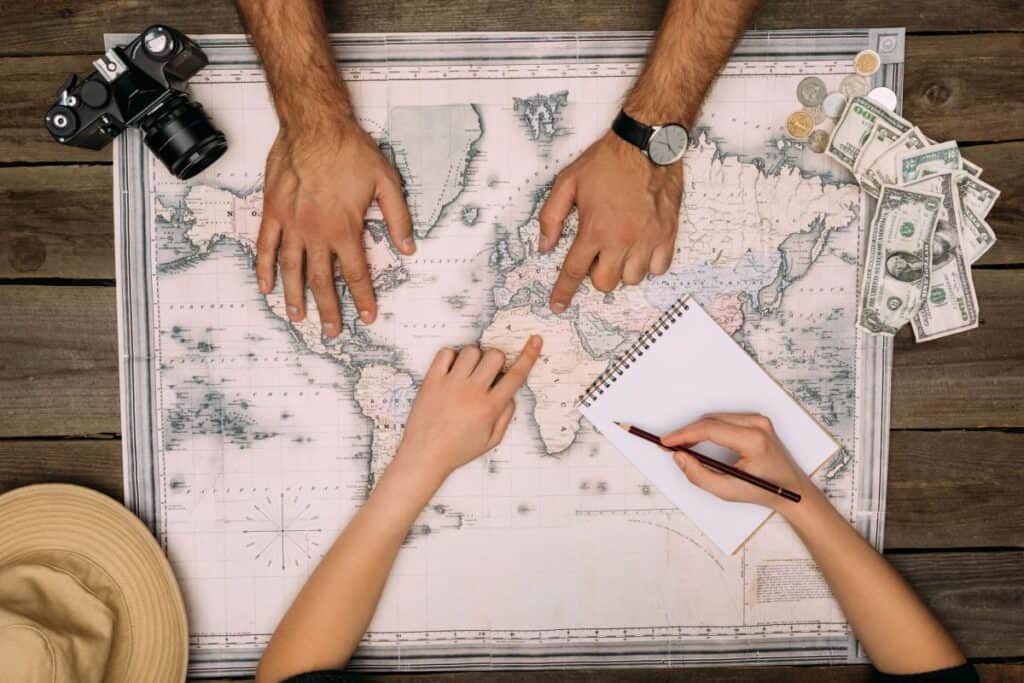
So if you want to easily plan a trip without any drama, just keep reading!
To get started planning your trip, grab your FREE printable travel planner here.
This post includes affiliate links. If you make a purchase through one of these links, I may earn a small commission at no additional cost to you. As an Amazon Associate, I earn from qualifying purchases. See disclaimer.
#1. Choose your trip destination
First, you need to decide on where you want to go…which can sometimes be a difficult task since there are thousands of travel destinations all over the world.
Keep in mind that certain destinations will require a little (or a lot!) more research or pre-travel prep than other destinations (such as visa or vaccination requirements). They make for more complicated travel planning.
If you’re planning your first trip, I highly recommend that you keep your first destination simple. You can always make more complicated plans for your next trip.
Consider trying:
- A domestic trip
- A destination just a few hours’ drive from your home
- A simple weekend getaway
When choosing a destination , cost is often going to be a major factor. You can choose your destination and then set your travel budget or choose your destination based on a travel budget you’ve already set.
Either option is a viable choice.
We tend to start planning trips up to two years out and we’ll set our budget based on where we want to go and how much time we have to save up the money we think we’ll need.
This leads me to one of my favorite travel tips (which also doubles as a personal finance tip: do not go into debt to travel. Only spend the money that you have.
For more help with budget travel, see my article outlining all my best practical tips for affording more travel .
For more help with building your travel budget, check out this post on creating a travel budget that works for you . It includes basic guidance for how much of your travel budget to allot for certain expenses such as transportation, accommodations, food, activities, etc.
Or sometimes we find we have some extra time and money and we’ll choose our trip destination and trip length based on the money we have available.
For help with choosing your travel destination, you can:
- Brainstorm a list of places you’ve always wanted to visit. Inviting your travel companion(s) to give their input is a great way to get them involved in the planning process.
- Check out Pinterest for inspiration
- Read your favorite travel blogs (hint hint)
- Ask friends and family about their favorite trips
- Do Google searches for ideas such as “Affordable beach vacations in the U.S.” or “best family vacation destinations in Europe.”
- Consult with travel guidebooks
Once you’ve chosen your destination for your perfect trip, you’re ready to get on with planning your trip.
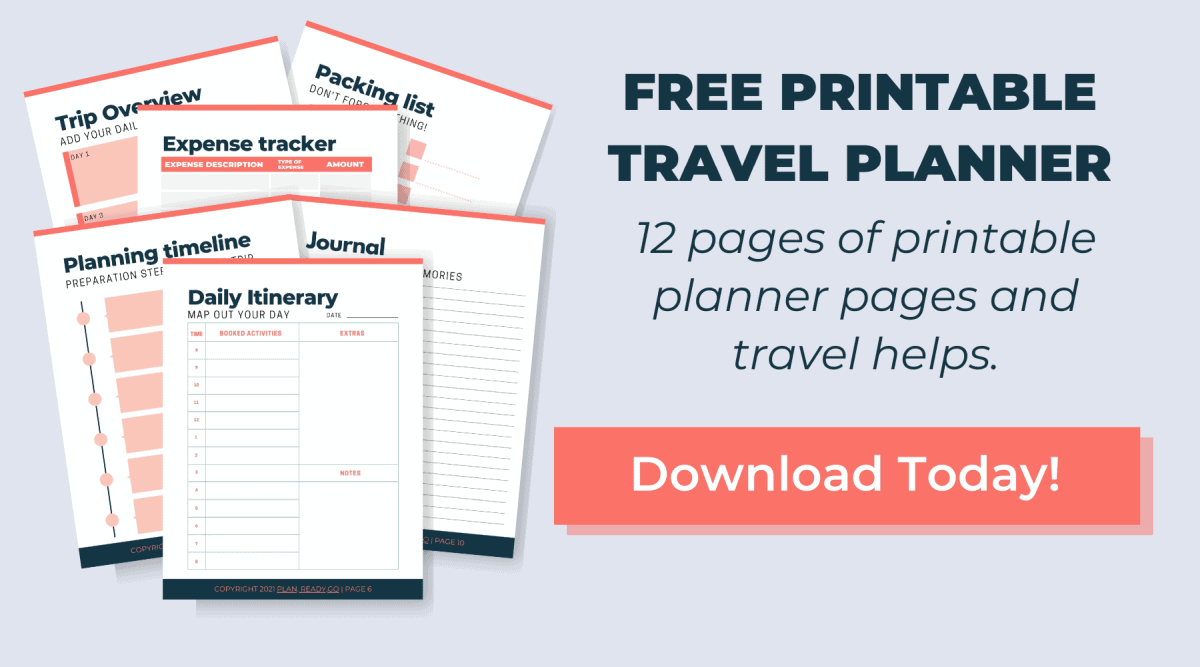
#2. Decide how you want to get there
Once you’ve chosen your travel destination, you’ll need to make arrangements for getting there.
Now, sometimes there will be only one obvious transportation option for your destination. But sometimes there are non-obvious options such as taking a cruise to Hawaii instead of flying or traveling by bus or train.
If you live in the “lower 48” in the U.S., more often than not you’ll be flying or driving to your destination. We generally prefer to stick closer to home and drive for short trips. For a long trip, we’re always willing to fly.
Google Flights
My go-to site when I start my trip planning is Google Flights .
Use the “Explore” tool to browse for great deals from your chosen departure airport. You’ll get the best results if your travel dates are flexible…though this can be said of any cheap flight tool.
See my post on how to use Google Flights for more information.
Formerly Scott’s Cheap Flights, Going is a flight deals subscription service that sends travel deals straight to your email inbox. And Premium members get weekend getaway deals in addition to amazing deals on international and domestic flights.
In my opinion, a Going Premium subscription is well worth the money and is the best way to get the best deals on flights especially if you have flexible travel dates and want to see a new place. I especially highly recommend Going for international travel (from the U.S.).
You can even try it for free for two weeks to decide if you think it’s worth the money.
For more about this service, see my full review of Going .
Secret Flying
Another great resource for finding amazing deals on flights (including error fares) is Secret Flying . Secret Flying is totally free.
You sign up for alerts on their website , but they don’t offer alerts from any airport you want in the U.S. But they do offer alerts from airports outside the United States, unlike Going
Another tool in my trip-planning arsenal is the Hopper app . Hopper predicts prices to help you decide whether you should book now or wait for a better deal to come along. I like to use Hopper when my travel dates aren’t as flexible, but I have time to wait for prices to improve before I book.
For more details about all the options for pricing flights, see my full post on how to save money on flights .

I love driving to our travel destinations whenever we can. No airport security. No worrying about missing connections, etc.
I also love that I can be a lot less fussy about my packing. If it fits in the car, it can go.
Not to further complicate things, but you might also want to fly to your first destination and then road trip from there to see a few cities. This does make travel planning more complicated, but if you opt to do that you’ll want to look into renting a car.
A less complicated option is to choose one destination to serve as your “home base” and then day trip from that one location to see more of the area.
AutoSlash Find a great deal on rental cars with AutoSlash . You can also use AutoSlash to track your rental, and they’ll notify you of price drops.
Costco Travel If you have a Costco membership, you can also find great deals on rental cars through Costco Travel . I always check both.
I used to always get the best deal through AutoSlash, but lately, Costco has been offering me the best price.
Employee or association discounts Check with your employer or your alma mater’s alumni association to see if they offer any rental car discounts you can take advantage of.
For more help with your road trip, check out:
- Things to do on a long road trip to pass the time
- Great road trip questions to spark fun conversation
- Entertaining road trip trivia & questions

#3. Figure out where to stay
Now that you know where you’re going and how to get there, you can decide where you’re going to stay once you’re there.
Unless you want to travel on a shoestring, you can bypass the typical “gap year” options like hostels and couchsurfing.
Your main options then will be to stay in a hotel (or resort, inn, or bed & breakfast) or use a vacation rental through a platform like Vrbo or Airbnb.
The choice of staying at a hotel, inn, or resort will depend a lot on how you like to vacation and what you’re looking for as far as amenities.
Those who travel regularly might choose a major hotel brand to frequent so that they can earn points for their stays and loyalty status for access to more amenities and upgrades.

Vacation rental
Using a vacation rental can often (but not always) save you money.
Keep in mind when looking at options on Vrbo or Airbnb that the added fees can be significant, meaning that at some destinations or for shorter stays a hotel might cost you less money per night.
And there are plenty of affordable hotels that offer helpful amenities like free breakfast.
On the other hand, your vacation rental will typically come with a full kitchen, allowing you to bypass eating meals out at restaurants if you wish, which can also mean significant savings in your travel budget.
Vacation rentals are also a great option if you’re traveling with a large group that would require multiple hotel rooms. Dividing the cost of a larger vacation rental home with several bedrooms will very often save money over booking multiple hotel rooms.
There are websites (like booking.com ) that allow you to look for a wide variety of accommodation options at the same time: hotels, inns, B&Bs, condo rentals, homestays, etc); however, a downside with using a site such as booking.com is that choices can be overwhelming, making it difficult to make a decision.
My recommendation for new or anxious travelers who are having difficulty choosing a place to stay is to:
- Use a map to choose an area or two in your destination where you would like to stay
- Set your budget
- Do a little research to find 3 or 4 accommodation options in a location you like and that are within your budget then stop searching there
- Compare the amenities of those options and book
#4. Choose what you want to do
Now that you’ve settled on where you’re staying at your destination, you need to make some decisions about what you want to do on your trip.
What do you enjoy doing when you travel?
- Popular tourist attractions
- Theme parks
- Guided behind-the-scenes tours
- Walking tours
- Arts performances
- Outdoor activities
- Historical sites
- Natural sites
- National parks
- Scenic drives
There are so many options!

Depending on your destination this may require a fair amount of research and pre-booking tickets or tours. Or it could be as simple as just brainstorming a few ideas for things to do if you get bored.
Here are a few tips for building out your itinerary:
- Be honest with yourself about what your “must-do” attractions and activities are. Prioritize the most important thing early in your itinerary then add in any lower priority items.
- Don’t overbook your itinerary. Make sure to give yourself some breathing room between activities to account for travel delays, rescheduling for bad weather, etc.
- For longer trips, give yourself half a day or a full day with no pre-booked activities so you can get some extra rest, go back to a spot you enjoyed, or accommodate any extra sites/activities you discover at your destination.
See my post on planning a travel itinerary to learn about the exact process I follow when I plan my trips.
#5. Build your packing list
With your itinerary built, it’s time to figure out what you want to take with you on your trip.
Your packing list will be a reflection of your destination, the season/weather during the time of year you’re traveling, and your planned activities among other things.
And don’t forget to pack your important documents such as your passport, etc.
Here’s more help to get you packed and out the door:
- Travel Light Packing List for a Week (in a Carry-on)
- The Best Carry-on Packing Tips for Traveling Light
- How to Pack Toiletries in a Carry-on Bag
- Weekend Packing List (For Any Kind of Getaway)
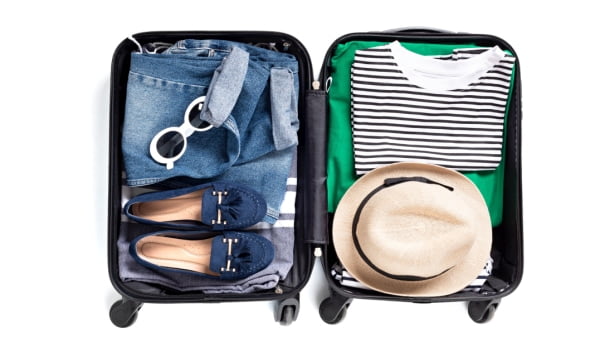
Other things to consider before you travel
While we just went through all the major steps you need to take to plan your trip, depending upon your destination and personal life situation there may be other things you may need to take care of before you leave town.
Visa, travel advisories
If you are traveling out of the country, you must understand what the entry or visa requirements (if any) are for your destination.
Don’t be like the honeymooning bride who didn’t know that her passport needed to be valid for three months beyond her planned date of departure from France at the end of her trip. It would have taken her literally two minutes to find that information and avoid the heartbreak of not being able to take her honeymoon.
You’ll also want to be aware of any travel advisories or health requirements/recommendations. U.S. citizens traveling internationally should check the U.S. Department of State website for helpful information.
Travel insurance
When you travel, it’s a good idea to purchase travel insurance in case something goes wrong.
We use World Nomads for peace of mind whenever we travel internationally.
Miscellaneous considerations
Other things you may need to think about as you plan your trip could include:
- Arranging care for pets
- Arranging for your mail to be picked up or held
- Making sure that you don’t miss any bill due dates while you travel
Final thoughts on planning a trip
Traveling for the first time or planning a trip yourself for the first time can seem scary, but it’s actually a pretty simple process.
Certainly, some kinds of trips are more complicated than others or destinations that require more advanced prep before you visit, but beginners and anxious travelers can still plan wonderful trips on their own.
Just remember that you only need a few things to have a great trip: a destination, a way to get there, some place to stay, and things to do.
More articles to help you plan a trip
- Essential travel planning resources
- The best travel guides (books and online resources)
- Find the best personal item bag for you
- Checklist of the last-minute things to do before you leave for your trip
Pin this post!
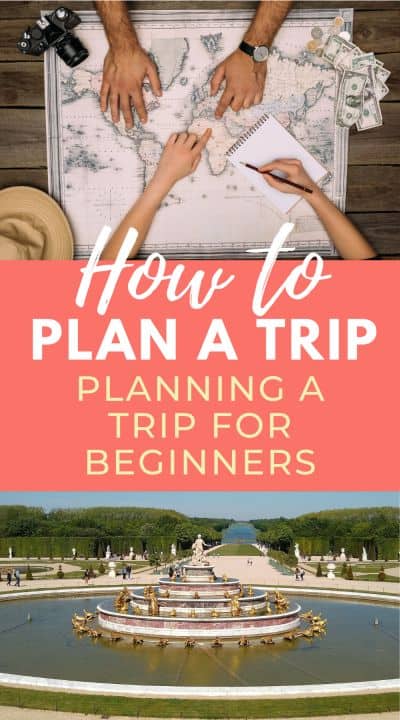
Darcy Vierow is a busy professional and travel planning expert with years of experience maximizing travel with limited time and on a less-than-average salary. Her tips have been published by Forbes, MSN.com, Yahoo! News, Yahoo! Finance, Aol, Newsbreak and GOBankingRates. Read more about Darcy Vierow .
Leave a Reply Cancel reply
Your email address will not be published. Required fields are marked *
By using this form you agree with the storage and handling of your data by this website. *
Privacy Overview
/ FORGEMYTRIP
Simplify your trip planning with ai powered itineraries.


How I Plan My Trips from Start to Finish: Travel Planning Guide

How do I know where do I want to go for my next trip? Where do I find the best deals for hotels? Where do I begin? These are the most common questions my friends and readers ask me on a regular basis.
Most people don’t want to deal with planning a holiday, hence why all-inclusive holiday packages still sell like hotcakes. This is why I decided to put together my travel planning guide to show you how I plan my trips from start to finish, so you can easily do the same thing.
For the purpose of this article, we’re going to take my last year’s trip to the Middle East as an example.
Trip Planning Guide in 7 Simple Steps

Step 1: Decide Where Do You Want to Go
First things first, where do you want to go? If you know you want to go somewhere specific like for instance Thailand or Mexico, that’s great, but personally I usually leave it semi-flexible.
If you’re entirely flexible with the destination you could skip to Step 3 immediately. Alternatively, you can sign up for services like Scott’s Cheap Flights or Secret Flying that will let you know by email when there’s a new flight deal or mistake fares appear.
For the purpose of this post I’m going to describe how I came up with my trip to the Middle East when I went to Lebanon , Jordan and Egypt on one trip in late February / early March.
Ask yourself if you have a specific time of the year you can take time off. In my case, it was March, as I knew Matt would be leaving for his trip during that time.
Once you know the approximate timeframe for your trip you need to start looking into weather forecasts. If you want to escape the winter, going to cold Europe might not be a great idea for example. While a cheap flight to Bali in January could be appealing, keep in mind that rainy season means it will rain 24/7 if you get unlucky.
While I never Google things like ‘best places to go in February’ , simply because most of these articles are just random places, I do search for ‘Jordan in February’ or ‘Jordan in February weather’ as it can give you a rough idea what to expect.
My trip example:
For my trip, I knew I wanted to go somewhere warm. I thought of Namibia, but I wouldn’t have had enough time to work out my visa, so then I started searching for places to visit in the Middle East. This is how I came up with an idea of possibly heading to Jordan.
Take into consideration other factors, not just the weather. I remember when a friend of mine booked flights to Peru to see Macchu Picchu without giving it much thought, only to realize after the fact that Inca Trail closes every year due to mudslides during the time he was visiting.

How I planned my trip to Jordan.
Step 2: Decide on Your Budget & Trip Lenght
The next step in planning your trip is realizing what can afford it and therefore how much time do you have for a trip. Do a quick search how much do things cost in places you’re dreaming of visiting (unless you know it already).
While you could afford a month-long luxury trip in South-East Asia, the same amount of money won’t last you for more than a few days in, for example, Australia.
If I don’t know the prices in places I’m thinking of going to, I usually do a quick search on Booking.com to get oriented. At first, I don’t go deeper into finding hotels, but just to get an idea of whether I can afford it or not.
A quick search for accommodation can also give me a rough idea whether I’m not too late with booking everything. For instance, you could find a great last-minute flight deal somewhere, but if all affordable hotels are sold out, you could end up spending way more money overall than if you didn’t book this cheap flight.
Naturally, you can always find cheaper places to stay like hostels and never go out to eat, but these days my backpacking days are over and I want to make sure that I have enough to do everything I want at the destination I’m going to.
I was aware that Jordan isn’t the cheapest destination, but upon researching further I realized that it’s even more expensive than I thought it would be. In this case, it didn’t stop me, I still could make it work as I found out renting a car would chop by costs by at least 3 times than if I had to hire a driver or use shuttles.
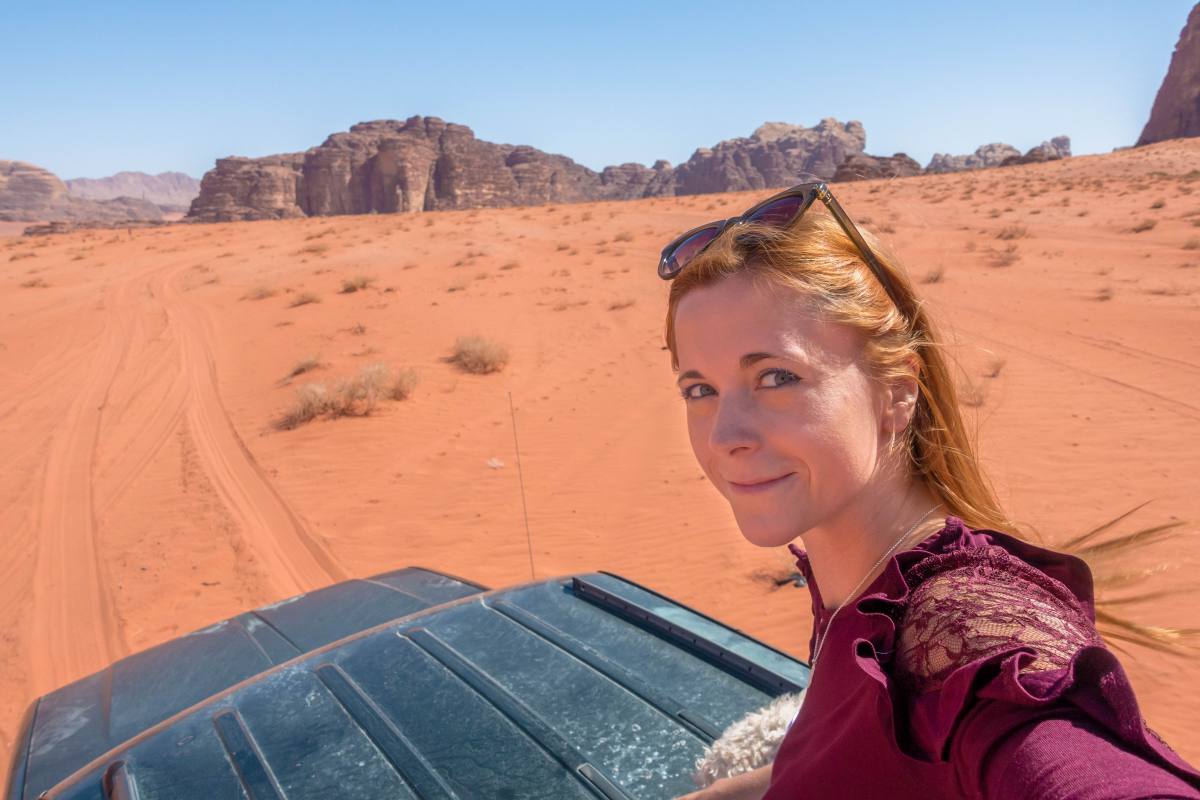
Riding on top of the jeep in Jordan!
Step 3: Look for Flights
Once you have a rough idea of the destination, you can see if getting there would be easy and simple. Which means, booking your flights.
While some people use Google Flights, personally I always go to Skyscanner .
You can start searching for flights from your city to a place you want to go, but that’s not going to give you the best possible deals. I described my entire process in another post on how to find cheap flights .
Basically, you should be looking at the entire month instead of specific dates and be flexible with your layover.
When I searched for flights directly from Los Angeles (where I lived at the time) to Amman, Jordan, the price was quite high. Hence why I reversed my searches by looking for flights from Amman to everywhere.
The cheapest flights were to Beirut, Lebanon. When I did the same search – from Beirut to everywhere, it turned out I can easily get to London from there. Then from London getting to Los Angeles was a piece of cake.
I knew I had to book two separate flights: LAX – LHR and then LHR – BEY – AMM – LHR. That said, I knew immediately that I was going to add Lebanon to my trip, I couldn’t resist not stopping there at all.
I also noticed that when searching for flights it was always giving me a possible layover in Cairo. As I had time, I checked that if I extended my possible layover in Cairo, the flight wouldn’t have cost me anything more than just going directly. This is why I also added additional time in Egypt to my trip and booked a separate cheap flight from Cairo to Luxor.
The price of these three flights was half of the original route going directly from LAX to Jordan. Plus, I got a bonus of seeing two more destinations for less money.
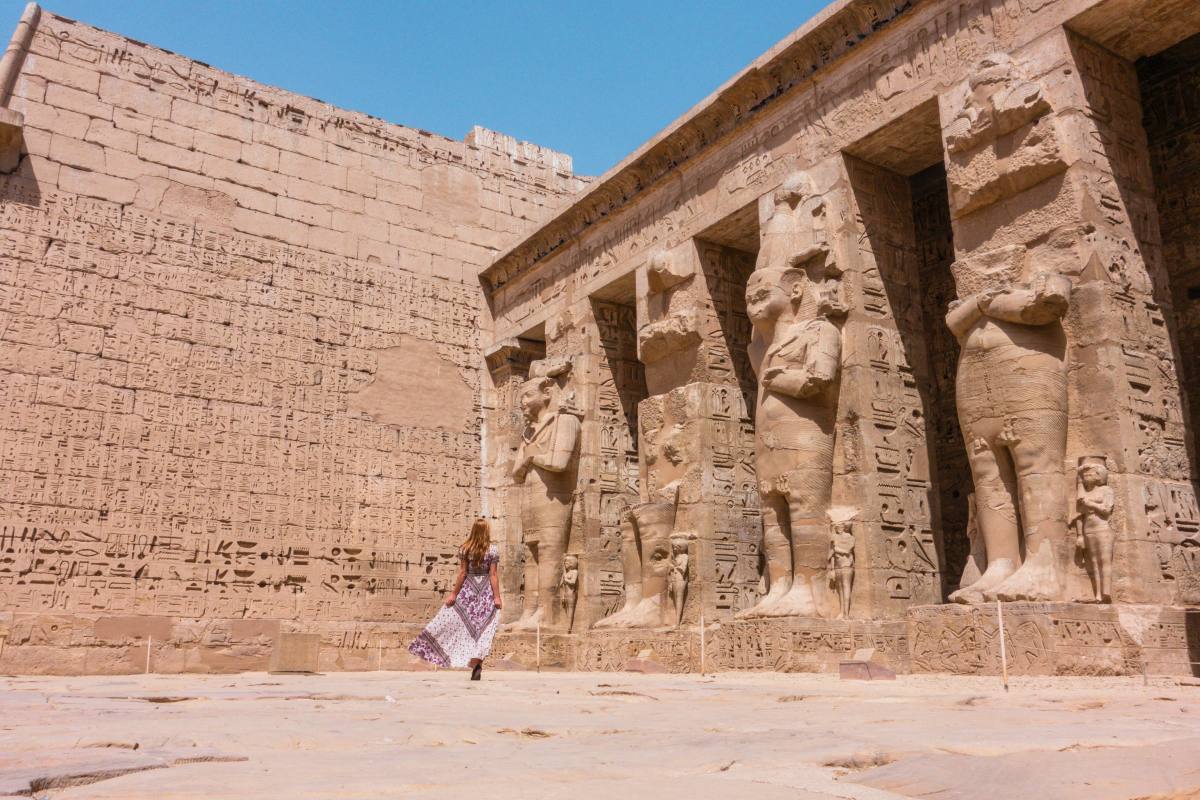
By searching for flights I realized I could add a stopover in Egypt for free.
Step 4: Check Visa Requirements & Immunizations
Once you have your flights in order, know that there is possible accommodation available and that most importantly you can afford it all, it’s time to check some important things: visas & other requirements.
Make sure whether you need a visa and if you need to arrange it in advance. Also, remember that you won’t be able to visit certain destinations if you visit some other ones unless you change your passport in the meantime.
The obvious example would be Israel and many other countries like Syria, Lebanon, Libya, Kuwait, Iran , Iraq, Pakistan, Sudan, Yemen. Surprisingly to many, Saudi Arabia doesn’t care whether you visited Israel anymore since introducing its eVisa system .
Even if you didn’t get an Israeli stamp, but they’ll find that you have a stamp from Aqaba port of entry to Jordan, where people frequently end up when crossing from Israel to Jordan for short trips, you’ll still be in trouble.
The same thing can happen is you’re visiting Azerbaijan, but have visited certain territories in Armenia. Check everything thoroughly.
With my EU passport, I didn’t need any visas for either destination, however I had to pay $25 for an Egyptian visa upon arrival. All good here.
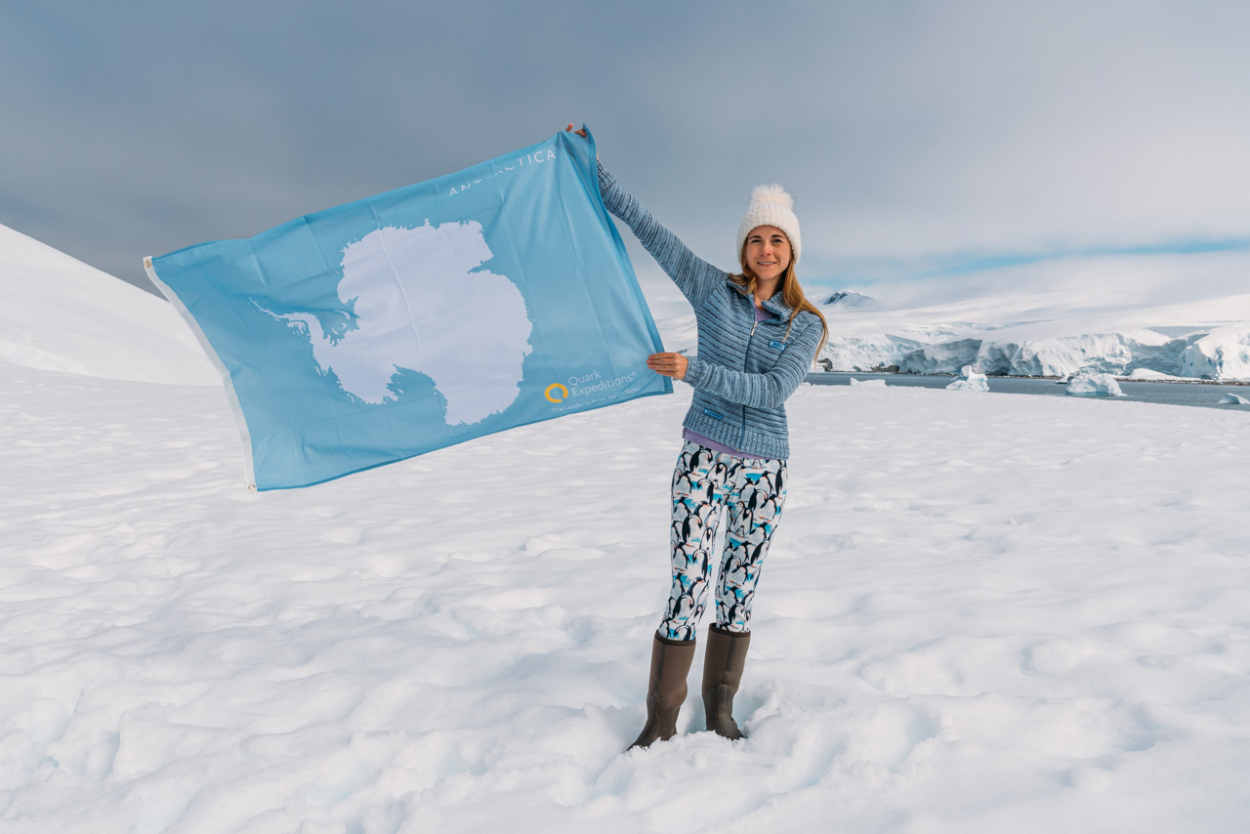
You don’t require a visa for Antarctica, but you need a visa for Argentina or Chile in order to get there.
Step 5: Research Possible Itineraries
The next step, definitely before booking any hotels is deciding on the possible itinerary. The reason I’m recommending not booking accommodation first (unlike most blogs actually) is that if you don’t know what do you want to do, you might end up being somewhere on a different day, having to drive for hours to get where you want to be, etc.
Itinerary goes first. If I have no idea what to do in a country, I naturally Google the typical ‘ things to do in X’ . However, this can often give you a bunch of unknown unchecked info these days, so I also tend to peak at Viator & GetYourGuide for ideas for activities.
Even if I don’t always book trips there, unless I cannot get somewhere by car or it’s simply easier to get a tour (for example to Loire Valley , because I wouldn’t ever drive in Paris), it can give you a rough idea on what can you do in a place, especially when it comes to day trips.
As well as seeing what kind of itineraries are offered from GAdventures and Intrepid . I recommend both companies if you want to travel in a group or to a more difficult to arrange yourself destinations, but if you prefer solo travel, you can simply see what kind of routes to take, especially when planning multi-country trips.
I also peak at Atlas Obscura to get some interesting ideas for some lesser-known things to see and do.
If you’re a road trip person or you find that it’s cheaper to book a car you might want to consider renting a car. To get the best deal on rental cars, use a price comparison website. For most of my trips I use Discover Cars to make a booking.
I love to bookmark every interesting place or hotel I see around the world when I stumble upon it – whether on social media or elsewhere, even if I plan on visiting a certain place at the moment. When I actually do find myself visiting a place I can take a glance at Google Maps and see whether I’ve already had some interesting ideas.
It took me a few years to visit some places (like amazing Castello Orsini castle hotel in Italy), and there are still some places I’ve bookmarked years ago and maybe I won’t visit them for another couple of years, but I love to have them ready.
I knew more or less what I wanted to see in Jordan. However, while I originally thought of staying in Amman first before heading to Petra, I quickly realized that this plan won’t work simply because Petra at Night – something I wanted to do, was only happening on specific dates. Hence why I had to change my plans around. If I booked hotels first without setting up my itinerary, this wouldn’t happen.
However, I also had opposite situations as well. For example, when planning my itinerary for a trip to Mauritius and splitting my time between area A and area B, I realized that for some unknown to me reason hotels in these two locations could be significantly cheaper if I first went to area B instead of area A.

Especially when you’re planning for a road trip, check possible itineraries before booking any hotels!

Step 6: Book Your Hotels & Day Tours
Once you have your loose itinerary, it’s time to go back to Booking.com and book these hotels you’ve been eyeing. The reason I usually go on Booking instead of Agoda is that I know they’re the most reliable. I actually worked at Booking.com as an editor a few years ago, so I can tell you that it’s a good company and if a hotel cancels your booking or something’s wrong with what you booked, they’ll fix it for you!
There’s also always an option of an apartment rental on AirBnB . While the service has been under fire for the lack of customer service and, you can still find an affordable apartment in expensive cities like London or Paris there. However, if I know I’ll be arriving late, I’m in a hurry, or won’t have a reliable Wifi at the destination, I still prefer to book a hotel with a 24/7 reception.
Once you’ve booked your accommodation, you can start looking at other things. For instance, if you’re a big foodie, you might already have some restaurants in mind and lots of popular restaurants require making a reservation in advance. Don’t go crazy on that, unless you’re heading to places like Test Kitchen in Cape Town that books up a year in advance, usually a few days before is fine for popular spots or Michelin star restaurants.

Restaurants like Alux Cave in Playa del Carmen need a reservation in advance.
Step 7: Make Sure Your Cards and Phone is Going to Work Abroad
Once you book everything the last step is to make sure that you’re ready to go. Will you need your phone at the destination to drive around? I remember traveling when the internet was barely existent and navigating with the actual maps and road signs, but I imagine these days you want your Google Maps or Waze to point you in the right direction 😉
I have an international T-Mobile plan and for $10 per month, I get internet in most countries abroad. It’s not super fast unless you purchase a separate package, but it’s enough to show me the way. Make sure it will work beforehand though.
If you’re not from the US and your roaming packages are extremely pricy (like for Australia from what I’ve heard) you can either purchase a local SIM card (in most countries you will be able to do it, but in some places like India it’s problematic) or get a portable WiFi devices. Before I got my T-Mobile I used to use TravelWifi (previously known as TEP)
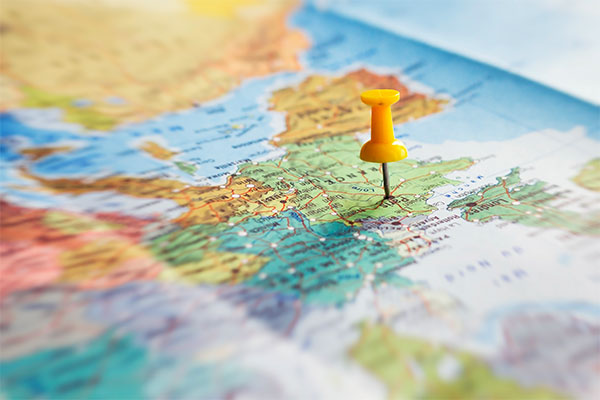
FINALLY: Pack Your Bags
Now that you know where, when and how are you traveling, you need to pack. Unless you have a lot of camera equipment I believe that you can usually perfectly fit into a carry-on suitcase.
That way, you don’t need to wait for your luggage upon arrival and you can simply walk out of the airport quicker.
- My Carry-On Packing Guide with a Video
- Best Carry-On Travel Suitcase
- Packing for a Trip with a Baby
If you don’t manage, or simply don’t want to pack in a carry-on only, remember to always bring at least a packing cube full of emergency clothes and underwear with you on board. Your luggage might get lost, but you won’t get totally screwed that way.
Trust me, my suitcase got lost by Air France on the way to our honeymoon and actually we didn’t get them back until we got back home (a horrible story for another time and a subtle recommendation to avoid AirFrance at all cost if you can!). If I didn’t have my packing cube with me I’d have been wearing the same unwashed outfit every day because naturally, we couldn’t buy much on a safari.
That said, packing cubes are a lifesaver! My favorite brand of packing cubes is Edge Creek .
Do you have any doubts about planning a trip from start to finish? Post a comment below 🙂
Share this:
Notify me of new posts by email.
Mark Renner
Sunday 5th of April 2020
Nice Post! I like the ideas that decide on your budget & trip length. Thanks for the tips.

How To Plan A Trip: Easy 15 Step Travel + Vacation Planner
by Mark and Kristen Morgan
Published: July 17, 2019
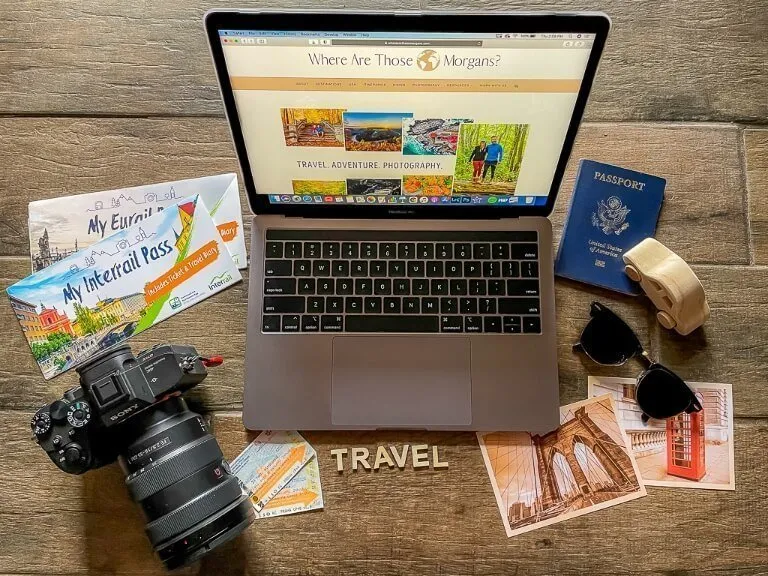
This ultimate how to plan a trip guide will transform your destination daydreams into travel reality within just 15 easy-to-follow steps.
Adventure is calling! But where should you go? How do you get there? And what do you need to organize before you leave home?
This one-stop travel planning resource covers all you need to know about preparing for any trip.
But how can you trust us to cover all of the important travel planning aspects?
The goal is to walk you through 15 simple and stress free steps, from ideas to bookings and from packing to walking out the door. We’ll take you on a journey from idea to reality.
Personally, when we plan a trip, we know that breaking the process up into sections works best. We feel less overwhelmed when we plan in manageable pieces.
Follow the steps in this guide and you’ll see just how easy planning a trip can be. Let’s travel plan!
The Travel Planning Rollercoaster

Planning any vacation is like being on a rollercoaster called the Emotion Overload. In the beginning the rollercoaster climbs slowly, building your excitement before plummeting into overwhelmed anxiety.
The second climb is determination and hard work, followed by a loop de loop as information spins around your brain in circles.
And just when it seems the ride will never end, the carriage comes to an abrupt halt: your plans are finally ready.
Break Up Planning A Trip Into 3 Sections
We are all different. Genetics, personality traits, habits and attitudes make us all unique. But although we are all unique, common patterns emerge among travelers.
Most long term travelers tend to book the first week or month in detail. Once comfortable with the whole idea of backpacker life, they tend to plan just a few days in advance each time they move.
Because who knows what might come up? Those taking shorter trips, such as a 2 week vacation, typically plan almost all specific details in advance.
Because who wants to lose valuable time planning what to do that day with just 2 weeks away from work
No matter how you prefer to travel or how long you intend to travel, the planning process can always be broken down into 3 manageable sections. You will make life easier and less like your brain might explode.
Plan, Book And Pack
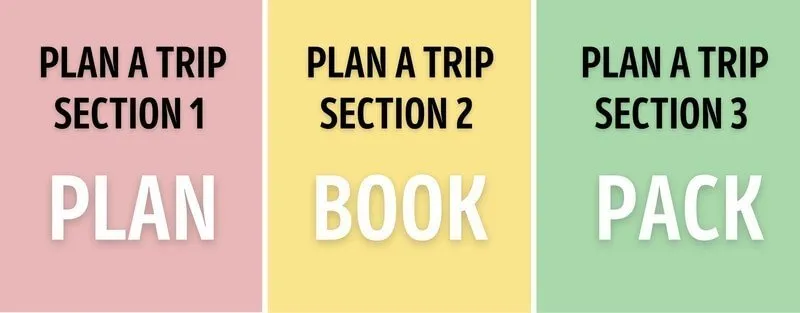
These 3 travel planning sections encompass the same repetitive processes we all follow, every time we travel. When we repeat them enough times, they become autonomous.
You plan your travel goals, you book the essentials, you pack your bags and you go.
But even when taken back to basics, each travel planning section can be time consuming, frustrating and overwhelming. We know from first hand experience when planning multiple long term travel routes.
The key is to break down each travel planning section into smaller, easier to accomplish steps. That way you will eliminate stress and feel the positive reinforcement each time you complete a step.
Follow the easily achievable steps listed below within each travel planning section. Begin to plan your trip in advance, take each step one at a time and we guarantee you will avoid feeling overwhelmed.
All you need to do then is watch your dream trip create itself before your eyes.
Need help with packing? You might like to use our ultimate travel packing resource .
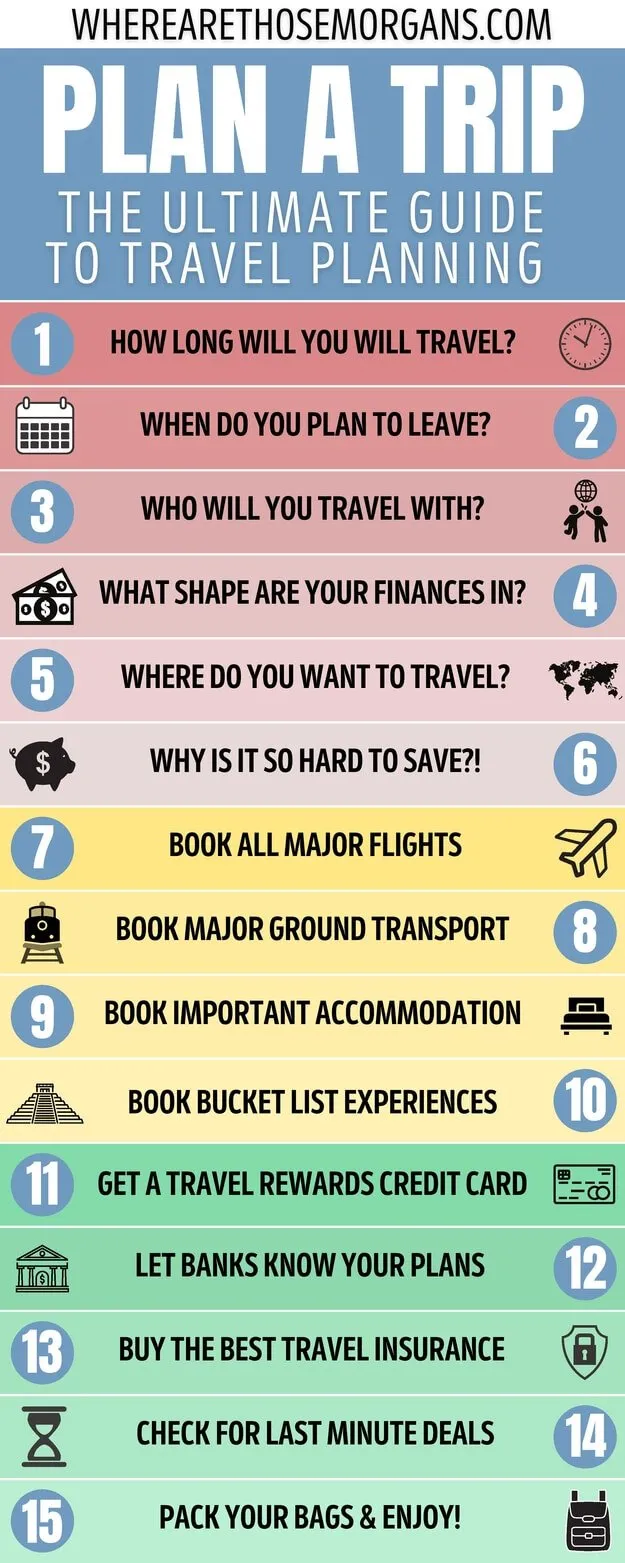
Section 1: Establish Your Travel Goals
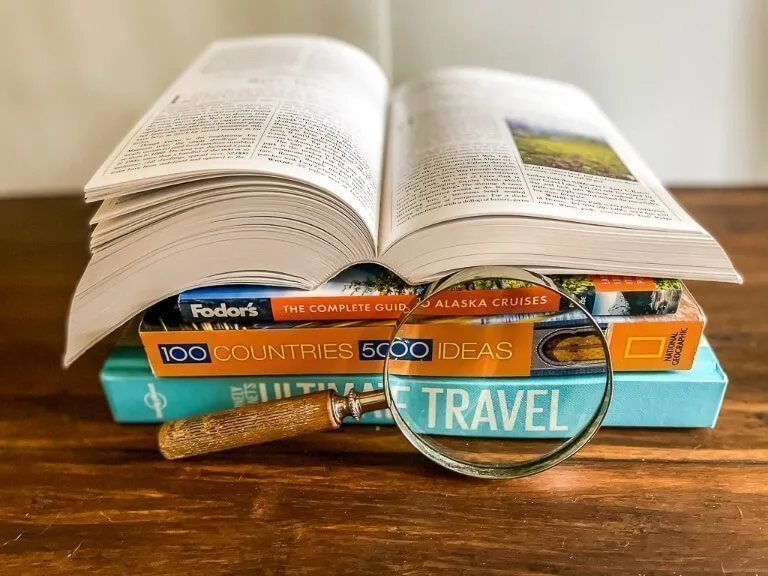
Let’s start at the beginning, the daydream stage.
You know it’s time for a vacation or a long term trip but right now you’re just floating ideas around.
Ask yourself these important travel planning questions (H and 5 W’s):
- How much time will you spend traveling?
- When do you want to leave?
- Who will you travel with?
- What shape are your finances in?
- Where in the world do you want to go?
- Why is it so difficult to save up for your trip?
This is one of our favorite parts of planning a trip because everything sounds wonderful! But before you can book or pack for your potential trip, you need to figure out the basics.
Research Is Key To Planning Effectively
The fundamentals of how to plan a trip begin and end with research.
Every aspect of your plans will require research, from booking flights to buying travel insurance and from packing your bags to visa requirements.
But research starts all the way back at the beginning, before e-tickets arrive in your iPhone wallet and you’re debating between packing your tan vs black shoes.
Research begins with deciding on the most basic of travel planning principles. But don’t confuse basic with a lack of importance. The goals you set at this stage will consequently shape your entire trip.
You will spend a lot of time on google, the same as we do before every trip. If you embrace the research you will do just fine.
By reading this post you are already well into establishing your travel goals and researching travel planning techniques.
That gives you a hand up over other travelers.
You will be more prepared and ultimately have a better trip. The first section of travel planning is designed for you to turn daydreams into actionable reality.
By the end of this section, you will know everything you need to know about the trip you’re going to take. Then, you can start booking!
Consider Your Travel Limitations
We don’t want to rain on your parade but it is critical at this point to manage your expectations and be aware of your travel limitations.
Every one of us is guilty of getting carried away in life, but when it comes to travel planning, be very careful not to take on more than you can chew. Or afford.
Our advice at this stage is to be honest and realistic about what you think is achievable.
- Can you realistically finance a trip to country X and city Y with your budget?
- Is it safe to go to hiking in National Park Z in Winter?
- Do you really want to travel solo or would you prefer company?
- Can you quit your job sooner and still afford your year around the world?
- Are you able to squeeze and extra few holiday days out of your job?

1. How Much Time Do You Spend Traveling?
The thrill of choosing where you want to go on vacation or long term travel is by far the most exciting part of planning a trip. There’s no question about that.
However, before you conjure up your dream Vietnam itinerary or US road trip route , the first piece of the planning puzzle is determining how much time you have on your side.
Time is one aspect of life no amount of money can control.
- On a short beach or hiking vacation from work, will you travel for 7 days, 10 days or 14 days?
- Are you able to take a 3 month sabbatical to backpack South East Asia?
- Or maybe you’ve been thinking about quitting your job to travel without an end date in mind?
- Are your dates flexible or do you have to stick to specific timeframes?
- Do you work remotely or at a physical location?
- Are the kids back in school on Monday morning?
Carefully consider the time you have available and remember there are implications to consider with the amount of time you allocate for your trip.
Example : You will need more money to finance a 4 month trip when compared to 2 months. It sounds obvious, but the point is to ensure you get the balance right between time and travel funds.
Once you establish the amount of time and any specific dates you have to play with, move onto the next planning steps.
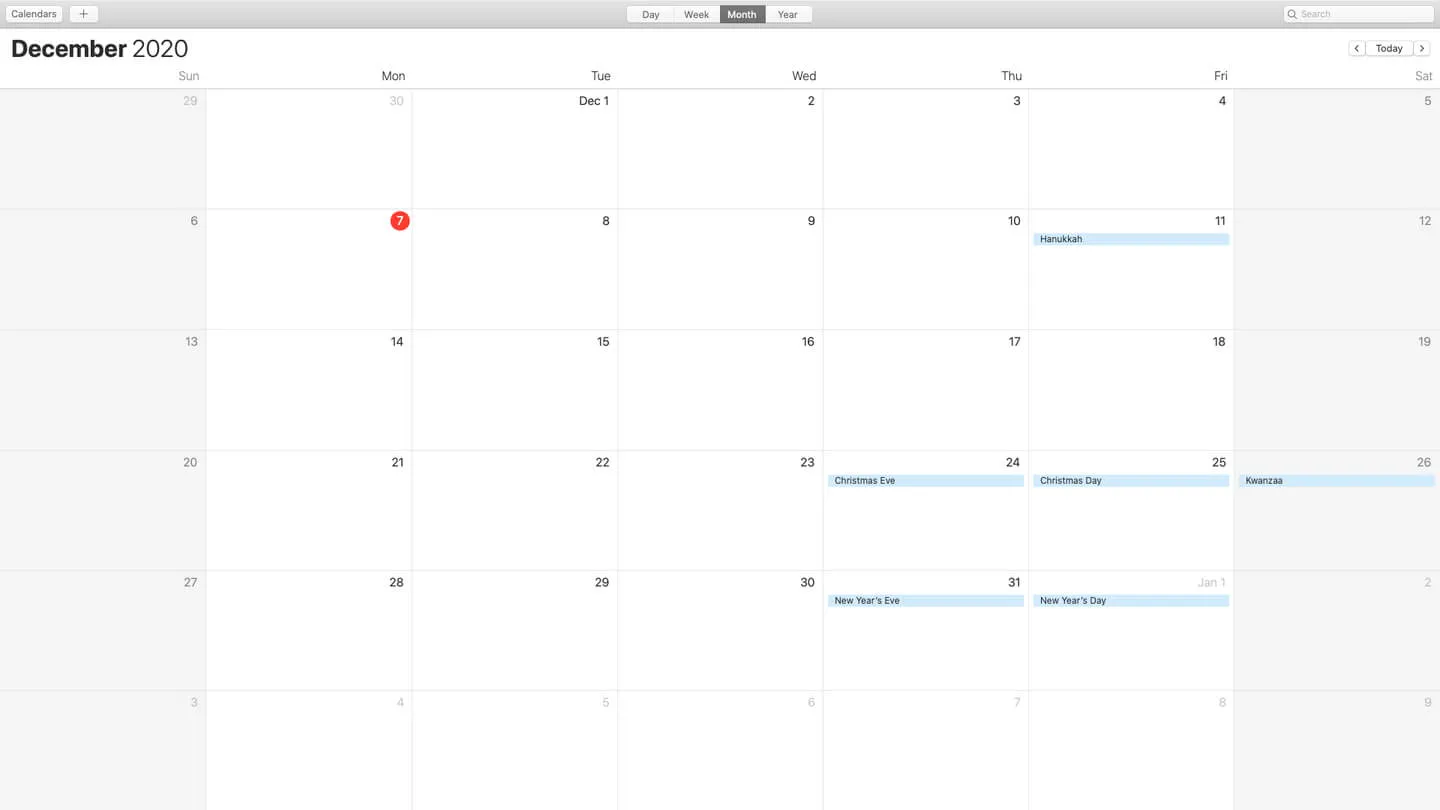
2. When Do You Plan To Leave On Your Trip?
The date you are aiming to leave on your trip is vitally important to your personal travel planning process.
Are you planning a trip way in advance? Or are you last minute planning? The subsequent steps will change focus depending on the answer to those questions.
For those planning a last minute spontaneous trip, you will need to double down and get to work.
Conversely, if you are planning a summer vacation that’s 6 months out, you can relax and take each of the plan a trip step slowly.
It is important to remember that people work more efficiently in different ways.
For us, Kristen works more efficiently when planning early and taking things at a gentle pace, whereas Mark works best under pressure with the clock ticking.
Timing Is Crucial
Consider the timing of your proposed trip.
You will have to account for high, shoulder or low season as well as weather conditions for the time of year you visit and finances will be impacted by how well you plan your leaving date.
Example : Your trip is shaping up to be a 3 week European adventure in Summer. You better believe it is going to cost you! Would you be better off planning to leave in Spring or Fall to suit your budget more appropriately?
If you plan to quit your job in 6 months and travel the world for a year, now is the time to get stuck into planning. A year is a long time and the world is a big place.
Leaving a trip like this until the last minute means you could risk missing out on once in a lifetime opportunities.
Working out the most effective time leave on your adventure gives you the framework to set achievable planning and financial goals .
Remind yourself of the 7 P’s of planning: Piss Poor Planning Promotes Piss Poor Performance.
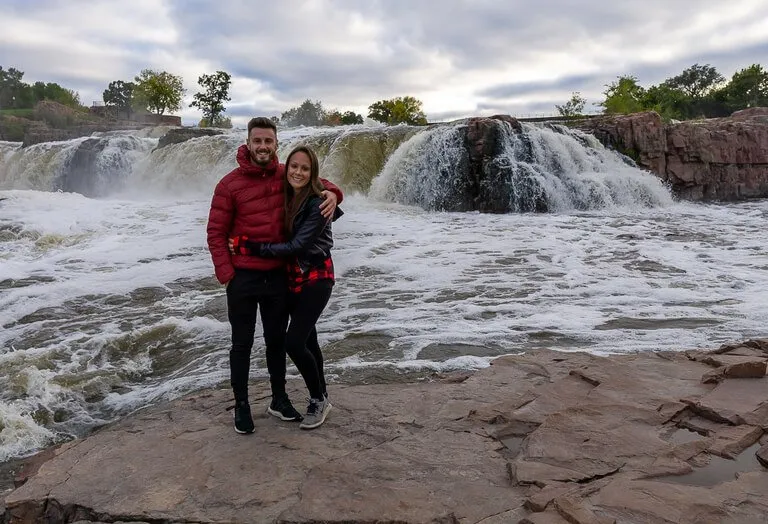
3. Who Do You Plan To Travel With?
Chances are high you already know exactly who you will travel with before you begin to plan a trip. Maybe you’re going on a family holiday or a romantic couples weekend getaway ?
In which case, your travel partners are nailed on. The same applies for us. We always travel as a couple which makes Step 3 obsolete when we plan a trip.
However, many travelers planning trips are undecided between exploring solo or with a friend.
Our world adventures have enabled us to meet hundreds of others traveling. Solo travelers and those traveling as couples or larger groups.
There are pros and cons to all types of travel, just like most things in life.
The important thing to understand for first time travelers who feel anxious about traveling solo is that you will meet people along the way. Even as a couple, you will meet dozens of other couples on longer trips, particularly in Asia and South America.
So, don’t be afraid to plan your dream trip if you don’t have anyone to travel with initially, you will make a ton of friends on the road.

4. What Shape Are Your Finances In?
Working out a rough travel budget is arguably the most important aspect of planning any trip. That remains true if you are leaving tomorrow or in a year.
Take a cautious approach rather than an overly optimistic approach. You will spend more money than you think, trust us on that one.
It’s better to have money left over than run out of cash a long way from home. We’ve seen it happen.
- How much money do you currently have saved up for your trip?
- How much money can you save between now and the date you plan to leave?
- Do you need to get a second job or a second income to bulk your budget out?
- Do you have any cash in reserve in case of emergency?
Before you start dreaming of your 2 week luxury beach vacation to the Maldives or 3 months backpacking through Australia and New Zealand, you need to be realistic about your budget.
Travel Smarter, Not Harder
A good rule of thumb is to consider yours destinations around your budget.
Instead, consider your budget and travel to a place where that same amount of money will allow you to have a much better experience.
See how much we spent in 1 month in Vietnam to use as a reference for travel costs.
If you are planning a short vacation, you will have much more control over finances. You know you’re going to get paid from your job again, so a splurge isn’t out of the question.
In contrast, long term travelers will constantly be checking finances. Once they leave for their trip – that digital bank balance value will decrease every single day until the end.
Travel Tip : When planning a trip around your budget, always always always leave some room for buffer in case of emergency. We’re all used to living to our means and it’s easy to plan down to the last penny but trust us, you never know when you might need a spare US$ 100.
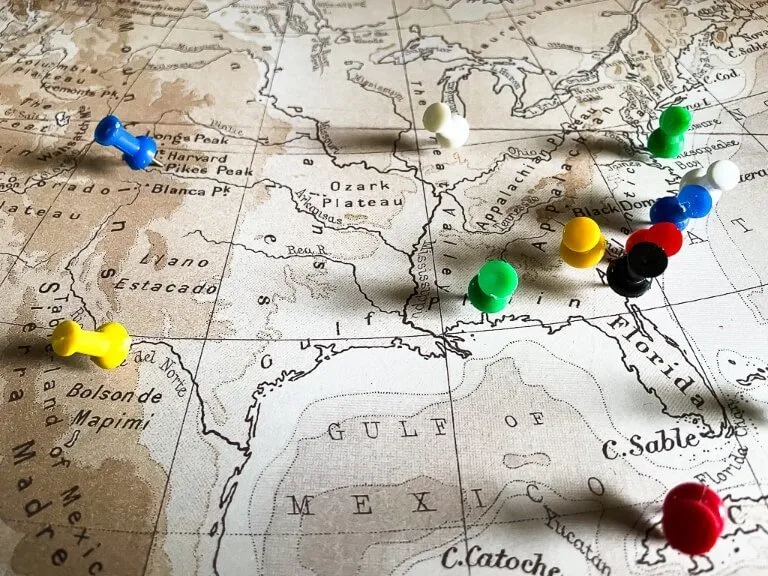
5. Where Do You Plan To Travel?
Now and only now, despite wanting nothing else but to start planning your travel itinerary. It is time to plan your travel destination and route.
You will thank us for leaving you hanging this long because now you have a firm grasp on your travel budget, whether you will be traveling alone or with a group, how long you can travel for and when you want to leave.
Here are some of our top travel inspiration suggestions :
- Grand Teton and Yellowstone National Parks in Wyoming, USA.
- Budapest is a wonderful European city break.
- New York State Parks like Letchworth and Buttermilk Falls are perfect day trips.
- The Atacama Desert in Chile is mind blowing.
- Los Angeles , San Francisco and San Diego are awesome cities to discover.
- Andalusia in Spain is a stunning region to explore.
- Pacific Coast Highway , Utah and South Dakota are epic road trips.
The beauty of leaving this step until you know your budget is having the ability to plan your vacation or itinerary with a clear understanding of which places are feasible and which places you will have to exclude based on price, distance, safety and so on.
Planning travel itineraries takes a lot of work. We find it to be our favorite and least favorite part of traveling – in equal measure! Excitement and frustration.
It is vital you consider public transport routes, airports, safety, hotel availability, time of year, activities on offer, food and so much more.
Choosing A Travel Route
A question we often get asked is: “How do you know where you want to go?”
We do something our ancestors have been doing for over 2000 years: Look at a map!
Seriously, buy a huge map and stick it on your wall. Study each continent and indicate places you would love to visit using pins or colored sticky notes.
If looking at maps doesn’t help, here are some excellent alternatives to find travel inspiration:
- Read the wide range of destinations we write about on our travel blog !
- Read other blogs too. There are hundreds of fantastic first hand resources on the internet written by people who have been to the places you want to visit.
- Change up your google searches to ‘the best place to travel in X year’ or ‘the most obscure travel destinations’.
- Be creative, look for specific events, festivals or concerts around the world.
Once you have a shortlist of dream destinations, fire up google maps and prepare to lose yourself for hours. Design mock travel itineraries lasting 10 days, 2 weeks, a month, 3 months or however long you plan to travel.
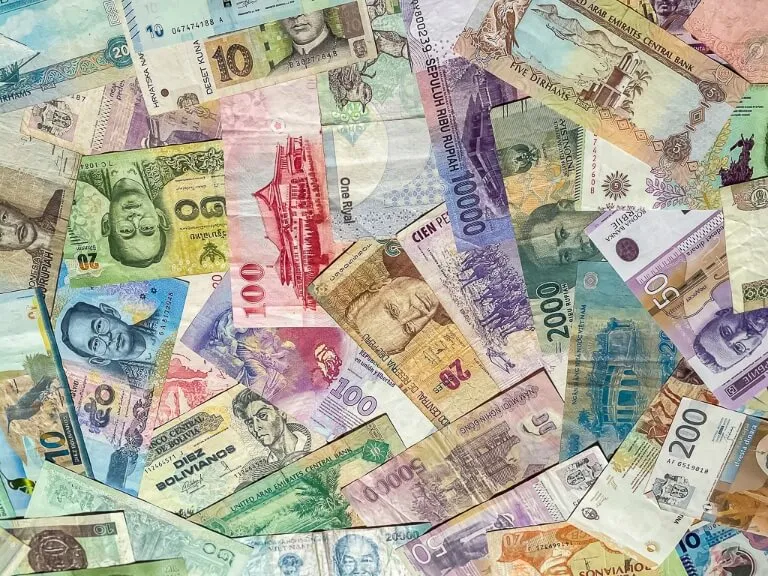
6. Why Is It So Hard To Save For Your Trip?
You’ve meticulously planned your next adventure. Now, you need to stump up the cash to pay for it.
Whether you are going on a one week trekking holiday, a one month live aboard scuba diving course or traveling through Africa and the Middle East for six months, you will need to save up enough money to pay for the pleasure.
You already worked out your finances and travel plans in steps 4 and 5, so you have an actionable target to reach. Is your departure date 3 months away? 6 months? A year?
However far ahead you plan to leave, you might need to put a savings process in place to make up the difference.
Saving for vacations or long term travel is HARD. Your excitement is at fever pitch but time seems to stand still. Days at work start to drag more and more the closer you get to the big day.
Be Disciplined
The key to financial success can be found in one simple word, Discipline .
It’s easy to start well with the best intentions but it’s equally as easy to lose focus. Put yourself on a strict no-spending regime if you don’t have the money in savings to pay for travel costs in advance.
Make judgement calls on every single expenditure – is it want or need? Do you want that thing or do you genuinely need it?
If it’s a want, don’t spend the money, save it. Be disciplined .
Once your bank account begins to swell, fight the temptation to ‘treat yourself’. If you think you won’t be tempted, think again.
That 80″ TV you wanted is only US$ 1,000 and you now have 10 of those saved for your trip – can you get by on US$ 9,000?
No you can’t! Put the TV back! Be disciplined .
Plan A Trip Section 1 Complete: Your Tentative Travel Plans Are In Place
You are officially one third of the way towards being travel ready.
There are more challenges to come but you’ve nailed down the hardest part of travel planning.
Narrowing down where to visit and formulating the perfect itinerary is by far the most difficult part of planning a trip for us.
The word perfect was used for a reason, we both have FOMO (fear of missing out) so it takes us an age to finalize our trips.
With the whole world as your travel option, deciding where to go and where not to go can be overwhelming.
Personally, we just take it one step at a time based on our budget and places on our travel bucket list. We systematically include and exclude places, activities and routes until we agree on a winning formula.
Do not feel disheartened when you think you’ve cracked your route and budget but for whatever reason it just doesn’t work out. Go back to the drawing board and start again fresh. You will end up with an even better itinerary.
Section 2: Take Action + Book
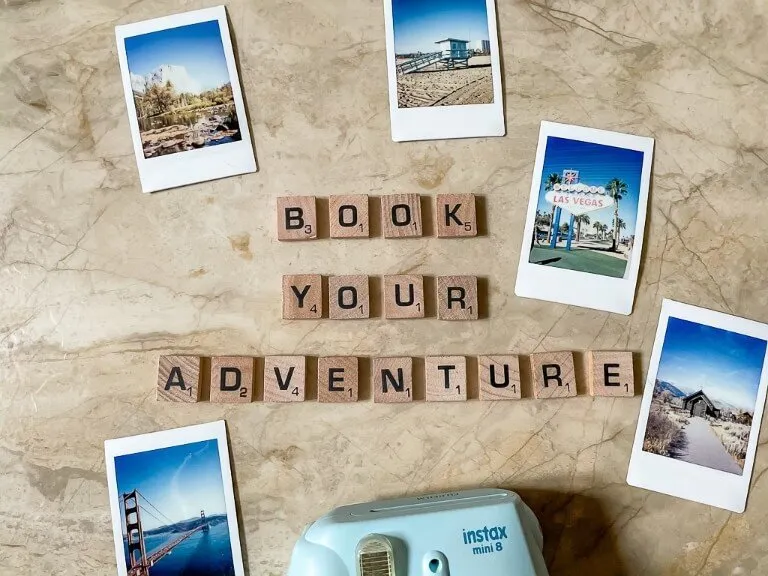
We can all daydream about vacations or backpacking the world for a year. Or imagine ourselves lounging on a beautiful powdery white sand beach in Thailand and hiking into the Grand Canyon .
But until you bite the bullet, until you commit by clicking the buy now button on flights and hotels, a dream is all it will be.
Once you take that giant leap, it becomes tangible.
How many times have you planned a travel route mentally and thought about how amazing it would be and all the things you would do on your trip only to snap back to reality in the office?
Be brave and courageous. Take the plunge and book the important elements of your travel plan. Does this sound like a good story?
“Well, I was going to book a life changing 3 month backpacking trip through South America, but didn’t bother in the end.” That sounds like missed opportunity to us!
Myths About Booking In Advance
Like many other things in life, travel planning gets easier with experience. You learn which aspects of the way you planned and booked your trip worked and which aspects caused problems or lost you money.
However, one thing even the most savvy or accomplished traveler doesn’t always get right is how much of the trip to book in advance.
Here’s the problem travelers face on every trip:
If you book in advance, you plan ahead, book all hotels, buses, trains, activities and flights on your trip.
But what happens? You have no flexibility. If you love a place, you can’t stay longer. If you hate a place, you can’t leave immediately.
And if you don’t book in advance, you plan nothing and have complete flexibility. But you spend all of your travel days booking the next place to stay that night or your flight the next day.
Last minute flights and hotels will have far fewer options and may have seriously inflated prices.
How To Successfully Book A Trip
Here are a few tips to help you book your next trip:
- Find the perfect balance between being organized and flexible.
- Book all of your major trans-continental long haul flights before you leave home.
- Book any hotel splurges you have identified.
- Book any bucket list activities (such as W Trek in Chile) in advance.
- Leave the rest of your trip open ended.
We meet travelers with binders full of confirmation documents who prefer to plan the entire trip down to the ground, even dinner reservations.
Then there are those who prefer to book nothing more than a one way flight and decide everything on the fly (pun intended).
There is no one size fits all best practice or answer to this relentless travel quandary. It depends entirely on your own preferred travel style.
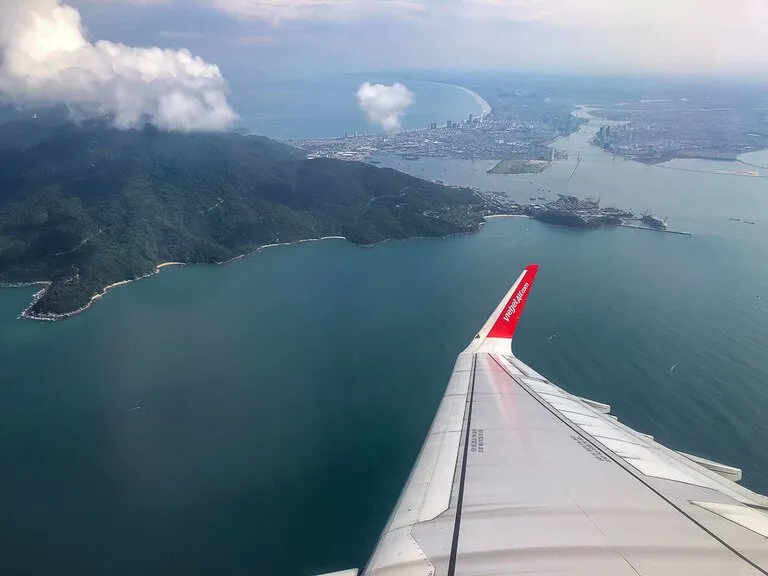
7. Book Your Major Flights To Seal The Deal
Now the real work can begin.
Booking your first flight is the single most exciting and nerve racking moment of travel planning. In one single moment of commitment, you turn your daydream into a reality.
There are numerous flight searching platforms and you can use any you prefer. We personally use – every time we fly and recommend to our friends and family: Skyscanner .
We’ve used each of the major flight search engines and we find Skyscanner to offer the easiest user experience, have the most flight options and consistently lowest prices.
But our favorite aspects of Skyscanner are having the ability (and flexibility) to search for flights by whole month and whole country.
Example: Let’s say you want to fly New York to London.
Instead of selecting an exact date with +/- 3 days (which is what most flight searches offer) you can select by whole month of May for example.
A flight calendar will show the prices of flights on every day that month and between all airports in New York / London.
Check flights with Skyscanner here and start searching for your next flight.
Avoid Flight Price Myths
Booking flights can go one of two ways:
- You prefer to search for a flight, find one at a price you feel is fair and book it.
- You are the type who prefers flight price roulette, playing the algorithm game.
But the thing is you can save money on flights if you put in some research and effort. That being said, there are a lot of myths and legends about booking flights.
Booking International flights on a Tuesday or domestic flights on a Sunday will save big money. Not necessarily true. Prices fluctuate many times a day, week and month.
Clearing cookies and searching incognito will save money. Unfortunately not, no evidence to support that.
Quick Tips On Booking Flights
Our number one tip for booking flights is to be flexible. That’s the way you will save big money.
Look at prices around the dates you want to fly using Skyscanner, you will see how drastically different they can be.
Book your long haul flights as far in advance as possible. The last thing you want is a mammoth cost on your flight home.
Keep an eye on prices 9 months in advance, 6 months 3 months in advance, 1 month in advance and last minute. Watch how much they fluctuate over time.
Research thoroughly, search regularly and build up patterns of prices.
Put flight alerts on specific flights of interest to you. You will receive notifications of changes.
If you see a flight you want and it’s cheap, book it! Don’t wait for it drop by US$ 5 because you’ll find it will go up by US$ 50 instead. Know the right time to pull the trigger.
Flight booking search engines are built on algorithms like everything else online. The key is not to outsmart them, just work them to your advantage.
READ MORE : How to book cheap flight when you travel
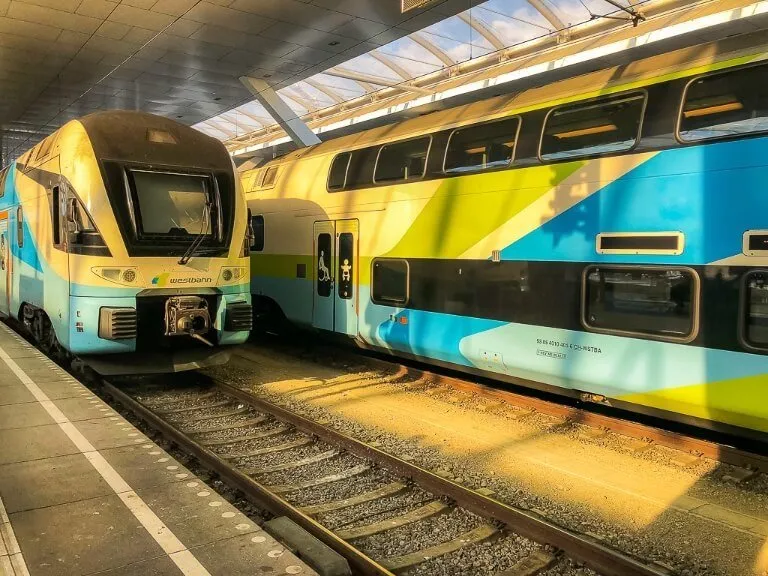
8. Book Ground Transport
Booking ground transport in advance depends on where in the world you are traveling, the timing of your trip, the length of your trip and how rigid and flexible you plan to travel.
Example : When we traveled 3 months in South America, we booked a 24 hour bus from Bariloche to El Chalten in Argentina before we left the UK. But we did not book any sleeper buses or trains in Vietnam in advance.
We visited Argentina in January, during Peak Season. Flights from Bariloche to El Calafate were expensive (and a bus to El Chalten is required) so we took the much cheaper bus.
The bus books up in advance and we wanted to guarantee seats so we booked in advance.
Conversely, we visited Northern and Central Vietnam in October and knew we would be able to jump on any bus or train we wanted. No need to sacrifice flexibility.
Most Cost Effective Transport Methods By Region
- Europe – Cheap budget flights with Ryanair, EasyJet etc between countries / Trains within countries.
- SE Asia – Cheap flights with Jetstar, VietJet, AirAsia, Scoot, LionAir, TigerAir etc between countries / Sleeper Trains & Buses within countries.
- South America – Flights hit and miss for price. We found Chile and Peru had cheaper flights than Argentina. Best way to get around is by Bus but be aware, some of them are LONG!
- North America – Road trip is the best way to explore. Buy a cheap second hand car or hire a car drive point A to B. Trains and domestic flights are expensive. Traveling by bus is a cheap option but not a great one.
The take home is to understand the region you plan to travel through.
How are public transport prices impacted by season? Variations in prices if booking in advance vs last minute?
Example : Let’s say you’re traveling Europe by train but not Interrailing. Booking trains in advance WILL save you money. Do not leave European train bookings until the last minute.
By researching and understanding these things, you can quite literally rescue your travel budget from total annihilation.
If you prefer to drive yourself around a new place to taking public transport, always check prices for hire cars with Rental Cars for most options and best value.

9. Book Accommodation
Booking accommodation can be both extremely rewarding and extremely frustrating.
Some travelers embrace the best deals hunt, whereas others despise losing time trawling through endless lists of hotel prices.
As with all other aspects of travel planning, the key is to find the right balance between how much time you invest and how much money you can save.
There are a limited amount of flights you can choose between, right?
It’s the opposite for accommodation, there are SO many options for where you will sleep at night, no matter where you travel.
If you let it, this process will overwhelm you within seconds. How do you choose between 1000 hotels? When do you stop searching for an even better deal?
The scenario of your trip will affect the benefits of booking hotels in advance.
Example : Beach vacations and resort hotel complexes can go either way. Sometimes you can pick up big money saving last minute deals. It’s a risk but it can pay off.
However, if you’re on a tight budget and backpacking for a month through Thailand in low or shoulder season, it would be worth turning up in person to negotiate a better deal.
Use Hotel Booking Search Engines
Something we find fascinating when we meet travelers on the road is the diversity of platforms everyone uses to book accommodation.
Some swear by Airbnb, others use Agoda or Hostelworld and a high proportion use Booking.com. Personally, we use Booking.com to book our hotels.
We have been using Booking for years and still to this day we are staggered by how many hotel owners pull faces at us or make comments like ‘wow, you guys must have that booking genius thing, this is the lowest price I’ve seen.
We do have Booking Genius Level 3 and you can have it too by simply creating a free account and booking your hotels with Booking.com .
The same applies to Hotels.com, Agoda, Airbnb, Priceline and many others. Find a hotel booking service you like, create an account and reap the loyalty benefits.
That’s not to say hotel search engines have the best prices period.
We ask certain hotels for a price directly and if it’s more than what we can see on our Booking.com app, we simply book a room on our app right at the check in desk.
Quick Tips For Booking Hotels
Similarly to booking ground transport at the trip planning stages, we only book certain hotels in advance before we travel.
Typically, we will book hotels as we go to allow total flexibility. However, there are three scenarios when we book hotels in advance:
- If we plan to visit a big city like London, New York City , Hong Kong or Dubai in shoulder or high season.
- When planning itineraries including rural N ational Park s with limited hotel options.
- Big splurges on a luxury hotel so our travel budget doesn’t take a huge mid-trip pounding.
When searching for hotels, always use filters and sorting to cut through the crap and display exactly what you are interested in.
Search engines by default will display hotels based on featured. So what is featured?
It is hotel search engines listing hotels in their own order, but we like to sort by user rating and review count.
If a hotel has 2,500 reviews and a guest review score of 8.7, we would add it to our shortlist.
Once we have enough hotels in a shortlist we look at their locations, nearby amenities, nearby major attractions and transport hubs etc.
READ MORE : How to book cheap hotels for travel
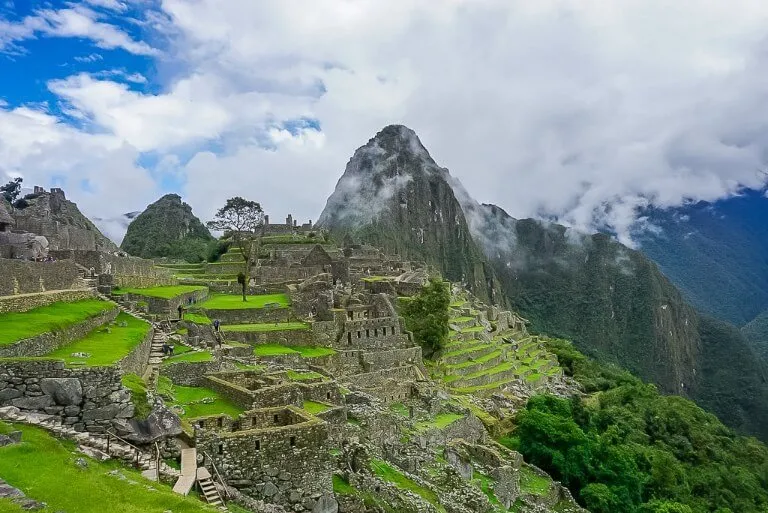
10. Book Bucket List Experiences
Your final bookings at this stage of planning your trip are reserved for any bucket list experiences.
You’ve planned a route through a country or continent, so you should know all of the bucket list places you will be visiting. However, unless you research thoroughly, there’s a small chance you might miss something.
Life is about learning from mistakes.
One of ours when traveling Europe was when we visited Interlaken and Grindelwald in Switzerland but we hadn’t researched things to do before hand.
So we didn’t know about the Jungfrau rack railway line through the Eiger to the top of Europe at 3,454m. Once we discovered it, we’d already spent our allocated budget which isn’t difficult in Switzerland.
Plan major activities ahead. Make a spreadsheet or a checklist, even book some ahead of time if you have to or prefer to plan your whole trip in advance.
The more planning you do in advance, the less you will miss on the road. There are times when you will have no choice but to plan months ahead.
A few examples are the W trek in Torres del Paine (Chile), Half Dome hike at Yosemite National Park (California) and hiking down the Narrows at Zion National Park (Utah).
Not planning ahead will result in missing something epic. If you don’t typically plan things like this in advance, now is the time to learn some new core skills.
Section 2 Complete: Major Bookings Are Made
You’re almost over the hill and it’s plain sailing from here. The hard work has paid off, now all that’s left is preparing and packing for the adventure that awaits you.
Booking flights, transport, hotels and activities is part of the travel planning experience.
Try to enjoy the process. If you feel overwhelmed at any point, step away for a few hours or days. That is a tried and tested method of successfully planning a trip.
There have been times where we’ve had to walk away from planning for a day or two.
Remember, you can book hotels anywhere at any time, you don’t always have to book your entire trip before you leave.
If there’s one particular leg of your journey where you can’t quite make transport work or there are no cheap hotels available, just go back a few steps and alter your route accordingly.
This is a common travel planning stumbling block.
It can be infuriating to have a route perfected, only for something not to work and find yourself back at the drawing board.
But consider this, would you rather be at home with this problem? Or in a foreign city with no idea where to go next, how to get there or where to sleep that night?
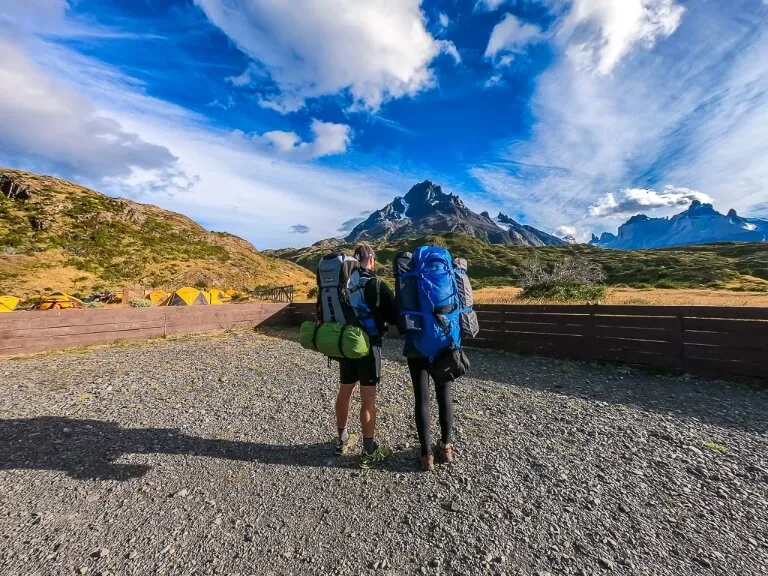
Section 3: Prepare And Pack
You’re on the home stretch. There are just a few important admin tasks to complete before you can finally say you are ready to leave on your trip.
Get stuck into these last few steps as soon as possible, tick the boxes, put your feet up and enjoy a nice cup of Yorkshire tea.
Section 3 of travel planning is about giving yourself the best return on your expenses, travel safety, insuring your property and packing the right gear for your trip.
It would be easy to switch off once you’ve secured your important bookings but you would be shooting yourself in the foot.
Instead, keep the ball rolling into this final section. Use the momentum to make the best choices possible as you complete your travel planning process.
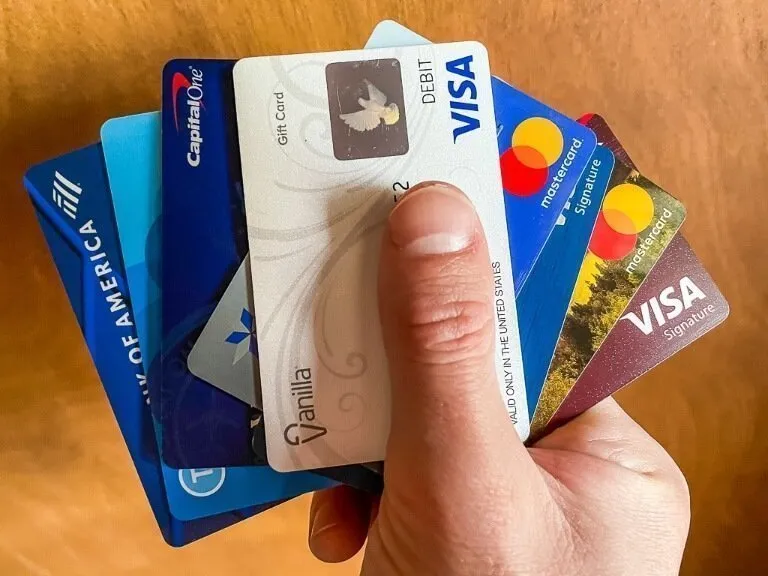
11. Travel Rewards Credit Cards
You might be from a country where paying with debit and credit cards is the norm. Heck, you probably even pay for things with your phone these days.
However, when you travel through certain regions, such as parts of South East Asia, you won’t always be able to pay for goods and services with your cards.
Cash is often king in developing countries or countries with few tourists.
Example : We spent a month traveling North/Central Vietnam and can count on 1 hand the amount of times we paid for anything using a credit card. In order to withdraw cash from ATM’s without incurring a fee, we used our travel rewards credit card.
So, aside from always carrying a handful of US dollars in cash as a safety net, here’s the best money saving advice for any trip you ever take abroad, limit the amount you use your debit card.
If you use your debit account, you can kiss goodbye to your travel budget. The local bank will charge you a fee and your bank at home will charge you a hefty fee. Double whammy. Not fun.
What To Do Before Your Trip
Sign up for a no foreign transaction fee on all withdrawals and purchases travel rewards credit card.
On longer trips you will be taking money out of ATM’s regularly. Local ATM withdrawals will yield better exchange rates than airport exchanges.
Always choose local currency when withdrawing money, not your home country currency.
Research the best travel rewards card before you leave on your trip. Residents of the US are fortunate because competition is fierce, which drives fantastic offers on travel credit cards.
At a minimum, you should be able to pick up a travel rewards credit card giving you 1.5% cash back on all purchases and withdrawals.
Some offer points instead of cash back, which can be saved and used to pay for a flight later in your trip. Look for any special points and bonuses for spending X amount of money in Y amount of time.
Choose the card that offers the best perks for your travel style.
Example : Bank A will give you 1,500 points bonus if you spend US$ 3,000 within 90 days. Those bonus points equal US$ 150 that you can put towards a flight.

12. Tell The Bank About Your Travel Plans
It would blow your mind if we told you the amount of people we meet traveling the world who have experienced blocked credit cards.
Blocked cards in turn lead to no money and expensive phone calls back home to unblock said cards.
The banks are doing it for your protection but when you’re stuck in the back of beyond and can’t pay for anything or withdraw money, you will be in trouble.
Example : You have a Bank of America checking account, a Capital One Venture travel rewards card and an American Express travel card, you need to tell every one of those banks what your rough travel plans are.
It doesn’t hurt to keep them updated as you travel because plans can change.
We will contact our banks each time we move to a new continent and give them a rough idea of the countries we intend to visit, plus an estimated duration. Remember the 7 P’s of planning.
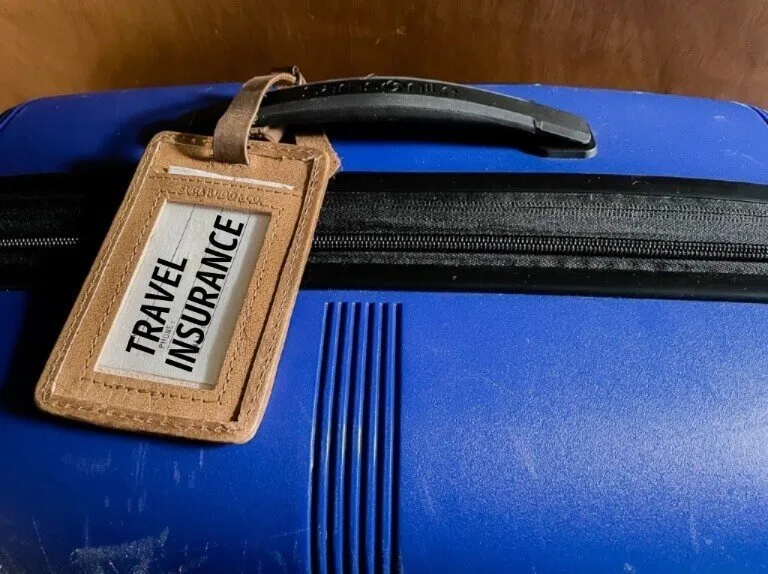
13. Get Travel Insurance
We’re not going to frighten you into buying travel insurance with gruesome tales. We’re simply going to say it is not worth the risk to travel without insurance.
You may be debating running the risk because insurance can be expensive.
We understand, it’s a bit of a blow when you think all your costs are nailed on the head and you see how much travel insurance is going to set you back.
But believe us, skipping it is not the smart move. Especially if you are backpacking for longer periods. Knock on wood, nothing serious has happened to us yet on the road.
No lost backpacks, no serious injuries, no muggings. But that could change at any moment, all it takes is being in the wrong place at the wrong time.
Travel Insurance Is Worth The Peace Of Mind
Could you imagine the cost involved in being repatriated to America with a serious illness or injury sustained on the other side of the planet? No insurance would leave you in financial despair for years.
Example : You’ve just bought a brand new Sony A7R IV mirrorless camera for US$ 3,000 for your trip and you lose it or have it stolen on your first day traveling. You don’t have insurance. Imagine the pain!
There are plenty of travel insurance providers, such as Allianz, AIG and Travelex but right now we use and highly recommend World Nomads.
The company was created by travelers for travelers and they will tailor an insurance plan to suit your trip. You can get a free quote and choose between Standard or Explorer plans.
Be sure to do your own research but use World Nomads as your reference. See if you can get better coverage.
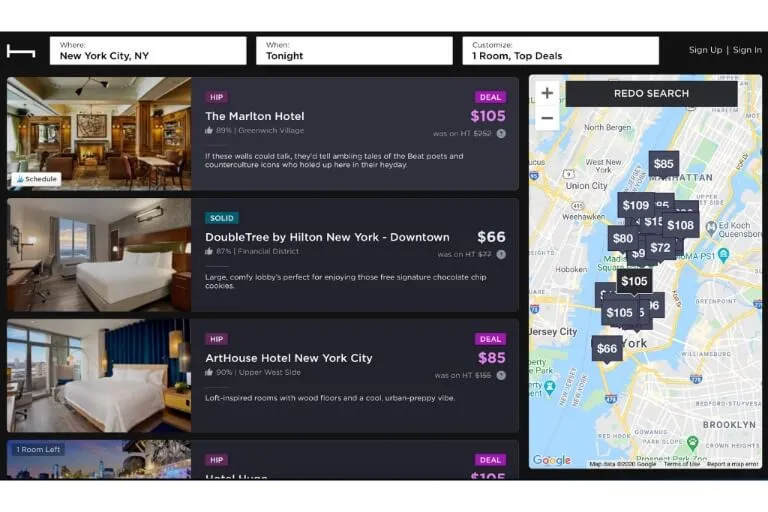
14. Check For Last Minute Travel Bargains
This is where we hope you don’t find an amazing last minute deal that’s US$ 200 cheaper than what you booked back in section 2.
Last minute deals are a gamble. Sometimes they pay off but mostly, they don’t. Never leave any of your major flight routes or bucket list activities until the last minute.
It’s always worth keeping an eye on hotel and flight prices, even for things you already booked that may include free cancellations or free changes to the booking.
If you can pick up the odd money saving last minute bargain, great. But don’t leave your entire trip to chance.
In the days leading up to your departure, check prices on (non-major) flights, trains, hotels and tours that you are interested in taking.
There are always flash sales on things, it’s often a case of being fortunate enough to stumble across them at the right time.
Here’s something important to remember if you started planning your trip months ago. High season might have moved into shoulder season or low season in a place you want to go.
But be aware that the opposite may also occur.
You could have planned on last minute deals because when you were researching the prices looked amazing, only to have unwittingly transitioned into peak season for the place you are visiting.
Last minute deals are going to cost you and your options will be greatly diminished in peak season.
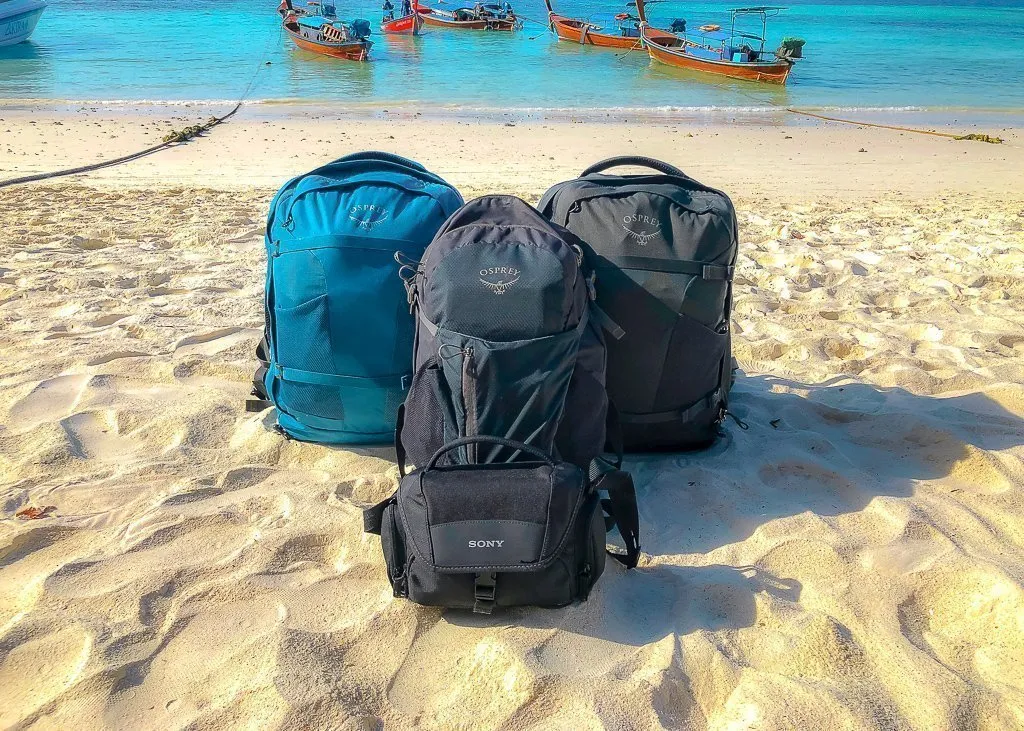
15. Pack Yours Bags It’s Time To Leave
Your travel plans are in place, you’ve booked the important things and prepared efficiently. All you need to do now is pick the perfect backpack and fill it with the right gear for your destination.
If you think you can handle traveling with just 40L of space which means you can carry on to flights, don’t miss this review of our top rated travel backpack, Osprey Farpoint 40 .
For those who will carry a larger main pack and need a second smaller backpack to carry on, read our review of the innovative and versatile backpack perfect for travel photographers: Peak Design Everyday Backpack .
We won’t go into a huge amount of detail with this planning step. Instead, you can find all you need to know about packing for your trips in our detailed Travel Packing resource.
Here are a few addition packing tips for your trip:
- Be sure to pack according to where you’re going. If there are varying climates on your itinerary, pack for warm and cold weather conditions, even if that means taking a bigger backpack.
- Pack carefully, make sure every single item is fit for multi-purpose use. Do not pack fancy shirts and jeans if you will only use them once, you will end up throwing them out half way through your trip.
- We all have our own dress styles and preferences but our best advice for packing is to take plenty of comfortable gear.
Just remember, the most successful travel planners are the ones who can accept when they need to take a few steps back in order to take many steps forward.
More Travel Resources
- E-Books – Shop our travel guidebooks
- Packing List – The ultimate travel packing list
- Gifts – The best gifts for a traveler
Want more travel content? Head to our Travel Blog to discover new destinations around the world.
We hope these 15 steps help you plan the perfect trip!
Please let us know if you have any questions about this trip planning guide in the comments below.
Happy Travels ,
Mark and Kristen
Enjoy This Trip Planning Guide? Pin It For Later!
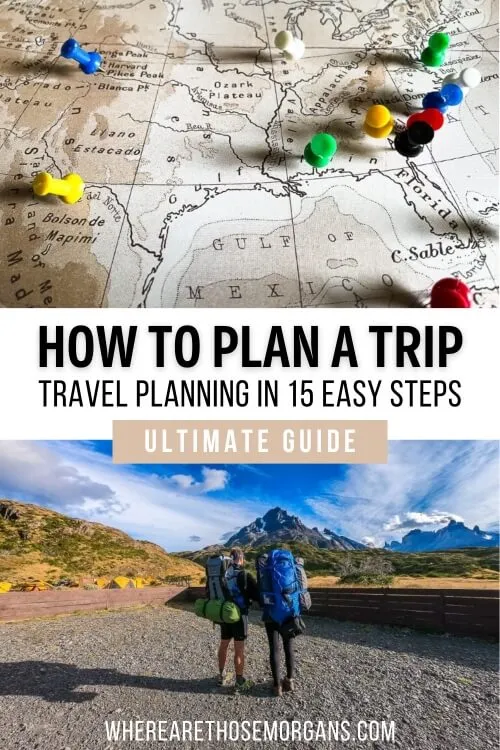
Note : This article contains affiliate links. When you make a purchase using one of these affiliate links, we may earn a small commission at no extra cost to you.
All Rights Reserved © Where Are Those Morgans, LLC. Republishing this article and/or any of its contents (text, photography, maps, graphics, etc.) in whole or in part is strictly prohibited.
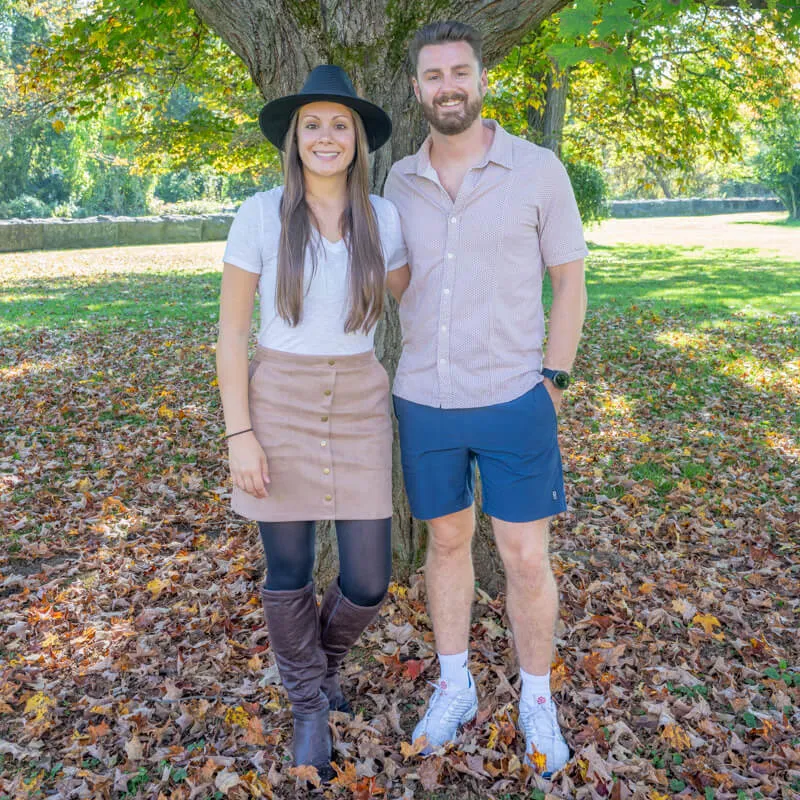
Mark and Kristen Morgan are travel, hiking and photography experts. Over the last 6 years traveling full time, they have explored more than 40 countries and 30 US states.
Where Are Those Morgans has been featured in USA Today, Gestalten, Get Your Guide, CityPASS and Condé Nast Traveler along with various other publications. Read more about us .
Leave a Comment Cancel reply
Subscribe to our newsletter
Get the latest in travel straight to your inbox
Click here to subscribe
- Skip to main content
- Keyboard shortcuts for audio player

- LISTEN & FOLLOW
- Apple Podcasts
- Google Podcasts
- Amazon Music
Your support helps make our show possible and unlocks access to our sponsor-free feed.
How to plan your dream vacation
Sometimes you crave a vacation — but actually taking one feels out of reach. Maybe you're struggling to find the time or save up the money. Or maybe you just can't seem to launch those plans out of the group chat. Overcome that planning inertia and take the big trip of your dreams. Here's where to start your search, organize your logistics and enjoy yourself.

MARIELLE SEGARRA, HOST:
You're listening to LIFE KIT...
(SOUNDBITE OF MUSIC)
SEGARRA: ...From NPR.
Hey, everybody. It's Marielle. You remember the early part of the pandemic when the days of isolation stretched into months? At night, I would lay on the floor of my apartment with my eyes closed and listen to guided meditations, to try to take myself to a happier place. One time the prompt was something like, picture yourself doing something that brings you great joy. The first thing that popped into my head was an image of me wandering the cobblestone streets of some small European village, probably in France. The sun was shining, and every step I took was a feast for the eyes. Medieval houses, colorful flowers resting in vases on outdoor tables, patisseries with gorgeous pastries in the window, just waiting to be eaten.
I didn't realize until that moment just how much I missed traveling and how badly I wanted to look at something outside of my four walls or the blocks of my neighborhood. The next year, I took a three-week trip to the U.K. and France, and I ate those pastries and wandered until my feet hurt and filled a hole that had been growing inside of me.
Big trips can do that. Lale Arikoglu knows what I'm talking about. She's the articles director at Conde Nast Traveler.
LALE ARIKOGLU: On a really basic level, I think it's just being able to have a break from the crush of regular life, whether that's work or childcare or school, wherever it may be, you know, the opportunity to just take yourself out of your routine and be somewhere else and get to immerse yourself in that place to me is, like, the main draw of it.
SEGARRA: Now, when we talk about a big trip, that could mean different things depending on your travel style and your budget. You know, it might be a long road trip or an extended stay at a cottage in the woods or a multi-city tour on another continent. But it's typically something you save up for and plan months in advance. Lale has a big trip coming up. She's going to Peru.
ARIKOGLU: I've been waiting to do it for a long time. The reason to go there is for a friend's wedding. And now I'm building a trip around it, and it's going to be about ten days long with multi-stops, you know, having to choose multiple places to stay. And logistically, you know, it's actually taking some thought and some planning. One of the things that we're going to do when we're there is hike Machu Picchu. There's a group of us going. And Machu Picchu - it's a dream to see and experience.
SEGARRA: Now, it's easy to get bogged down in trip planning. And it might stop you from booking the thing entirely, but Lale says, do it. It's worth it.
On this episode of LIFE KIT, Lale shares her best tips on planning the big trip of your dreams. We'll talk about where to start your search, what logistical questions you should ask yourself and how to actually relax and enjoy yourself once you're there.
SEGARRA: Let's say I do want to take a big trip, right? I'm feeling that itch to travel, but...
ARIKOGLU: Right.
SEGARRA: ...I don't have a destination in mind yet or a duration. I'm really starting from scratch. Where does the planning start?
ARIKOGLU: When you start the planning, you've really got to think what you want to get out of the trip. You know, If you really just want to decompress and relax and rest, then you probably don't want to do some like multi-stop European city trip, right? You probably don't want to hike Machu Picchu. Perhaps it is that you're incredibly bored of your surroundings, and you need adventure and you need excitement. And therefore, you're going to be thinking of some really different destinations. It might be that you're traveling alone for the first time. You've decided to do a solo trip. You know, where is a place that might feel comfortable for you as a solo traveler, but still feels like it's taking you out of your comfort zone? So I think it's sitting with yourself and thinking, OK, what is, like, the goal here? That's takeaway one. Ask yourself what do you want to get from this? Set the mission of your trip.
It feels like another really important detail at the beginning is budget, right? Like, how much money do you realistically want to spend on this trip or can you afford to spend?
ARIKOGLU: And, you know, that's going to look different for everyone. If we're talking big trips, rarely are they spontaneous, right? You're planning for a long time. So that also allows you to save and finance for it. No, there's lots of great savings apps that can just, you know, that take a little bit of money out of your paycheck every few weeks, and you can kind of start, like, a travel fund that way. I think that's quite a nice way to do it. But I think, you know, you can do a big trip on a budget. It doesn't have to be, I think, a lavish, international trip. I mean, you know, we're going into spring and summer, there are so many incredible national parks to see, there are so many amazing, very diverse, different cities. There's, like, so much on your doorstep, so I think you can really argue, you don't have to cross continents to have a big trip. And so if that feels a more affordable way to get away for a couple of weeks, then, you know, look in your backyard.
SEGARRA: Right. I wonder, too, like, part of budget, besides money, is also time. Like, how much vacation time do you have? Do you have any tips for people who don't have that much vacation time?
ARIKOGLU: So I think if you look at the calendar and you look at where the holiday weekends fall, There are some tricks to being able to kind of, like, turn your limited number of vacation days into - kind of you can stretch it out if you bookend it with a holiday weekend or something like that. But on the flip side, it's also most expensive time to travel, right? There is an argument for choosing shoulder season, so that's not traveling to a destination when it's at its peak. And this is great for your own personal experience, but it's also in terms of helping that destination deal with overtourism, overcrowding. If we're talking about Europe, for example, the summers are getting hotter. So avoiding those really intense, hot, summer seasons can actually be really advantageous for your own travel plans.
SEGARRA: Yeah. That seems like maybe the next thing to consider as you're planning a big trip before you start looking at destinations is what time of year are you looking to travel?
ARIKOGLU: Definitely. And that's more of a luxury for some people because If you're having to navigate school holidays, then you're a little bit more limited. But again, it's sort of when you're thinking about carving out those goals and what you want to get out of the trip. Maybe it's the seasonality that's really important. Maybe it's all you want is hot weather and a beach. You know, if you're planning some summer travel, you could totally flip things on its head and go experience winter somewhere. I went to Patagonia when it was entering into their fall in Chile, and it was a really magnificent time to be there, and it was when New York City was going into spring. It felt like upside-down land to be choosing to do that, and it was so wonderful. It was great.
SEGARRA: Yeah. I think there's a lot of room for creativity there. And also, as you said, like, it opens up more possibilities if you consider going places during the shoulder season.
ARIKOGLU: And you get to be in a place and actually be in the place with the people who live there. One thing in August, if you go to Europe, everyone who lives there has, you know, gone off somewhere else on vacation to escape the heat and the tourists, and so, you know, you're in Rome with just all the other tourists and none of the Romans.
SEGARRA: All right, so takeaway two. Before you land on a destination, think about your constraints. What time of year do you plan to travel? For how long? What budget are you working with? If you're short on time, you can make use of holidays or pick a destination closer to home. If you're short on money, think creatively. You know, maybe you do a road trip through some parks or cities nearby.
SEGARRA: It seems like another thing to consider here is, how much do you like crowds? Because for me, it kind of ruins a trip or an experience if everywhere I go is super crowded. I get very overwhelmed by that and overstimulated.
ARIKOGLU: And it's also, you know, who are the crowds? Because there's been times when I've gone somewhere and I've gone and done the same bucket list site that everyone else is, and you're sort of standing there and you're thinking, What am I actually here for? Well, what is the purpose of this? What am I getting out of it? What am I giving to this destination other than just being another member of the crowd?
SEGARRA: Yeah. I think that's an important question, right? 'Cause, like, we have been talking about what are you looking to get out of it, for the most part. But there's another side to this - right? - and it's what am I giving? And also, what am I taking? Like, am I taking too much from this place?
ARIKOGLU: I think about that a lot. When you're planning, be really thoughtful about where you're spending your money. When you're choosing a hotel, is it a hotel that is locally owned? What restaurants are you booking? Where are you shopping? Where are you buying your souvenirs? You know, I think there's lots of ways to be really thoughtful about, you know, how you spend your money, and that can go into your budgeting, as well.
SEGARRA: I know there are certain places that at a certain time, at least, they said, please, tourists, like, please stop coming or stop coming during this time.
ARIKOGLU: Yeah. When a destination says that, I mean, it's something to be taken so seriously because they're usually destinations that have an infrastructure or an economy that really relies on tourism. So things have to have gotten pretty bad for a destination to say, take a beat, not right now, and listen to that, and, you know, the place will be better for it when you do go see it.
SEGARRA: I picture it as if you were, like, going to - going over, like, a friend's house uninvited, or, like, if they were like, please, today's not good. Like, our whole family's sick, like, we're all throwing up, and then you were still banging on the door, like, hey, what are you doing? Can I come stay over?
ARIKOGLU: I think that is a perfect analogy. Perfect. And no one wants to be that person.
SEGARRA: No.
ARIKOGLU: I'd hate to be that person.
SEGARRA: That'd be weird behavior.
ARIKOGLU: Yeah.
SEGARRA: Takeaway three, travel responsibly. Research the places you're interested in, and make sure they want tourists at the time you're looking to visit. When you're booking, consider putting your money toward the local economy rather than international chains. Also, learn about whatever destination you choose. Be open to the cultural practices and languages there. And be a respectful visitor.
Anything else that people would want to figure out before they start narrowing down or looking at destinations?
ARIKOGLU: I think it's also thinking about who you want to travel with. Someone can be your best friend, but they can be your worst roommate. I think travel's kind of the same, so kind of finding someone to travel with or a group of people to travel with who you're aligned with in the planning stage, rather than when you get there and then you suddenly discover you all want to do different things. So I think communicating right off the back what you all want out of the trip and what you're excited about and also being really honest with each other about finances.
If you're on a group trip, I mean, it's like splitting the bill, but a thousand times worse. And so I think if you can kind of, like, set some parameters at the start and be really honest about what you feel comfortable spending money on because inevitably, there is going to be some people on the trip who want to spend more money on some things than others.
SEGARRA: Yeah. And it seems like that conversation, there should be some form of that before you book anything.
ARIKOGLU: Yes, 100%. And, you know, I think even if you don't feel comfortable doing it, speaking up if something just feels too expensive.
SEGARRA: All right. So takeaway four, figure out who you're traveling with. You might prefer to travel alone, or if you're going with friends, partners, or family, just make sure you're on the same page about what you want from the trip - the pace, the activities and how much money you can spend.
SEGARRA: OK. So it sounds like we've given people a lot of things to consider before they choose a destination. Once they've done this soul searching, how can they start to find destinations that fit those desires and limitations?
ARIKOGLU: For me, part of the fun of travel planning is doing the research, whether it is a trusted travel publication or reading some books you love or going on to - you know, there's, like, a ton of just, like, online communities of people who love swapping travel tips and actually, I think, can be really helpful.
SEGARRA: Yeah. I think it can be helpful maybe to in the brainstorming stage to just, like, not go in too deep but just make a list of places that seem exciting to you and that might fit your parameters. Like, I have a Google Doc, and it's just, like, places that I would be really excited to go.
SEGARRA: When you are considering a destination, how helpful is social media - is - like, seeing where your friends are going or where influencers are going? Is it a good idea to follow those trends?
ARIKOGLU: I think it can be useful in picking things you want to do once you're there, particularly if it's, like, based around, like, big events or openings. You know, we have our best places to go list that runs every year. It could be, like, new train routes, new hiking routes, new museums that have opened, things that are happening in destinations centered around an anniversary. So, you know, kind of consulting those sorts of lists and rounds up as well can be very helpful. But I think, you know, going back to what we were talking about in terms of over tourism or overcrowding - you know, on social media, you will see people at the same spots time and time again. And they're usually spots where just around the corner, there's also something equally beautiful to see.
SEGARRA: Yeah. Like, I remember when Santorini was really popular. And it's like, whew - like, if you could actually see what was going on behind that photo, like, you would hate being there because it's so - it's just way too many people...
ARIKOGLU: Right. Right.
SEGARRA: ...All lining up to take a picture in - against that beautiful backdrop.
ARIKOGLU: Exactly. And, you know, it's Santorini. It's all beautiful. It's all amazing.
SEGARRA: OK. So takeaway five is to choose a destination. And cast a wide net when you're brainstorming 'cause you never know what's going to catch your eye. Also, Lale says, do your best to think outside of the current travel trends. Though you can use them for inspiration.
So once you've got a destination in mind, how can you start to sketch out the details of the trip? And I guess I should say, how much detail do you really need to figure out?
ARIKOGLU: So I was going to say, don't overschedule yourself, and don't overbook yourself. I think I've been guilty of doing that before, and then you realize that you have no downtime. It might seem like you're being really efficient, but you need a little bit of spontaneity on your trip. Don't overschedule. If there are a few key things you really want to do that you feel you will be crushed if you don't get to do it, then book it. Make sure that's arranged all in advance. So maybe it's finding one thing on each day of your trip. That's what you center your day around and you can frame your itinerary around that, but I wouldn't overschedule.
SEGARRA: Yeah. And then I think when you look at these things potentially sketched out on different days, then you say like, you know, that seems too busy. What's the most important to me here? Like, which of these activities do I want to book ahead?
ARIKOGLU: Right. You know, if you're suddenly realizing - you're like, I am cramming a lot in if I try to go to these three places, then choosing which one to let go.
SEGARRA: Yeah. 'Cause that's always a consideration, too. Like, if you're flying somewhere far, you might think, well, I'm already going to Poland, should I also do Germany?
SEGARRA: There's that impulse, you know? Or I'm going to Poland, so I want to see all of Poland. But that can make for a very frenetic kind of trip.
ARIKOGLU: And you wouldn't tell someone who was visiting America to be like, well, you've come all the way to America, so if you're going to New York, then you also need to go to New Orleans.
SEGARRA: Right, right. Exactly. That's Takeaway 6 - keep your schedule light and malleable. Lally recommends picking only one activity to do for each day of your trip and then building a flexible itinerary around those.
You know, it occurs to me that another element of a big trip when I'm going into them - I know that something's going to go awry during it.
ARIKOGLU: Always (laughter).
SEGARRA: Yeah.
SEGARRA: I remember being in Barcelona when I was in college. I went by myself for, like, a week. And I speak Spanish, but it wasn't fluent at the time. And I just got - I just missed being able to easily say what I wanted to say, and I went into, like, a Wendy's or something because I just wanted something kind of American. And I got some chicken nuggets. I couldn't think how to say nuggets in Spanish. Like, I was like, is that even a word, like, in Spanish, or did they just say nuggets? And I just broke and started speaking in English because I was trying to only speak Spanish. And I was like, I give up. Like, can I get some chicken nuggets, please?
ARIKOGLU: The true American in you comes out screaming at chicken nuggets in a foreign McDonald's.
SEGARRA: Yeah, yeah, give me my nuggies.
ARIKOGLU: (Laughter).
SEGARRA: Yeah, I just - like, sometimes you just need to go roll up into a ball and eat your chicken nuggies and be by yourself for a minute and then come back out, you know?
ARIKOGLU: Yeah. I mean, like, travel so much of the time is sort of, like, infantilizing because you're so powerless. But it's, like, the same in an airport. You're just sort of powerless at a certain extent when things go wrong. And I think my approach to it - to sort of very taxing and challenging air travel schedules, with connections and potential miss flights and lost luggage and all the things that come with that - is to sort of just give myself up to the airport gods, and just as soon as I'm, like, through TSA, just be like, what will be will be. I'll get there eventually and just, like, I'm powerless. And that's been, like, for me, quite liberating. And it also means that I'm not the person screaming at some poor gate agent when things go wrong.
SEGARRA: Yeah, it's a moment of - it's actually an opportunity for mindfulness. Like, I think that could even be helpful going into a big trip, to tell yourself, like, something is going to go wrong. Yeah, just keep that in mind.
ARIKOGLU: Oh, my God, so much of travel is about being tired and hungry.
SEGARRA: We're really selling this.
ARIKOGLU: I know.
SEGARRA: (Laughter).
ARIKOGLU: I'm like, my whole job is to travel. It's great.
SEGARRA: Isn't it terrible? Yeah.
SEGARRA: I try to remind myself, like - what is the point? - like, go back to those goals. What is the point of this? It's to have a good experience, to meet those needs, to give myself what I've been craving.
ARIKOGLU: Exactly. And I don't know. This sounds a little cheesy and a little trite, but anyone who gets to travel is really lucky. Ultimately, it's a real privilege that you get to do it. And it's such a freedom and it's such a special thing.Don't make it stressful.
SEGARRA: That's our final takeaway. Something on your trip is bound to go wrong. So once you're there, sit back and try to surrender. After all, traveling in the first place is a treat.
SEGARRA: OK, jet-setters, time for a recap. First, figure out what you want from this vacation. Decide your budget and time constraints. Commit to traveling ethically. Make sure you're aligned with the people you're traveling with. When you choose a destination, cast a wide net and have fun with the research. Don't overschedule yourself, and once you're there, relax and roll with the punches. For more LIFE KIT, check out our other episodes. We've got one on how to find cheap flights and another on how to pack your suitcase like a pro. You can find those at np.org/lifekit. And if you love LIFE KIT and you just cannot get enough, subscribe to our newsletter at np.org/lifekitnewsletter. Also, we love hearing from you, so if you have episode ideas or feedback you want to share, e-mail us at [email protected].
This episode of LIFE KIT was produced by Margaret Cirino. Our visuals editor is Beck Harlan and our digital editor is Malaka Gharib. Meghan Keane is our supervising editor and Beth Donovan is our executive producer. Our production team also includes Andee Tagle, Clare Marie Schneider and Sylvie Douglis. Engineering support comes from Robert Rodriguez. I'm Marielle Segarra. Thanks for listening.
Copyright © 2024 NPR. All rights reserved. Visit our website terms of use and permissions pages at www.npr.org for further information.
NPR transcripts are created on a rush deadline by an NPR contractor. This text may not be in its final form and may be updated or revised in the future. Accuracy and availability may vary. The authoritative record of NPR’s programming is the audio record.
Account Options

- Scenic Drives
- Road Trip Planner
Road Trip Planning Made Easy
Create custom day trips, weekend getaways, and cross country adventures worldwide
Powerful features for planning your epic road trips (and the shorter adventures in between)
Unlimited stops.
Add unlimited stops and sub-stops. Combine your own stops with our pre-planned routes and recommended places of interest.
Smart Scheduling
By the minute, hour, or overnight, set preferences for each stop. Export your trip to your own Calendar.
Set Vehicle Type
Car, RV, camper trailer, truck, motorcycle, pulling a boat? Get a realistic estimate of driving time. Adjust travel speed by percentages for each unique situation.
Divide Trips Into Days
Divide your trips into manageable driving days based on your custom settings by time or distance. And of course you can customize each day differently.
Route Preferences
Configure route preferences such as avoiding highways or tolls for each day or any segment of your trip.
Use Any Device
Plan trips from your desktop computer, iPad, Android tablet, and mobile phone with the same easy-to-use interface. No app to download or software to install.
Automated To Do List guides you through the road trip planning process.
Manage Your Budget
Track expenditures before you go and along the way. See a summary of expenses for entrance fees, activities, restaurants, and lodging, etc.
Gas Calculator
See the estimated fuel cost for your vehicle type.
EV Charging
Find EV charging stations along your route. Get reminders to recharge. Use Charging Ranges to display icons on the map where your vehicle will require recharging.
Export Options
We support Google Earth (KML), Garmin Communicator, BaseCamp and MapSource (GPX), Co-Pilot Live (TRP), Microsoft Streets and Trips, TomTom itineraries (ITN), TomTom Places of Interest (OV2), Comma Separated Files (CSV), and Tab Separated Files (TSV).
Directions on paper come in handy. Print your road trip with turn-by-turn maps and full directions, divided into your day-by-day itinerary.
Is This Really Free?
Yes! It is free to use our Scenic Drive Itineraries and Road Trip Planner. Please consider purchasing your National Park or National Forest passes on myscenicdrives.com.
Why Do I Need An Account?
A free account is only required for the Road Trip Planner, enabling you to create, edit, and save your trips. Your account is secure. We never share your information.
Do I Need to Download An App or Install Software?
No app or software is needed. myscenicdrives.com works in any browser. Simply go to myscenicdrives.com
More Resources
Documentation, myscenicdrives.com, how it works.

You will be redirected to your dashboard shortly. We will also call you back in 24 hrs .
- How To Plan A Trip In 5 Simple Steps
23 Mar 2023
It is an adventure you’ve always dreamt of, but haven’t been able to plan and execute properly. Here are some useful pointers on how to plan a trip, that put an end to the cluttered chaos by streamlining your vacations to perfect harmony and pure bliss.
Vacations often start off as a wonderful idea and then eventually end up being a nightmare to manage. Often overlooked, a lot of thought and brainstorming goes into perfectly organizing touring plans. The lack of know-how on how to plan a trip often reflects during “unseen hurdles” on a vacation.
With a little bit of preparation and effort in maintaining a personalized trip planner, travelers can overcome 90% of their difficulties they may face during a trip. Here are some handy trip planning tips that will keep your prepared for the proverbial rainy-day.
1. Pick your destination
If you are wondering how to plan a trip with friends or family than you should probably start from either some stunning pics that gone viral on social media, the scenic setting of a movie, or an irresistible story of a friend’s last trip abroad. Touring plans, more often than not, are triggered by external factors.

Image Source
Must Read: 30 Travel Hacks You Must Know If Just-The-Girls Trip Is On Your Mind
Things to keep in mind before selecting a destination
- There’s nothing to say when a traveler’s mind wishes to visit the beaches, mountains, or a forest. However, picking the right destination according to the season is a key factor in understanding how to plan a trip successfully.
- Check out the best time to visit all destinations. Usually, the ideal season to visit beaches and mountains is completely different.
- Consider the cost factor while picking a destination. Some places are more enjoyable in a luxury budget than others. Going to a luxury destination during the shoulder season (a few weeks before or after the official ‘busy season’) can result in some good discounts on hotels and flights.
- Safety of travelers is a prime concern people specially when you are concerned of how to plan a family vacation. Pay attention to it before stating off the journey (especially when female travelers are included).
- Ease of accessibility or lack thereof is also a factor that can sway the decision of visiting a destination or not. Generally, the popular destinations have a lot of daily flights, trains, and good highway infrastructure to support the tourist influx.
2. Decide the duration of your trip
There is a fine line between getting bored and enjoying every moment at a destination. However, no destination has a predefined ideal duration. Wondering how to plan your road trip? It often depends on the touring plans and purpose of the visit of the travelers. Some travelers like to see new cities every day, whereas some travelers prefer taking it slow by witnessing and enjoying the subtle nuances of places they visit. This is a key aspect of your trip planning which can help your itinerary and budget both. Additionally, Travel Triangle also offers customize itinerary so if you are concerned of how to prepare an itinerary for a trip, no worries!
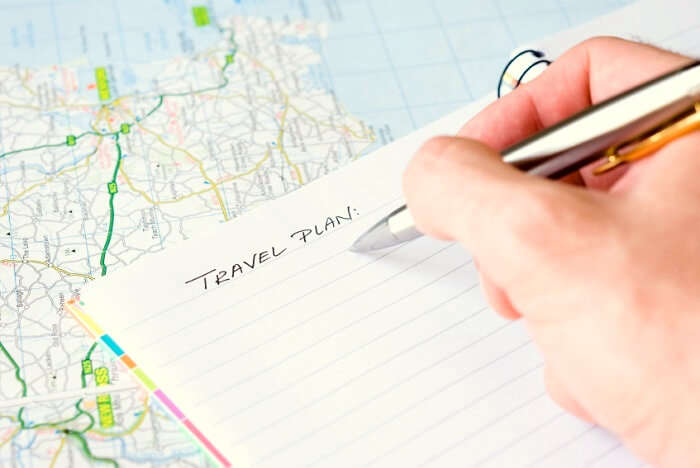
Suggested Read: Things You Ought To Know Before Traveling
Things to keep in mind before deciding the duration of a trip
- A key aspect of a good trip planner is to correctly estimate the number of days required to visit a destination. A road trip planner would elongate the duration of a trip whereas, a trip planned with flight tickets could be a little shorter.
- Trips, where the destination is within 8 hours, can also be done on a weekend provided that the night time is utilized for traveling.
- A trip with a lot of urban destinations will need more time in the sightseeing, and therefore a longer trip duration. Whereas a trip to a tropical beach town would not involve much sightseeing and hence, the duration can be shorter.
- It is advisable to keep a vacant day in touring plans that exceed 7 days. This gives a buffer to things like flight/train delays, traffic jams, weather hold-ups, or a change-of-heart to extend one’s stay at a particular destination.
3. Book flights, train, or bus tickets, and accommodation
After the ideation is complete, booking tickets for your flight, train or bus transfer well in advance is an important step in learning how to plan your trip to perfection. Since flight and train tickets are subject to availability and prices rise over time, getting the bookings done a few months in advance will help you avoid additional costs on your initial budget. Whether you are planning to explore the hidden places in Goa or savour the local flavour of Rajasthan , advance booking can help you with a hassle-free journey.

Suggested Read: 10 Packing & Luggage Hacks For The Smart Traveler
Things to keep in mind while booking transfers and accommodation
- Only book the cheaper non-refundable flight or train tickets if you are absolutely certain of your vacation plans. Otherwise, it is advisable to book refundable tickets if booking well-in-advance.
- Flight prices fluctuate a lot, keep a track on flight prices by using Google Flights Tracker.
- Expect a surge in prices of flights and accommodations if you are booking tickets for a vacation that falls during the peak season of that particular destination.
- Use credit cards that give frequent flyer miles and points on every rupee spent on booking flights and hotels to earn great rewards and cash-backs.
4. Plan the day-wise activities and course of action
It always sounds fascinating and adventurous when touring plans are made on a sudden impulse and gut feel. However, the downside of going on such trips is that there could be many days where the scheduling can go haywire because of everything being so last-minute.
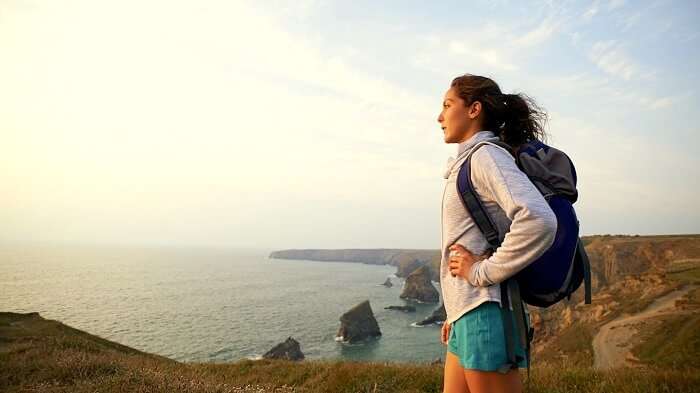
Suggested Read: Travel Etiquettes Around The World
Things to keep in mind while planning day-wise activities
- Depending on the budget and time-at-disposal, getting a rough idea of what activities should be done on what day is a vital ingredient in understanding how to plan a trip perfectly.
- Transfers between destinations should be kept as much as possible during the evening/night. This will provide enough time for sightseeing and activities as most of them are only possible during the day-time.
- Most of the times, it is better to book activities like water sports, adventure sports, boat-rides, and safari rides at the destination itself to get a better price and some scope for bargaining.
- In the trip planner, keep only one or two activities in a day if the purpose of the trip is to relax and take it easy during the vacation.
- At some places, popular tourists activities like skiing, boating, scuba diving etc are closed during offseason. Check the availability of activities before going to the destination.
5. Pack diligently and make all the necessary adjustments
After the bookings are done, it is always advisable for your trip planning to pack your stuff keeping in mind the destination and the influence of external factors on it. The unpredictability of weather, socio-political scenario, or a festive season can adversely affect travel plans. In order to avoid alteration of touring plans due to these scenarios, travelers should do a bit of research before starting their vacation.

Further Read: Travel Myths Busted: Don’t Let These Cliched Fables Ruin Your Travel Experiences
Things to keep in mind while packing for a vacation
- An extra shirt, sweater, pair of jeans, or jumper can always prove handy during trips where the weather is expected to be cold or rainy.
- Things like sunscreen, lotion, or mosquito repellent sound like unnecessary items but they are very vital in preventing any skin-related diseases
- As a part of cultural sensitivity and responsible tourism, travelers must research about the destination they are visiting. Reading about the do’s and don’ts is advisable in order to avoid causing any conflict or disrespect to the local people of the place to be visited.
Vacations are experiences that change people for the good. With a better understanding of how to plan a trip, travelers can enjoy their sojourns without any malice or unfortunate occurrence. Book a tour package to your dream destination with TravelTriangle and enjoy a responsible, thoughtful, and considerate way of traveling.
For our editorial codes of conduct and copyright disclaimer, please click here .
Frequently Asked Questions About Trip Planning In India
Which are some of the offbeat destinations to plan budget trips in India?
Amidst an array of awe-inspiring destinations in India, there are some offbeat destinations that can easily be planned for an ultimate budget trip. Some of these destinations are: 1. Digha - West Bengal 2. Savarkut - Maharashtra 3. Maval - Maharashtra 4. Hampi
Which destinations in India can be explored on a very low budget?
Some incredible places in India can be explored on a very low budget. Some of them are: 1. Pushkar 2. Ooty 3. Lonavala 4. Nainital 5. Rishikesh 6. Hampi
Which place is best to travel for 2-3 days in India?
The best place for a 2-3 day trip in India would depend on your location. If you are located in North Delhi, then Shimla and Jaipur would be a good choice. For people living in South India, Mysore and Coorg must be on the list. For West India, head to Alibaug or Mahabaleshwar. Northeast can head to Pelling or Darjeeling. And East Indians would love to visit Sunderbans or Puri.
What is the best place to visit in South India with a low budget for a 3 to 4-day tour?
Hampi, Coorg, and Ooty are some of the best places to visit in South India if you are a budget traveler.
Which is the cheapest city in India?
Kolkata, Chennai, and Bangalore are arguably the cheapest cities in India. It is affordable for a majority of Indian citizens to rent out a place in these metro cities. Also, the dining options here are pretty cheap compared to other metro cities.
How can I travel cheaply in India?
If you plan to travel cheaply in India, you can live for free at an ashram in Pondicherry, drink at shacks in Goa that serve vodka shots for INR 60 per glass, travel by state-owned buses in Uttarakhand and Himachal Pradesh, and prefer staying at homestays.
How much does a meal cost in India?
A meal in India costs INR 100 at street joints, INR 250-500 at medium-level restaurants, and over INR 1,000 at upscale restaurants. Make sure you taste the local street food while you’re in India. The flavor and the aroma of Indian cuisine is distinct and usually hits all your senses.
Which is the cheapest country to visit from India?
There are various countries that you can consider visiting from India on a low budget. Some of them have been listed below: 1. Malaysia 2. Sri Lanka 3. Bhutan 4. Nepal 5. Thailand 6. Laos 7. Singapore
What are some of the best tips to keep in mind while planning budget trips in India?
If you are thinking how to plan a vacation on a budget to India, make sure to go through the following tips. These tips would certainly come in handy while planning your budget trip and will allow you to have a seamless vacation. Check them out: 1. Research thoroughly - Make sure you research in depth about your destination. Research about the best budget hotels, pocket-friendly restaurants, and transportation options. 2. Travel during the off-season - If you intend to have a vacation that is easy on your pockets, it is vital to travel during the off-season, when the demand is less and prices are not inflated. 3. Travel in a group to share costs related to accommodation and transportation. 4. Travel to offbeat places in the country. Places that are already very popular amongst tourists would naturally cost you more. It is wise to travel to unexplored places and save some bucks! 5. Find accommodation in homestays. Homestays are relatively cheaper than hotels. You can also look for accommodation in budget-friendly hostels. 6. Travel via public transport instead of taxi/cab. Keeping these tips in mind would surely aid you while planning your ideal budget trip in India.
Recent Posts

15 कश्मीर में सर्वश्रेष्ठ हाउसबोट: प्रकृति प्रेमियों के लिए एक सौगात!

17 Meilleures destinations de lune de miel en Italie en 2024 pour les couples fous amoureux

10 Voyages les plus populaires en Europe pour planifier l’évasion ultime de 2024

52 Lieux touristiques près de Chennai pour profiter d’un merveilleux voyage
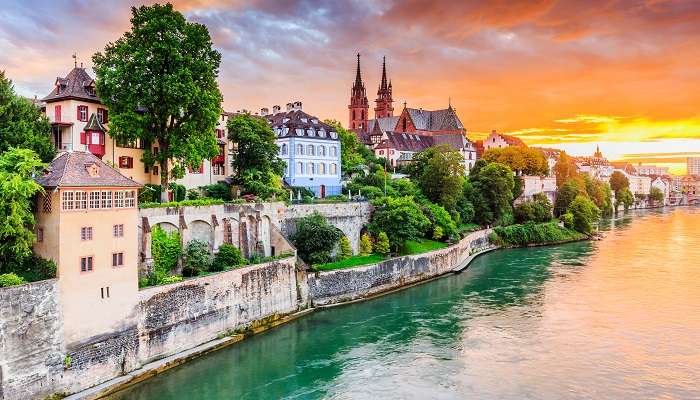
Voici les 26 meilleurs endroits à visiter en avril 2024 si vous vous demandez où aller

37 Meilleurs endroits à visiter en mars dans le monde pour satisfaire votre envie de voyager en 2024
Trending Blogs

20 Mysterious Places In India To Visit In 2023 More Bizarre Than The Bermuda Triangle

10 Scariest Roads In India That Are A Driver’s Nightmare

101 Places To Visit In India Before You Turn 30 in 2024

35 Exotic Places To Visit In December In India 2024 To Enjoy A Surreal Vacation

60 Best Honeymoon Destinations In India In 2024

95 Best Honeymoon Destinations In The World In 2023 For A Romantic Escape!
Best Places To Visit In India By Month
Best places to visit outside india by month.
- TravelTriangle
- Travel Tips »
- Tour Packages
- Honeymoon Packages
- Family Packages
- Budget Tour Packages
- Luxury Tour Packages
- Adventure Tour Packages
- Group Tour Packages
- Kerala Tour Packages
- Goa Tour Packages
- Andaman Tour Packages
- Sikkim Tour Packages
- Himachal Tour Packages
- Uttarakhand Tour Packages
- Rajasthan Tour Packages
- Tour Packages From Delhi
- Tour Packages From Mumbai
- Tour Packages From Bangalore
- Tour Packages From Chennai
- Tour Packages From Kolkata
- Tour Packages From Hyderabad
- Tour Packages From Ahmedabad
- Kerala Tourism
- Goa Tourism
- Sikkim Tourism
- Andaman Tourism
- Himachal Tourism
- Uttarakhand Tourism
- Rajasthan Tourism
- Hotels in Kerala
- Hotels in Goa
- Hotels in Sikkim
- Hotels in Andaman
- Hotels in Himachal
- Hotels in Uttarakhand
- Hotels in Rajasthan
Get expert advice delivered straight to your inbox.
How to Plan a Trip on a Budget
4 Min Read | May 24, 2023

I love planning vacations. I could probably do it for a living if I didn’t have the job I do now.
But vacations can be expensive.
With a little research and budgeting, planning a trip can actually give you a sense of relief and control that makes the getaway much more fun. So, here are seven steps to plan a trip on a budget:
1. Plan your trip budget.
This is the most important step and will affect the rest of your vacation planning process. Determine how much you want to spend on everything from hotels and gas to souvenirs and meals. It doesn’t have to be a ton of money—there are many ways to plan an affordable vacation or staycation.
You can use my free Vacation Budget Worksheet to plan out each category. As you’re planning, if you decide something is too expensive, scale it back or cross it off the list.
2. Choose the top places you’d like to go.
On the surface, this may seem like the easiest (and most fun) part of your planning. But here are some questions you need to ask:
- Which destinations fit within my budget?
- Does my destination affect whether I plan it myself or hire a travel agent?
- Will I drive or fly?
Did you know a bunch of popular U.S. cities actually have a lot of free and super cheap things to do? Check out my list of the 10 cheapest places to travel .
3. Research flights and dates.
As you’re planning your trip, know that certain times of the year are cheaper to travel than others. Everyone knows flights will be more expensive around a holiday, but there are lots of other factors that determine how much you’ll pay for that flight or hotel. Do your research, play around with dates, and decide how many days you can afford to be there. I put my top 10 travel booking hacks in this video:
4. Look for deals.
You can find websites all over the internet that will help you score deals on hotels, amusement park tickets, airline travel and so on. Here are some great resources:
- Google Flights
- Groupon Getaways
- Tripadvisor
- Scott’s Cheap Flights
Make sure you look for bargains after you set the budget—for two reasons. First, once you know where you’re going and how much you want to spend, you’ll be able to look for specific savings. Second, it’s a big morale boost to see that you’re coming in under budget when you find a deal.
5. Start saving up.
Here’s where the rubber meets the road! By working and saving up the money now, you won’t have to deal with payments or credit card interest rates after you come home. Use your trip as motivation when you’re pulling a double shift or taking freelance work. Print out an image from your destination (like a beautiful beach or snowy mountain scene) or save it as your phone screen as a reminder of what you’re working toward.
6. Create your itinerary.
As you’re saving up for your trip, you can also start scheduling which days you’ll do what activities. What excursions, tours and sight-seeing will you do? What reservations do you need to make in advance? If you do a lot of running around one day, do you need to block off the next day for some rest and relaxation? I think it’s fun to go ahead and book some things in advance. I love knowing it’s paid for and checking it off my list. Use Yelp or Tripadvisor to research reviews and pricing to make sure you won’t blow your trip budget.
7. Go and enjoy your trip!
Nothing is worse than paying for a vacation for months after it’s over. But if you take these steps to plan and budget ahead of time, you’ll avoid that headache. Then, when you’re on your trip, live it up! Relax and enjoy.
Every savings goal starts with a budget. Create yours today with EveryDollar.
These seven steps will ensure the bills for your vacation don’t follow you home so you can leave the beach at the beach. The reason more people don’t plan this way is because they want the instant gratification. They want to enjoy now and worry about how to pay later. That leads to overspending, and it creates stress and regret.
Vacations are meant to be fun, not stressful. So make a budget and have a plan. My favorite way to budget is with the EveryDollar budgeting app. Start budgeting today for free —and enjoy your next vacation way more!
3-Minute Money Quiz
Want to take control of your money but don’t know where to start? Take this quiz to get a free customized plan for your money.
Did you find this article helpful? Share it!

About the author
Rachel Cruze
Rachel Cruze is a #1 New York Times bestselling author, financial expert, and host of The Rachel Cruze Show. Rachel writes and speaks on personal finances, budgeting, investing and money trends. As a co-host of The Ramsey Show, America’s second-largest talk radio show, Rachel reaches millions of weekly listeners with her personal finance advice. She has appeared on Good Morning America and Fox News and has been featured in publications such as Time, Real Simple and Women’s Health magazines. Through her shows, books, syndicated columns and speaking events, Rachel shares fun, practical ways to take control of your money and create a life you love. Learn More.
12 Cheapest Places to Travel in 2024
Are you so ready to get out of town? You don’t have to break the bank to visit these 12 cities. They have lots of free or cheap attractions that will make your heart—and your budget—happy.
15 Cheap Vacation Ideas for the Whole Family
How to take a break without breaking your budget.
Bucket list travel on a budget: Expert tips for airfare, loyalty programs, credit card perks and more
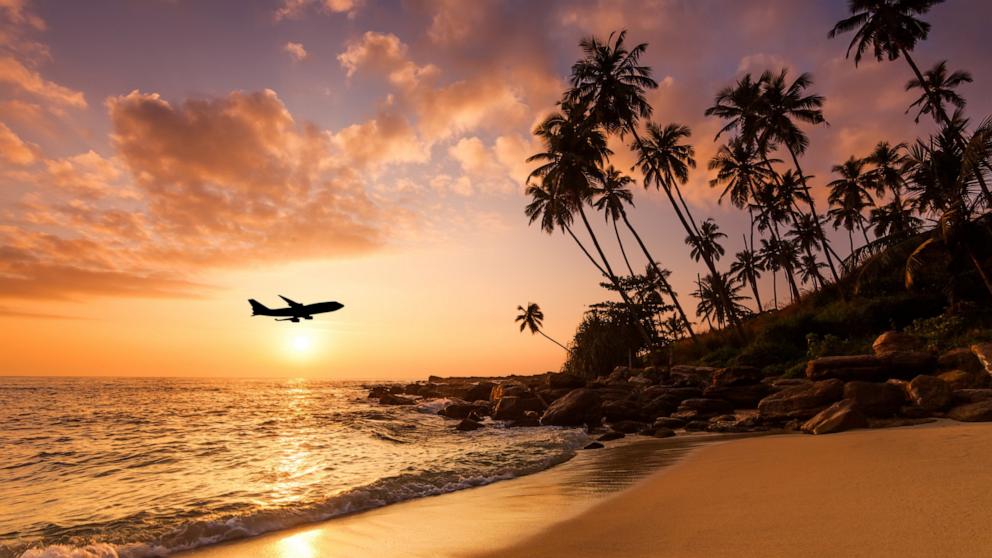
Many travelers have their sights set on summer getaways , but with everything from baggage fees to fuel costs impacting the price of a ticket, "Good Morning America" is asking travel experts to share tips for booking bucket list destinations on a budget and finding savings along the way.
Travel expert Nicky Kelvin, senior director of content for The Points Guy, offered his tips for affordable travel techniques.

Where to find the best flight deals

Kelvin encourages travelers to utilize Google Flights and other free price-tracking tools to compare fare prices and snag the best deal.
He also suggests using both the calendar and map features within Google Flights to see which airports, dates and destinations how the lowest fare.
From the Google Flights homepage on a computer, click "explore destinations" and select a departure city without adding a destination. Then zoom out on the map to see the best prices for destinations all over the world.
Get the most out of free travel loyalty programs
Travelers should be earning points for anything and everything that they are buying or booking from airline and hotels to car rentals, Kelvin said.
In addition to the points that can can help travelers earn free flights and hotel stays, Kelvin said to look for extra perks just for joining.
Hyatt rewards, for example, offers all guests free breakfast.
For Thrifty Car Rental and Dollar Car Rental, he said you can add your spouse or domestic partner as an additional driver for free.
Loyalty programs are great for airlines too. JetBlue, for example, allows enrolled customers -- even if they don't have enough points for a flight -- to use points for discounts. Plus, with any airline, as you accumulate points to earn status, you can get free seating upgrades.
Travel credit cards with cash back perks
Along with earning points, travel credit cards give you protection for your trip like insurance to help with lost or damaged baggage and trip cancellation protection
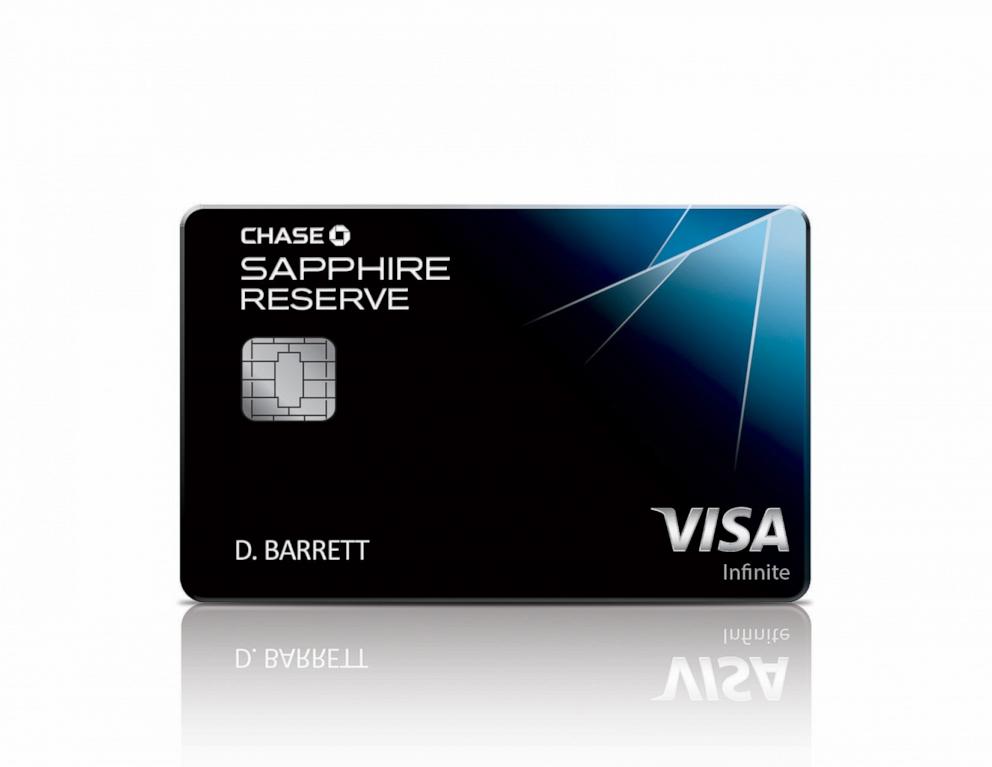
Chase debuts new airport lounge: Gourmet menus, sleek interiors, free facials redefine hospitality for airport travel
As for credit cards, The Points Guy team suggests the Capital One Venture Rewards credit card as an all-around pick -- you get 75,000 miles after meeting your minimum spend in the first three months. Which Kelvin said is a value of over $1,300.
If you're looking to earn the most miles, he said look to the Chase Sapphire Preferred Card.
"You'll earn the most points on all your purchases with this one," he said.
Finally, if you want a credit card with no fee, Kelvin suggested the Bilt Mastercard, which he said is particularly great for renters because you can earn points on what's likely someone's biggest expense.
Editor’s Picks

Airlines required to refund passengers for canceled, delayed flights
- Apr 24, 2024

Google reveals top destinations for summer vacation 2024
- Apr 09, 2024

What to know about new Venice entry fee, other summer destinations with a tourist tax
- Apr 25, 2024
Save money on international phone plans for summer trips
If someone's trip is taking them out of the country, using a cell phone internationally can cost $10 to 15 per day. For a family of four, that's more than $400 for a week.
If your phones support eSIM, Kelvin suggested purchasing a data plan for your destination through an app such as Airalo, Truphone or GigSky.
For example, one of Airalo's global SIM plans costs $9 for one week, which could save a family close to $350 dollars, depending on their existing international coverage.
Related Topics
Up next in travel—.

Southwest Airlines CEO says airline may reevaluate open seating after financial loss
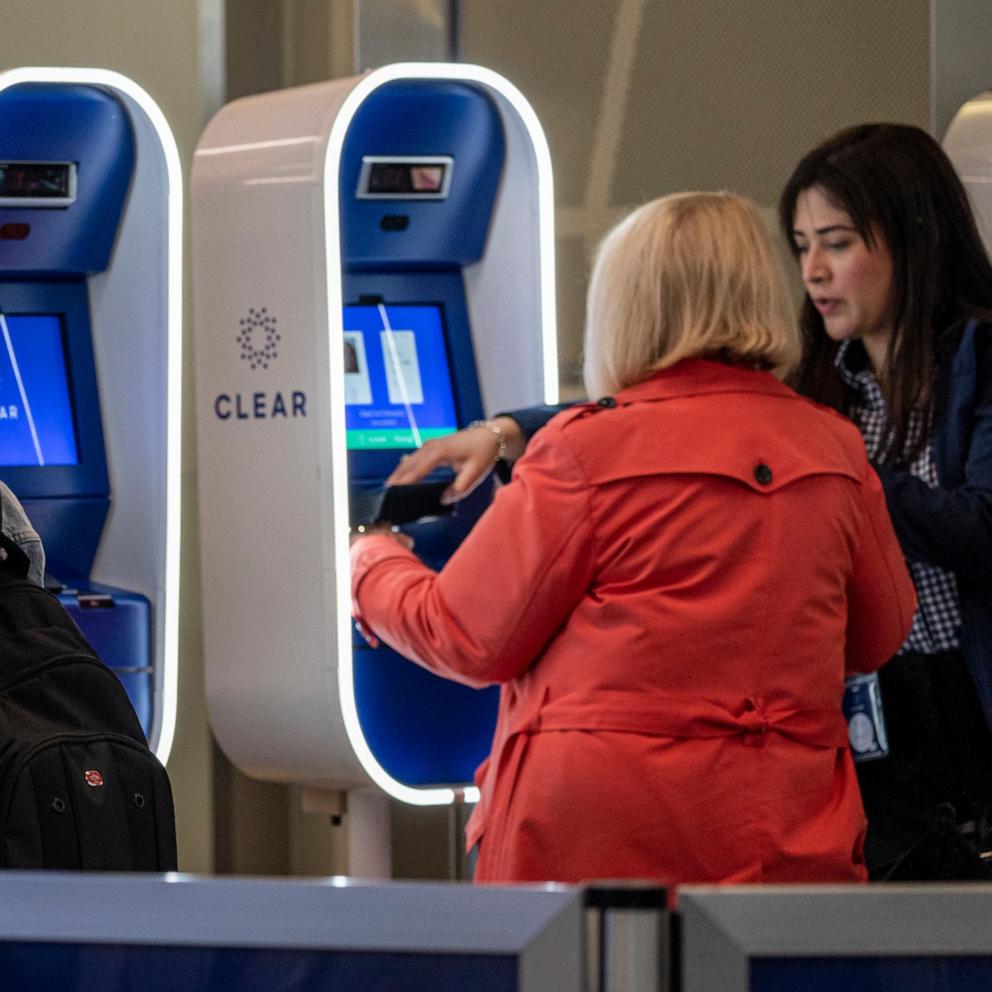
No cuts: Proposed bill could change skipping the security line at the airport
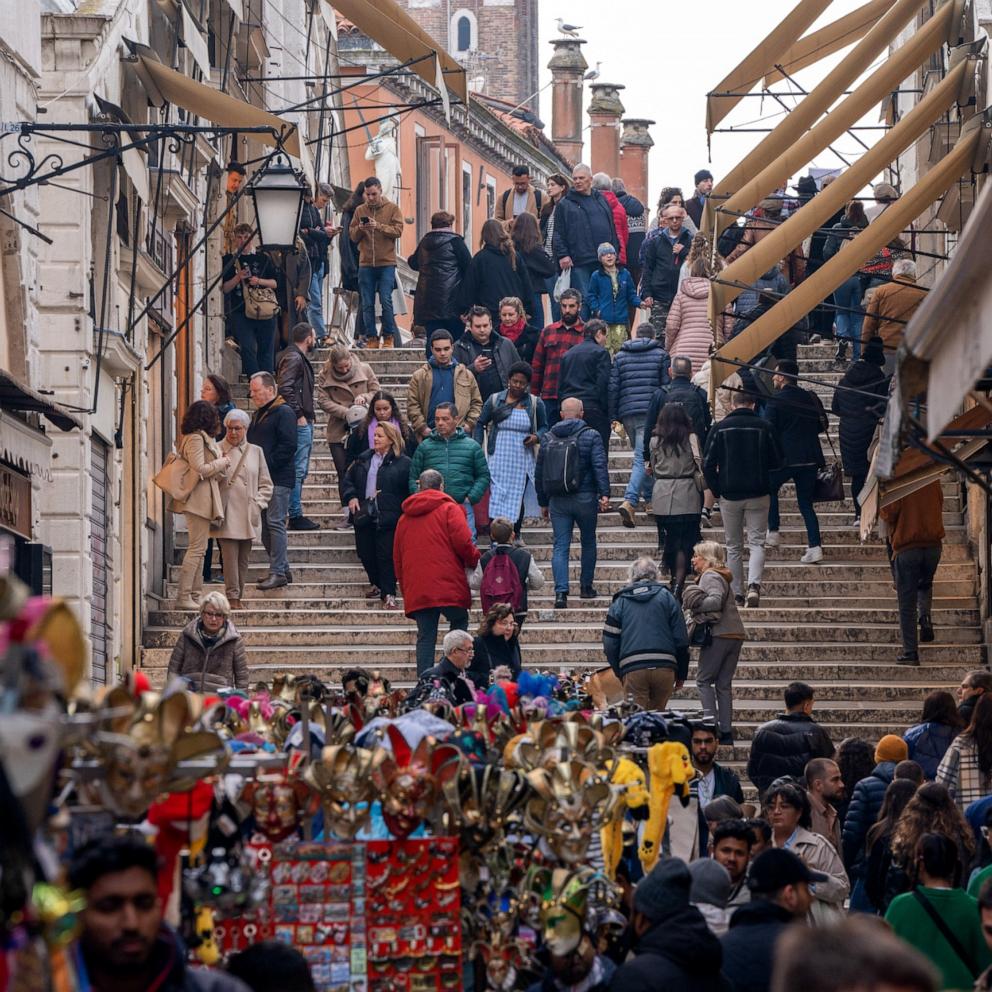
Venice implements new access fees for day-trippers: What to know about the new system
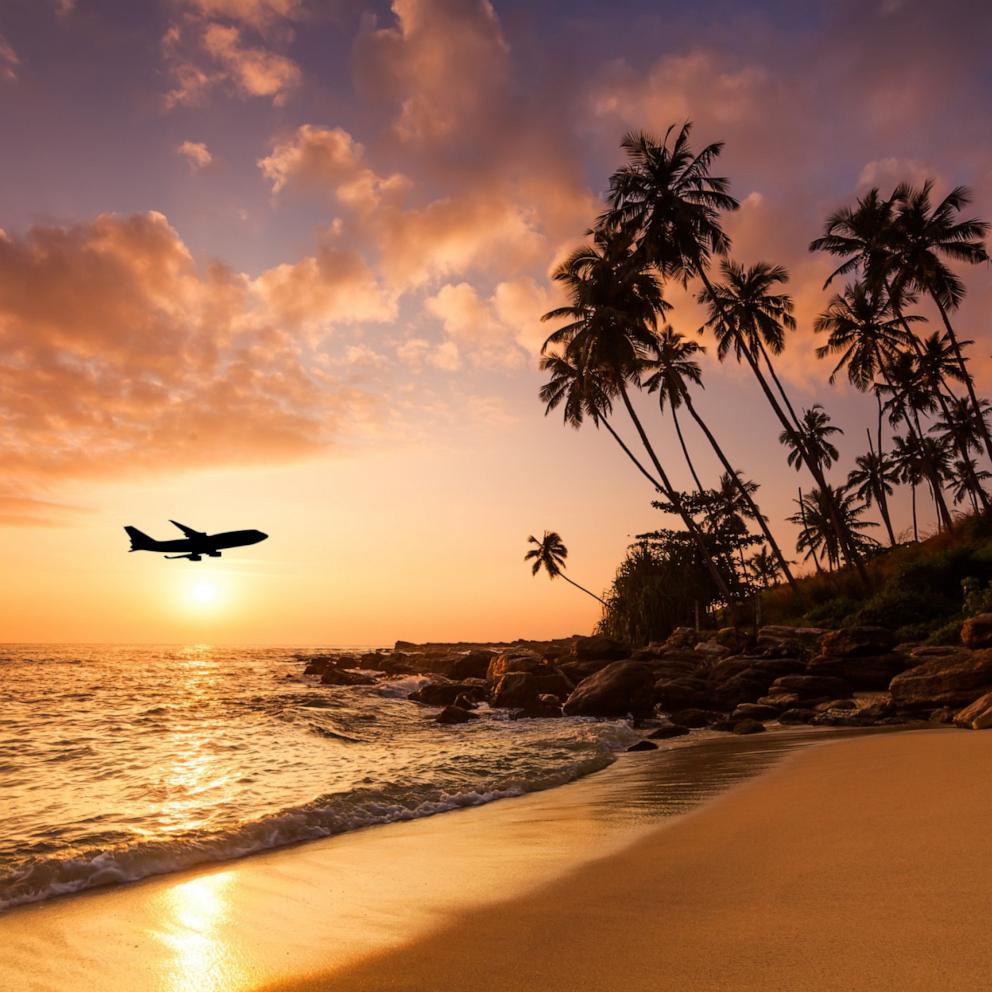
Shop Editors Picks
Sponsored content by taboola.

Our expert deal-hunting staff showcases the best price drops and discounts from reputable sellers daily. If you make a purchase using our links, CNET may earn a commission.
Save on Your Next Trip With These Travel Coupon Deals
Expedia, Hotwire and other popular booking sites are offering great deals on things to do and places to stay worldwide.

Have you been wanting to plan an epic trip for yourself and your loved ones? Now is the time! Planning and booking trips and activities can feel overwhelming and expensive. Fortunately, several top booking sites are offering deals and discounts to help you get to your destination while saving you some money.

Save 25% or more on dream stays
You've probably spent countless hours thinking about your dream vacation, and Expedia wants to help you take the leap. If you book right now, you can save 25% or more on your dream stays. Whether it comes with beach views or forest hikes, you can have your dream trip for less.

Up to 60% off Hot Rate hotel bookings and car rentals
Get up to 60% off your hotel bookings with Hotwire's Hot Rate, allowing you to get "4-star hotels at 2-star prices." You can also save on car rentals if you want to explore life outside the resort.

Booking.com
Spring has sprung on Booking.com. If you book a stay that takes place between now and September 30, you can save 15%, including getaways to Cancun, Orlando and Panama City. The promotional period ends May 30, though, so make any plans before then.

10% off for members
Sign up as a member on Hotels.com and save 10% off your bookings. Your stay is also fully refundable up to 24 hours before your trip in case life happens and you aren't able to make it.
Looking for more discounts? CNET has the best deals from Expedia , Hotwire and many others, along with promo code offers -- all updated and verified daily.
Welcome to CNET Coupons , the first stop before you shop, featuring a multitude of deals and discounts from top online retailers. Simply head over to our coupon page and type in your favorite store or brands to find all the deals available for the week.

IMAGES
VIDEO
COMMENTS
Use Wanderlog to share your itinerary with tripmates, friends, and families and collaborate in real time, so everyone stays in the loop. Plan your road trip or vacation with the best itinerary and trip planner. Wanderlog travel planner allows you to create itineraries with friends, mark routes, and optimize maps — on web or mobile app.
The integration with skyscanner and booking.com, and other OTA like priceline and expedia makes it very easy to plan the whole trip along with the bookings in one place. TripHobo trip planner is the best FREE alternative in online trip Planning. Create your itinerary, organize day-to-day activities, book hotels and flights with this smart ...
Keep exploring with the Roadtrippers mobile apps. Anything you plan or save automagically syncs with the apps, ready for you when you hit the road! Plan your next trip, find amazing places, and take fascinating detours with the #1 trip planner. Every trip is a road trip.
Unlike other travel apps, TripIt can organize your travel plans no matter where you book. Simply forward your confirmation emails to [email protected] and in a matter of seconds, TripIt will create a comprehensive itinerary for every trip. "I'm on the road 100 days a year and TripIt is my go-to-app.
Get ready for your next adventure. Sign in to plan better. KAYAK Trips. Your free personal travel assistant. Save your favorite results to track prices before you buy. Organize, manage and share your trip itinerary. Receive real-time flight status alerts.
1. Enter your destination, travel dates and pick your interests. 2. Your itinerary will be compiled using our 1,000s of curated attractions, restaurants and travel advice. 3. Export your itinerary to PDF and have it in your back pocket.
Absolutely! Plan That Trip allows you to invite friends, family, or colleagues to collaborate on your travel plans. They can view, edit, and add to the itinerary in real-time, ensuring everyone involved has the latest information. Collaboration and sharing require a Premium plan.
The best road trip planner offering personalized and customized features that cater specifically to road trips. Easily plan your route, discover unique attractions along the way, and find the best accommodations and dining options that fit your preferences. Offline access to your itinerary makes it easy to navigate even in areas with limited ...
Plan on the go with our free travel app. With Wanderlog's mobile travel planner on Android and iOS, access and edit your trips wherever you go — even while offline. 4.9 on App Store, 4.7 on Google Play.
Plan Your Trip for Free, Empowered by our Local Experts. Use our free planning tool to create a full itinerary within seconds. Get excited and play with the different options to individualize your own trip. Done planning? Use our Navigational Tour Guide to navigate between each day, points of interest, activities, and much more..
Select Your Destination from 1M+ New & popular Tourist Attractions. 2. Select Your Accommodation from 1M+ Accommodations around the Globe. 3. Check Your Budget with In-Built Trip Budget Calculator in Multiple Currencies. 4. Finish Your Itinerary with our Free online Vacation Planner in few minutes. Start Planning.
Step 7: Stay Focused and Inspired. While you get closer to your goal, make sure that you keep feeding your desire to travel. Travel planning can be exhausting and overwhelming — especially if you don't have support from your friends and family (and especially if your trip is still months away).
Go to Google My Maps from your desktop browser. Check the Google icon in the top right corner to make sure you're using the Google account you want to. Click "Create A New Map" and a window will open with a blank map. To give your map a name and description, click the map name ("Untitled Map").
The trick is finding that balance. ( We didn't find it at first on our year-long honeymoon - read about what NOT to pack and learn from our mistakes.) Here's how I plan out what to pack for a trip in advance. Clothes: To plan my clothes for a vacation, I think of the environments I'll encounter on my trip.
Do Google searches for ideas such as "Affordable beach vacations in the U.S." or "best family vacation destinations in Europe.". Consult with travel guidebooks. Once you've chosen your destination for your perfect trip, you're ready to get on with planning your trip. #2. Decide how you want to get there.
Simplify your trip planning with. AI powered itineraries. Pick a date. Generate Itinerary.
Step 3: Look for Flights. Once you have a rough idea of the destination, you can see if getting there would be easy and simple. Which means, booking your flights. While some people use Google Flights, personally I always go to Skyscanner .
Example: You will need more money to finance a 4 month trip when compared to 2 months. It sounds obvious, but the point is to ensure you get the balance right between time and travel funds. Once you establish the amount of time and any specific dates you have to play with, move onto the next planning steps. 2.
Sometimes you crave a vacation — but actually taking one feels out of reach. Maybe you're struggling to find the time or save up the money. Or maybe you just can't seem to launch those plans out ...
Trip Planner is a Google My Maps project that helps you plan your trips and share them with others. You can customize your map with markers, routes, photos, and descriptions of your destinations ...
Our free road trip planner is easy to use. Create personalized trips with multiple stops, automatically divide multi-day trips into manageable days, export to GPS or print directions, import from your favorite tools, edit, share and more.
Travel during the off-season - If you intend to have a vacation that is easy on your pockets, it is vital to travel during the off-season, when the demand is less and prices are not inflated. 3. Travel in a group to share costs related to accommodation and transportation. 4. Travel to offbeat places in the country.
So, here are seven steps to plan a trip on a budget: 1. Plan your trip budget. This is the most important step and will affect the rest of your vacation planning process. Determine how much you want to spend on everything from hotels and gas to souvenirs and meals. It doesn't have to be a ton of money—there are many ways to plan an ...
Keep your whole itinerary and all essential documents in one place. Introducing myplan.travel, the planner you can access offline from your phone.
Many travelers have their sights set on summer getaways, but with everything from baggage fees to fuel costs impacting the price of a ticket, "Good Morning America" is asking travel experts to share tips for booking bucket list destinations on a budget and finding savings along the way.. Travel expert Nicky Kelvin, senior director of content for The Points Guy, offered his tips for affordable ...
Whether it comes with beach views or forest hikes, you can have your dream trip for less. See at Expedia Hotwire. Hotwire Up to 60% off Hot Rate hotel bookings and car rentals